

























You don’t have to be a scuba diver to experience swimming with a whale shark Many surfers and others who go boating beyond the surf can swim with these gentle giants The mermaid, Olivia Symcox, free dives above the beautiful spots on this medium-sized Whaleshark behind the backline off Umkomaas in southern KZN on the way back from a day offshore The day was sublime with clear warm water, and a slight yellowish tinge appeared in its shadow, which was actually the sandy bottom below the shark. Shot on Nikon D300, 10,5mm fish eye lens, f9 1/320sec iso400 using natural light

Nicolene Olckers
Dennis Guichard
Madelein Wolfaardt
Jill Holloway Jenny Jay Stephen Frink
Kelli Cuppett
Christine Tamburri Wally Endres
Michael Menduno
Jim Gunderson Guy Thomas Audrey Cudel
Claudio Di Manao
Dr Sara Andreotti
Frauke Tillmans
Bevin Reynolds Francois Burman Ben Strelnick
DAN Medical Team
Page 38 - The Maldives
Dr Frans Cronje
Morné Christou
Nicolene Olckers
Page 33 - Wrecks of Northern Mauritius
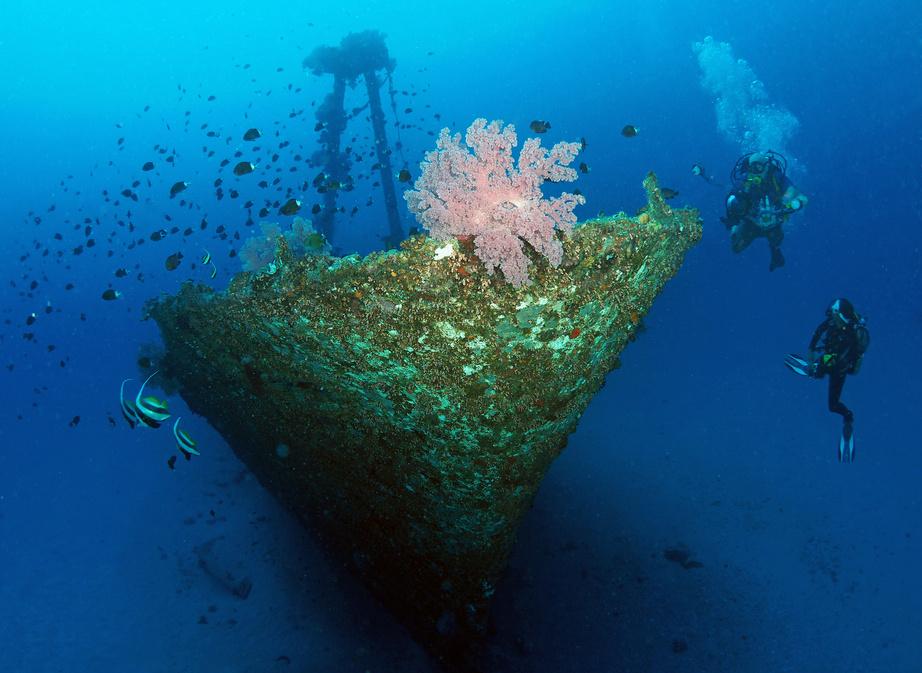
| Text by Jill
Jenny Jay | Wide-angle photographers have a fantastic selection of wrecks to shoot in Mauritius. The wrecks a simply amazing and make for spectacular photography opportunities in the clear waters of Mauritius
A WONDERLAND OF MANTAS AND MORE | Text & photos by Stephen Frink | Gaze upward into pale blankets of manta rays and revel in the multitudes of sharks, fish, anemones, and other dwellers among the healthy reefs of this archipelago that barely peeks above the sea’s surface Photo donated to DAN by Andrew Woodburn

and professional divers and lots more.
When DAN was founded in 1980, injured divers faced significant delays in receiving treatment tailored to their needs Few physicians were trained in dive-related injuries, and the recompression chambers available at the time could not treat recreational divers. The establishment of the DAN organisation offered improved access to medical care and facilities needed by injured divers worldwide
As the organisation gained influence, recreational divers, professional divers, doctors, and medical technicians had access to more information and resources, which helped make diving safer. Over time, DAN has endeavoured to enhance safety for divers worldwide by creating programs like the DAN Emergency Hotline, dive accident membership packages, emergency evacuation coverage, distribution of emergency oxygen, first aid training for the divers
DAN Southern Africa works to bring quality programs and services to divers around the world, including South Africa, Swaziland, Lesotho, Namibia, Botswana, Zimbabwe, Mozambique, Angola and Zambia Of course, the needs of divers are different in each of these countries DAN has the resources and partnerships necessary to reach every diver in need - with a language capability for everyone and local knowledge about health systems
With knowledge, hard work by all stakeholders, and the participation of divers worldwide, we can promote safe diving practices. We'll work with our representatives and contacts worldwide to reach more divers through e-newsletters, social media, webinars, and Alert Diver magazine
DAN is currently working with dive agencies across the DAN Southern Africa region and will continue to work with recompression chambers Chambers will be provided training and assistance as needed and become members of the DAN's Recompression Chamber Network

Around the World with DAN FROM THE SAFETY STOP Perspectives
DAN trains medical professionals to treat dive accidents Topics include decompression sickness, arterial gas embolism, pulmonary barotrauma, ear and sinus barotrauma, marine life injuries, gas toxicity, and managing injury in remote areas.


Beyond providing physicians with much-needed insight, this course also strengthens our relationships with them, increasing the likelihood of them reaching out for support when needed. Many physicians who participate in DAN courses become members of the DAN Physician Referral Network, substantially increasing its reach and enhancing our ability to quickly connect injured divers with doctors experienced in treating decompression illness
DAN is behind all of the valuable services we offer to our members We partner with agencies in Southern Africa and find that our global collaboration is stronger than ever. DAN members from different regions can access the 24/7 DAN Emergency Hotline, Alert Diver magazine, the DAN medical information line, and DAN's online health and safety content library
 Morné Christou Chief Executive Officer
Morné Christou Chief Executive Officer
Since the onset of the COVID-19 pandemic, the world has changed irrevocably The travel limitations have caused tourism worldwide to grind to a virtual standstill. Divers and dive operators have experienced this palpably as even their more adventurous clients stayed home.
At DAN Southern Africa, the economic and marketing consequences have impacted our membership, industry partners and the larger dive community in our region We are not out of the woods yet
On a more cheerful note: What better way do we have to get in touch with our members and business partners than to go on a round trip to visit them – personally? The primary purpose of the excursion was to connect with the various dive centre
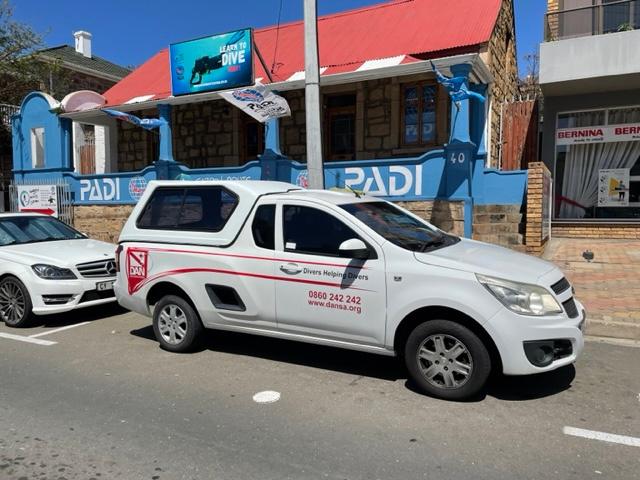
owners, dive staff and divers to introduce the new DAN Southern African promotional brochures. On our round trip, we also enquired about their experiences promoting DAN and how we could make this more accessible and streamlined It was a massive effort, and all the advice, suggestions and ideas were noted and are being implemented as best we can.
The DAN Promo Roadtrip took off in top gear with our first stop in Mosselbay, Western Cape, in South Africa. We hit the ground running and even had an opportunity to go SCUBA diving. First was a visit and meeting with Reel van der Merwe at Garden Route Scuba Situated on the main road of Mosselbay, the bright blue painted building certainly makes for a significant landmark. After a most constructive meeting to discuss the DAN promotional materials and how they use them, we moved on to meet the team of divers and researchers based at Go Dive Mosselbay. Elton Polly’s enthusiasm was infectious, and we were soon roped into a dive Conditions weren’t ideal at the Point site, with the visibility down to about 2 meters and very silty, so we cut the dive short to wait for better weather conditions. Thereafter spending time with Leanne Walmsley and her son Josh at Electro Dive.
As we continued Eastward on the famous Garden Route, we made several more stops at Pro Dive in Plettenberg Bay and Pro Dive in Gqeberha (Port Elizabeth), Mike’s Dive Shop and Elite Scuba We also met with DAN Instructor Gregory Driessel to discuss DAN Training, materials and registration procedures. One of the most exciting visits in Gqeberha was a tour of the Bay Hyperbaric Medicine Facility. The professional medical staff are based at the Marine Sciences Centre of Nelson Mandela University



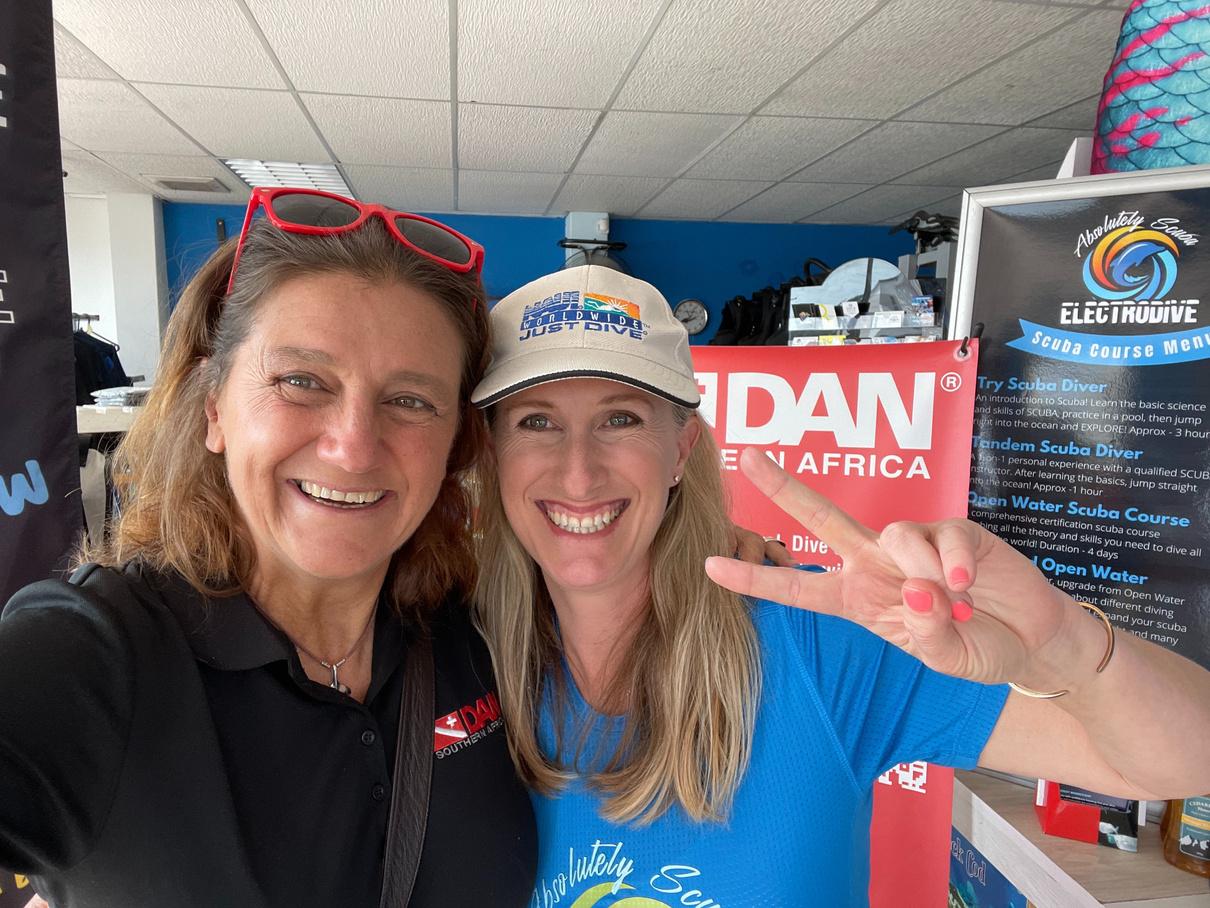


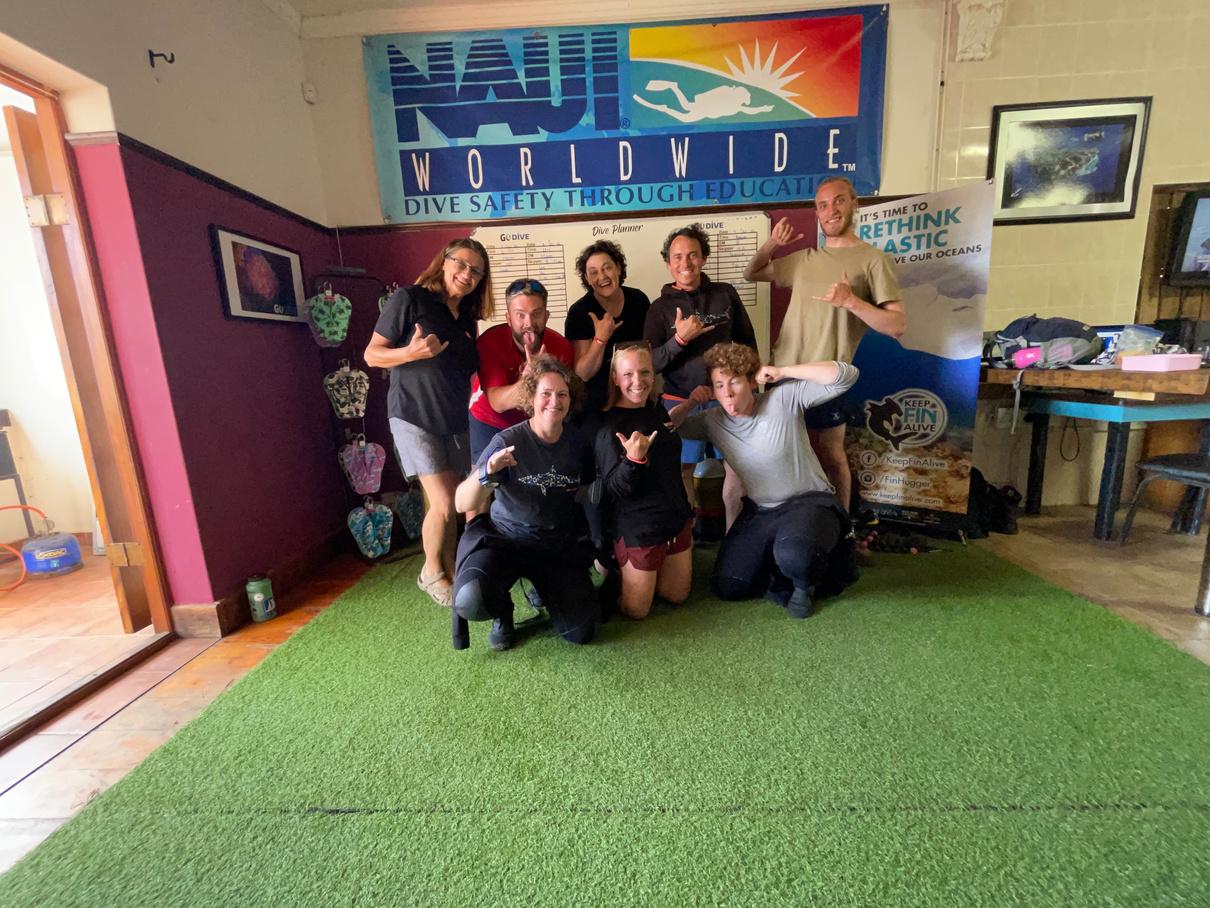
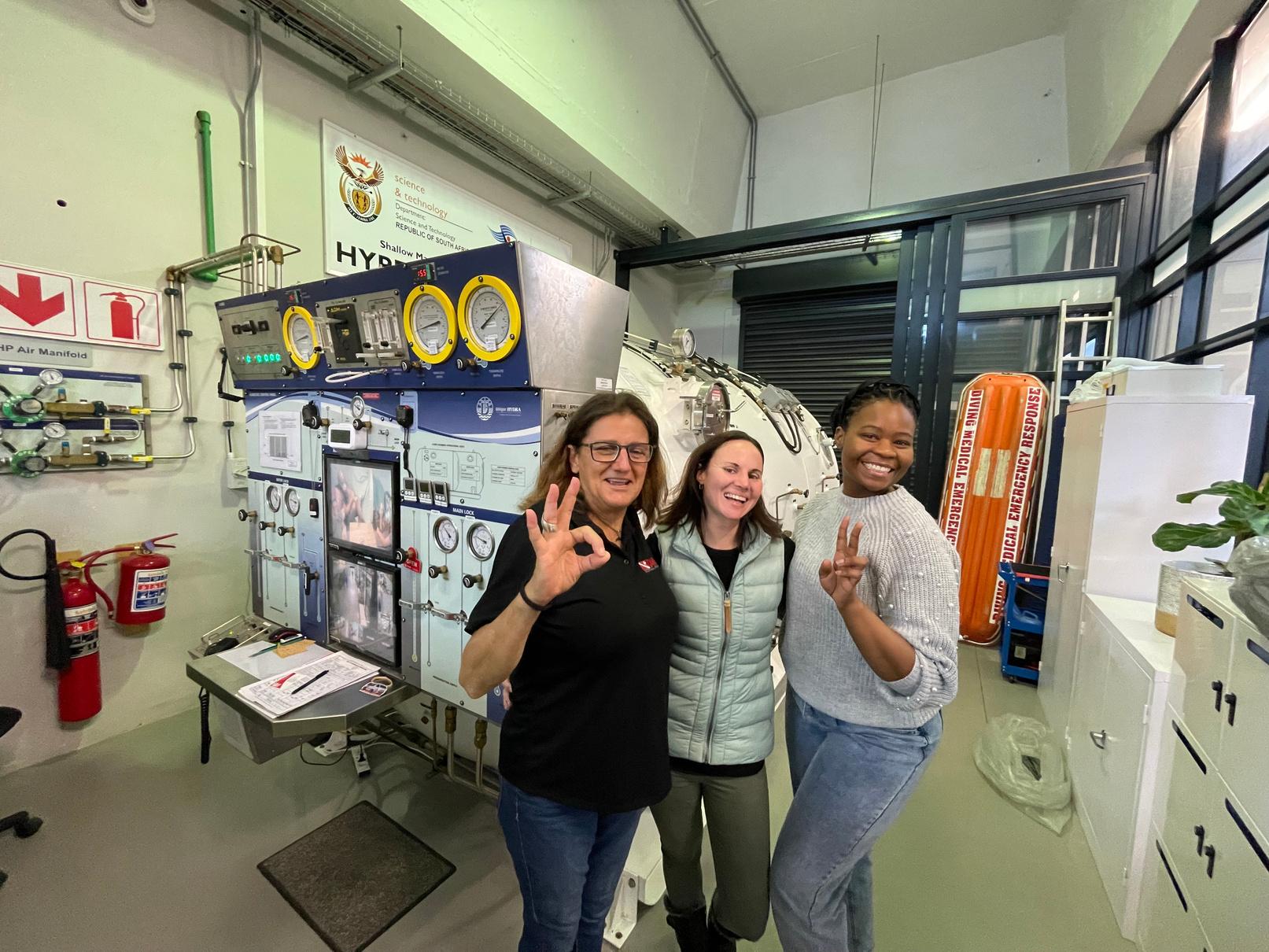
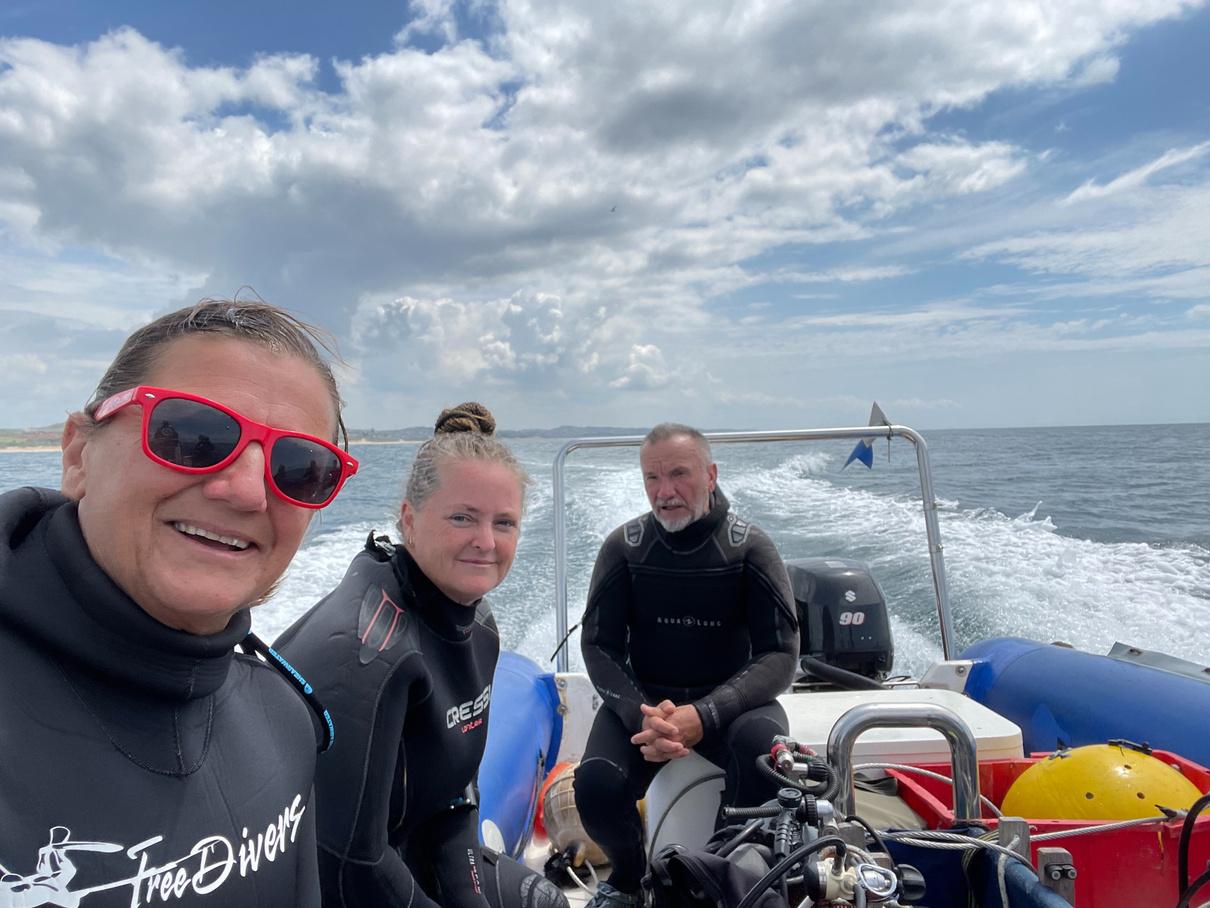
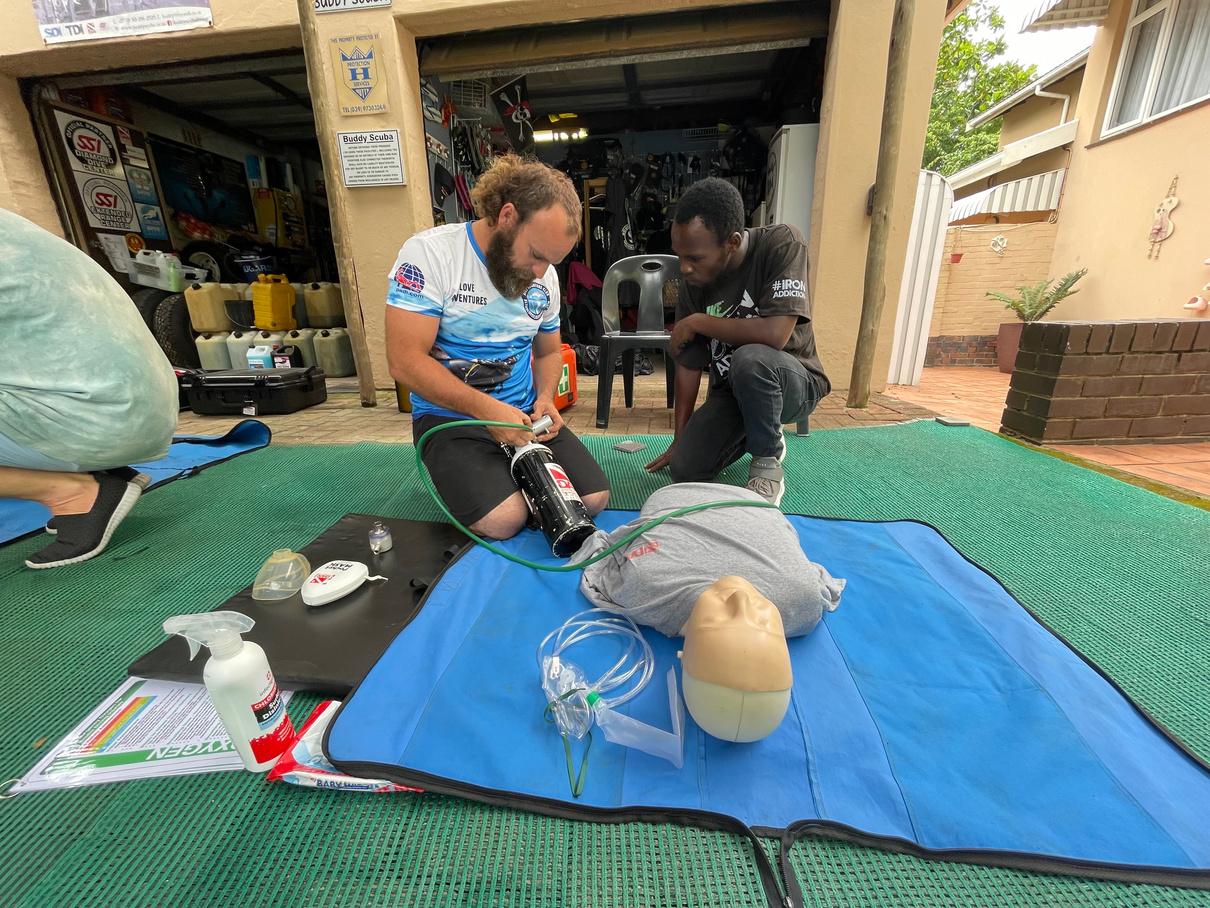
Then we took the long drive to Shelly Beach, Scottburgh and Umkomaas with its revered shark diving destination – Aliwal Shoal reef. The warm, clear waters of the Indian Ocean and the phenomenal shark sighting made the 13-hour drive worthwhile Our meetings here were also characterised by plans and excitement about the coming summer-month dives and the 2023 Sardine Run. The latter usually starts around May and lasts until the end of August. The event attracts local and international divers and professional underwater photographers from around the globe. It is a powerful income booster for most South Coast dive operators.
Meetings

out to dive sites and return us safely to shore.
On the return journey, we were joined by the CEO of DAN Southern Africa, Morné Christou, for a few action-packed days to present a series of Oxygen First Aid for Scuba Diving Injuries workshops to the operational staff of the different dive centres. These workshops were presented to all dive staff to refresh their oxygen skills and knowledge. For some, this was the first time they got to practice these skills. It was heartwarming to witness their enthusiasm and determination.
about DAN membership, managing emergencies and streamlining the DAN online application and renewal processes were crucial talk topics. Discussions with Agulhas House, Blue Ocean Dive Resort, Aliwal Dive Centre, ScubaCo Dive & Travel, Buddy Scuba Diving Adventures, Wetu Safaris, African Watersports, ScubaXcursions, Aqua Planet Dive Centre and Charter and African Dive Adventures provided more insight to their engagements with DAN We also managed to enjoy underwater excursions and shark adventures. We are grateful for the time and effort to take us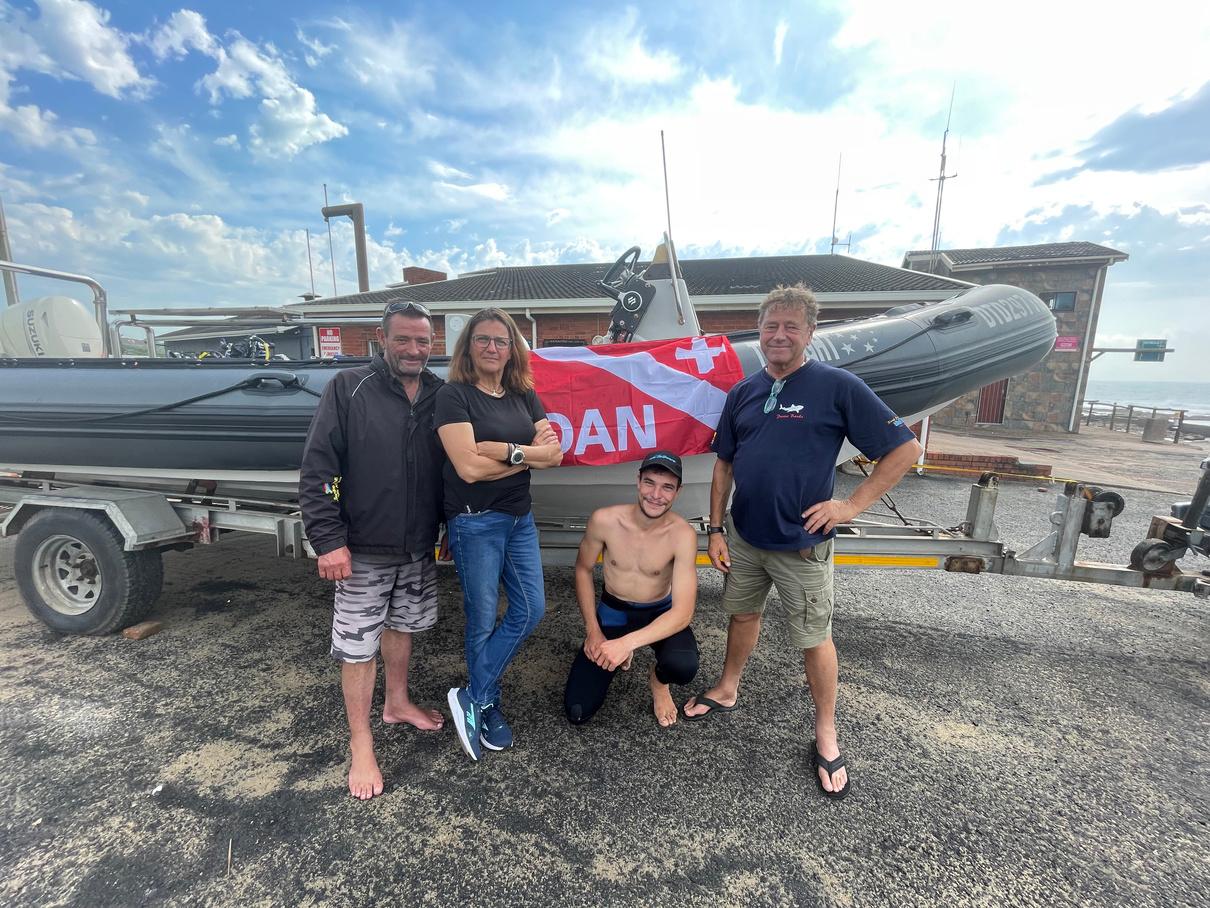


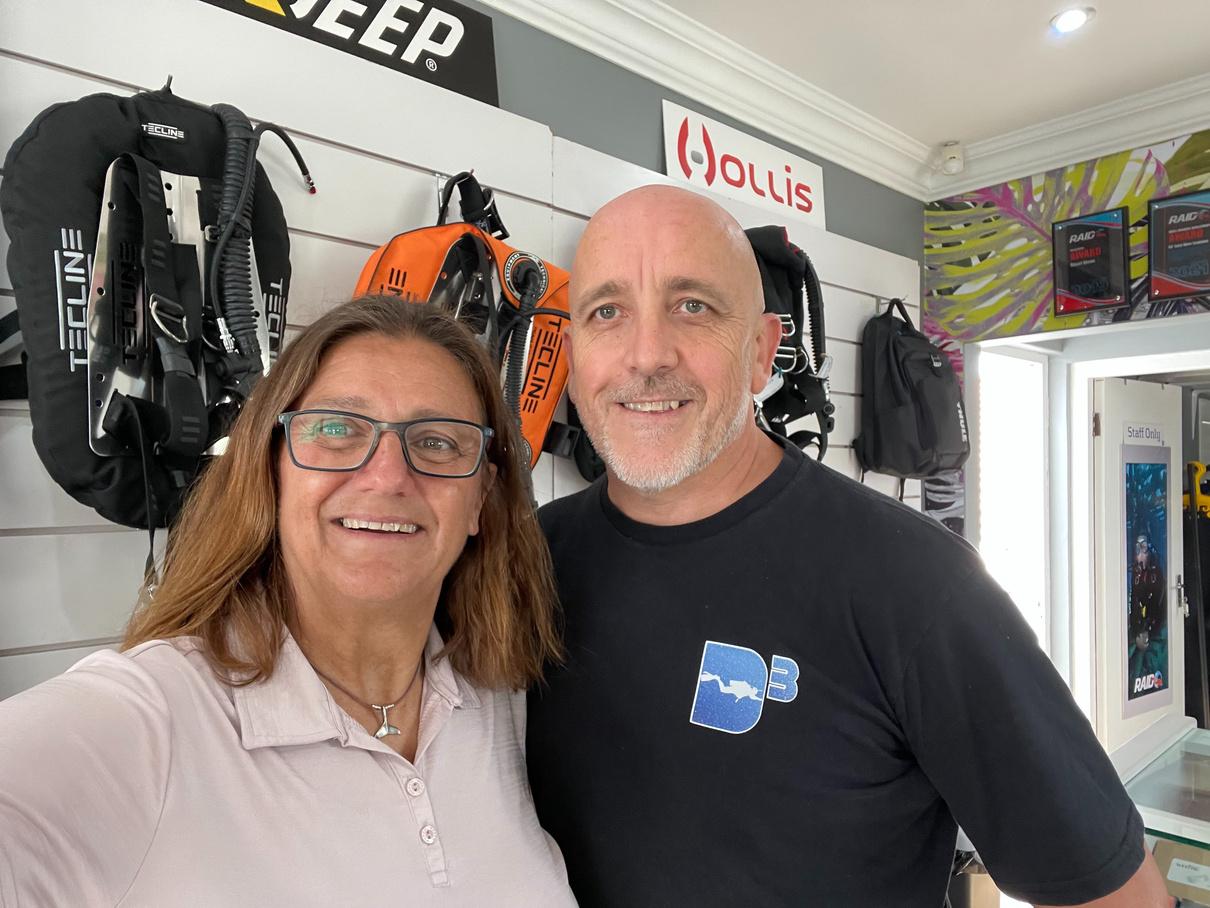
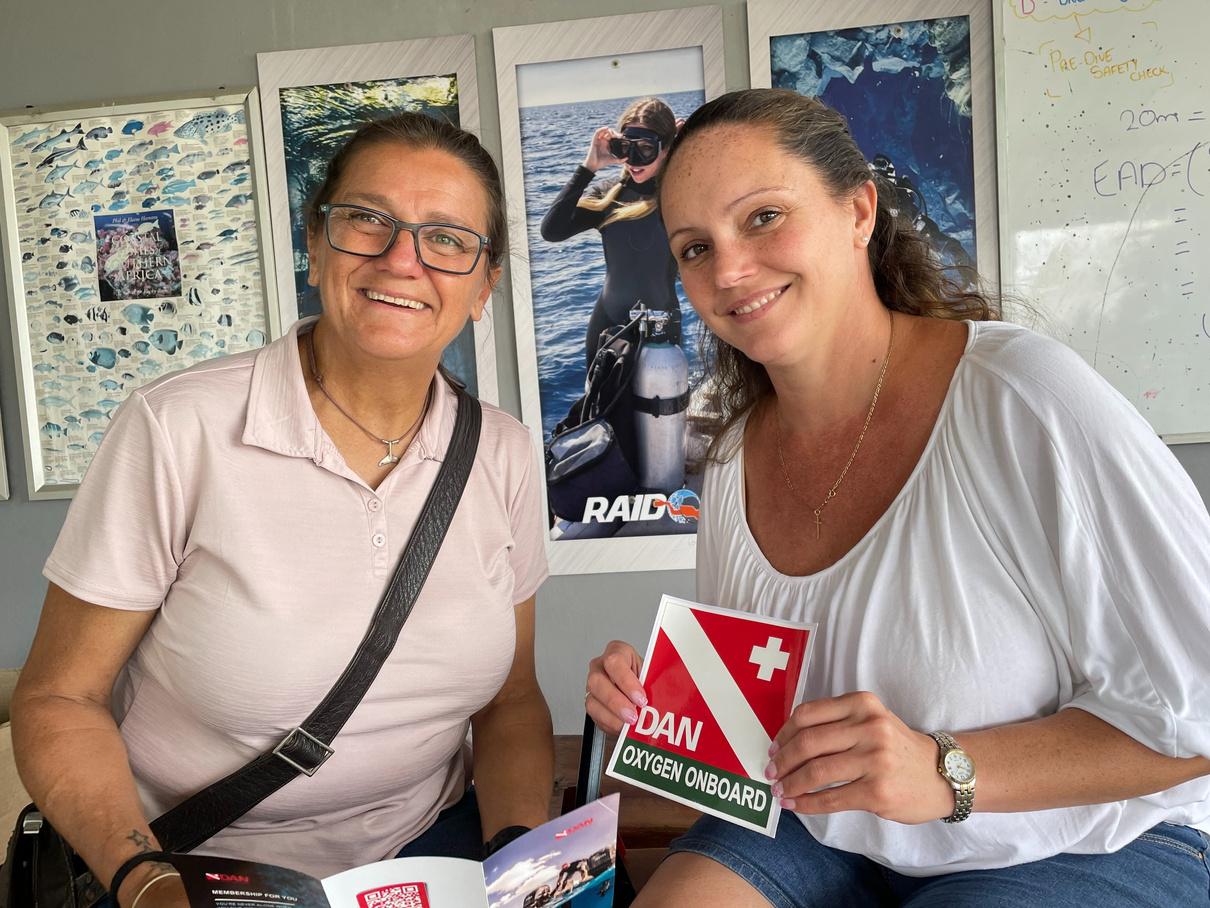

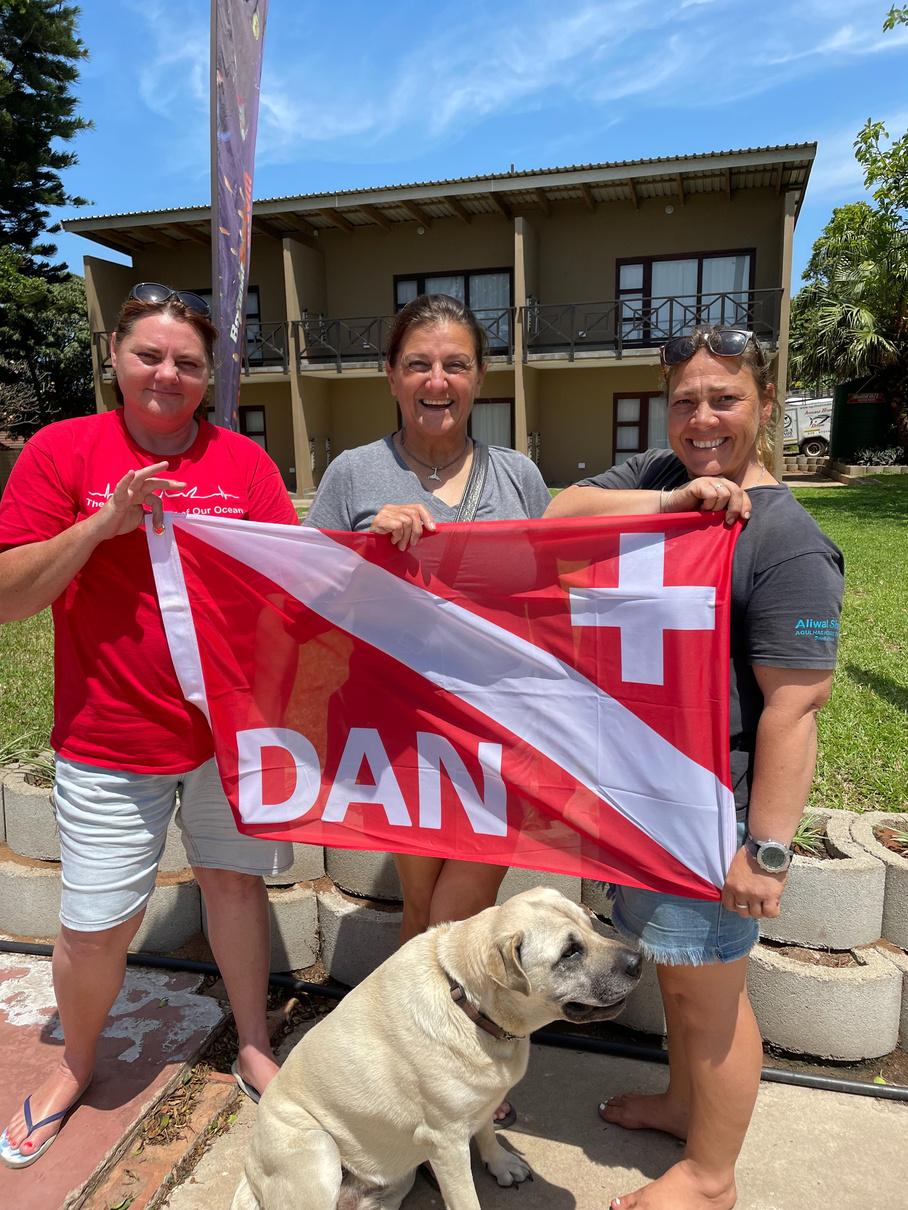

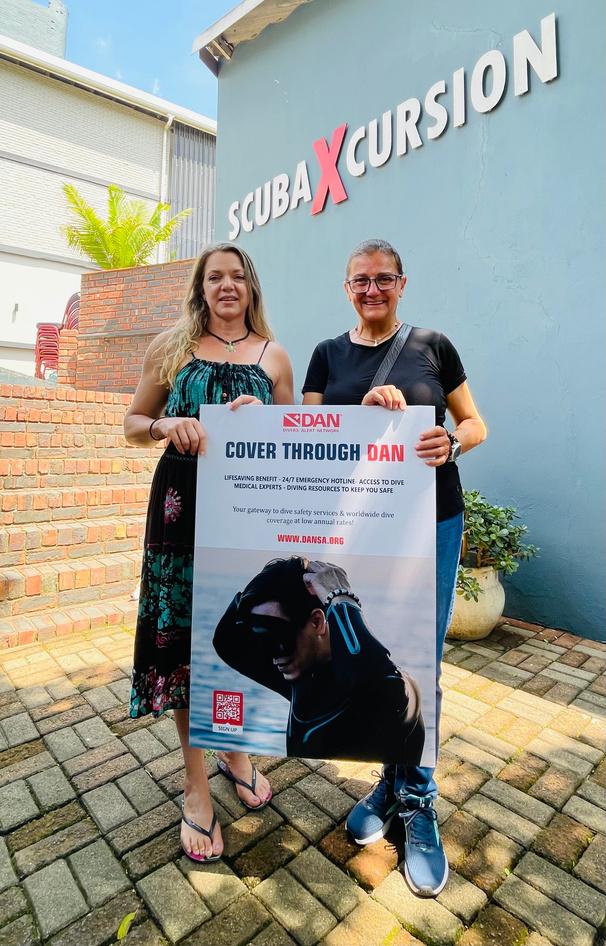
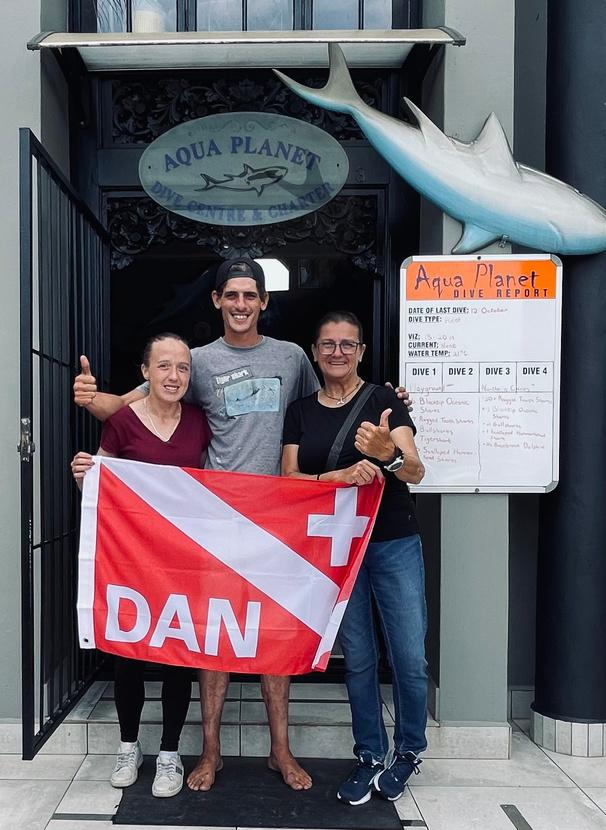
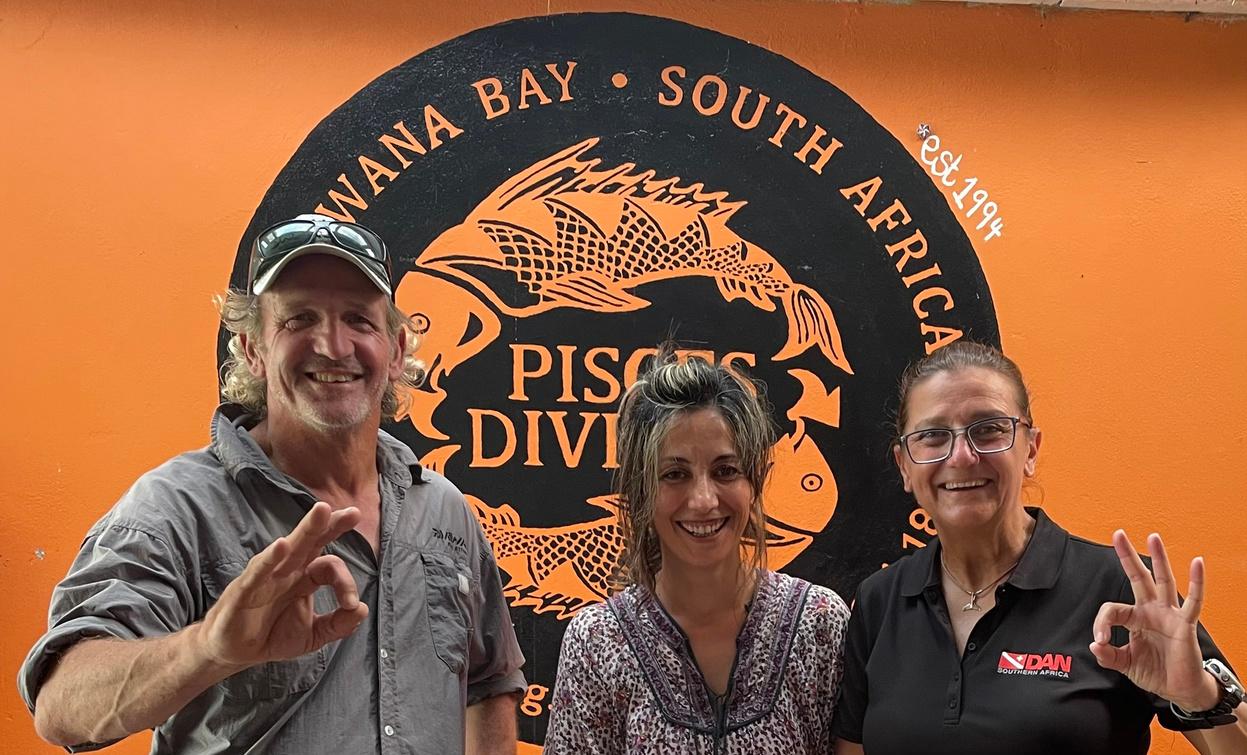


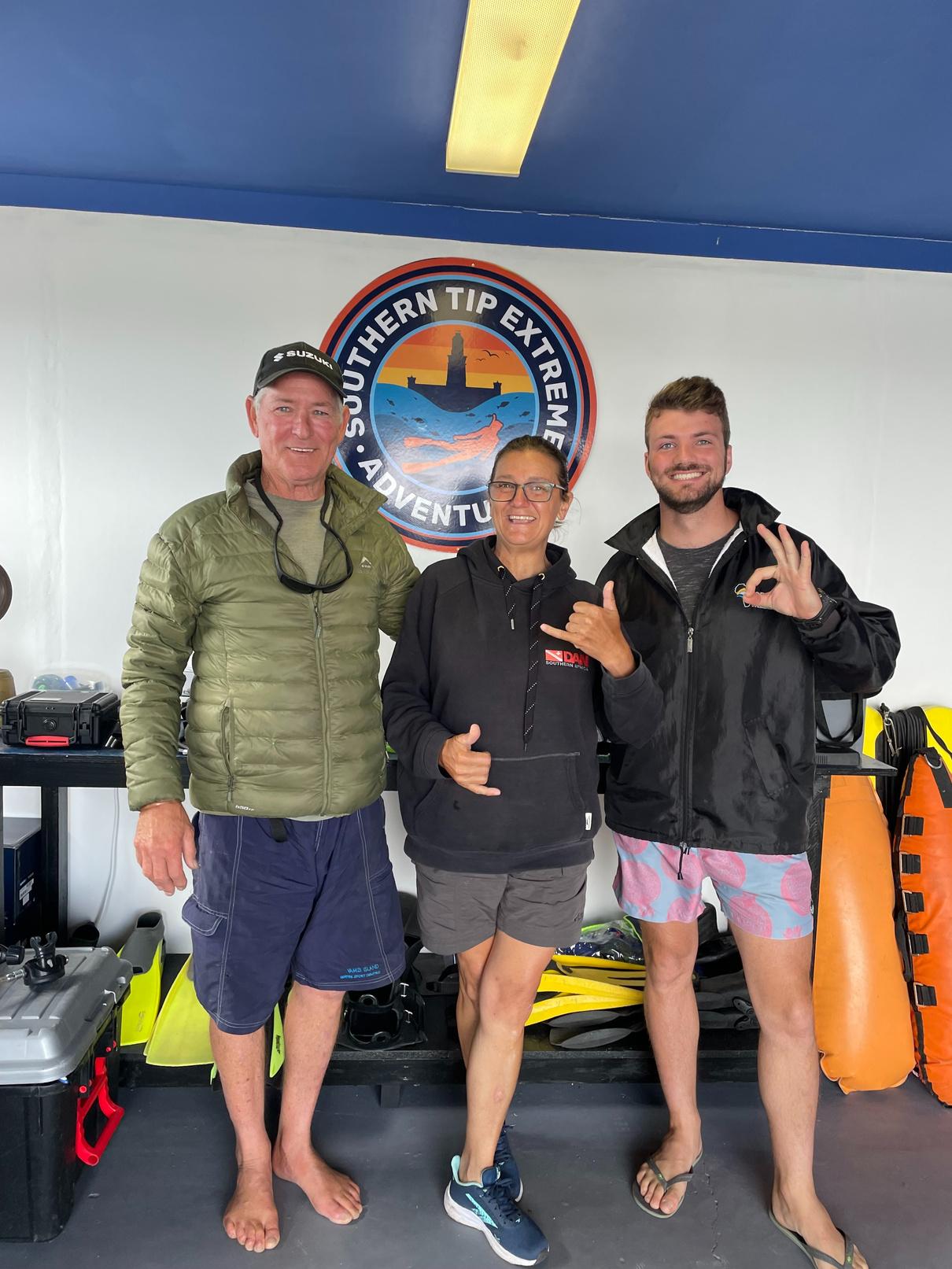
We visited Vinayak Maharaj of Umhlanga Scuba in the cosmopolitan city of Durban. The E coli pollution on the Ethekwini beaches made it almost impossible to dive on nearby reefs. Vinayak said he has been fortunate to have access to diving in the UShaka Marine World tanks with his clients, allowing them to have a unique experience while learning to dive We also met the man behind D3 Total Diver Evolution, Stuart Skene.
We then headed north on the KwaZulu Natal coast to Sodwana Bay and iSimangaliso Park This Internationally recognised heritage site provided the most fantastic dive conditions We had the privilege of diving with the professional crew from Pisces Diving. We encountered a horde of incredible underwater creatures During our visit with the dive operators, we had questions regarding the emergency procedures, the shortage of oxygen supply and further about memberships and promotional materials
Well, we had to return home at some point Fortunately, the long way back to Cape Town saw us surfing into the Surfing Capital of South Africa, Jeffreys Bay or J-Bay, as it is more popularly known Paul van Jaarsveld of JBay Scuba Diving offers scuba diving year-round. We also had the opportunity to do two dives with them. The colder water shocked the system after KZN, but we managed two 45-minute dives before opting for the sunshine on the boat
Further along, we meet the familiar face of Shaun Prinsloo at Stillbay Scuba. We first met Shaun pre-COVID in Mozambique and wished him all the best with his new ventures in Stillbay, Western Cape The last stop on this trip was at the southernmost point of Africa at what must be the most Southerly based scuba diving operation in Africa, Southern Tip Extreme Adventure. It sure looks to be adventurous diving based in the coastal village of Struisbaai
We look forward to joining Stephen Griffiths and Hendri Dunn on some southernmost diving expeditions
In closing, we would like to thank the various dive centre owners, skippers, dive leaders and their ever-enthusiastic, professional diving staff for receiving us and welcoming us into their centres and onto their boats. For sharing their daily lives with us and showing us their resident underwater wonder worlds!
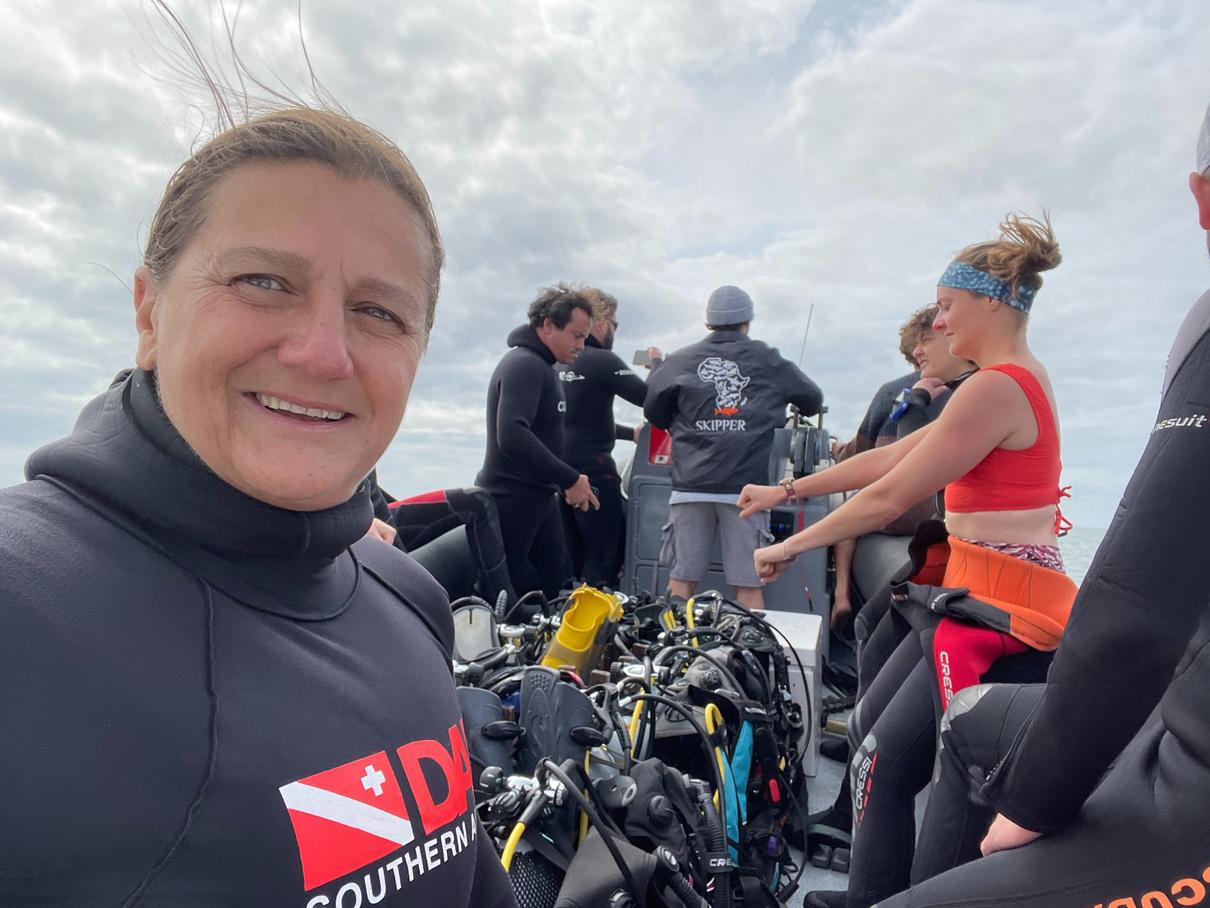

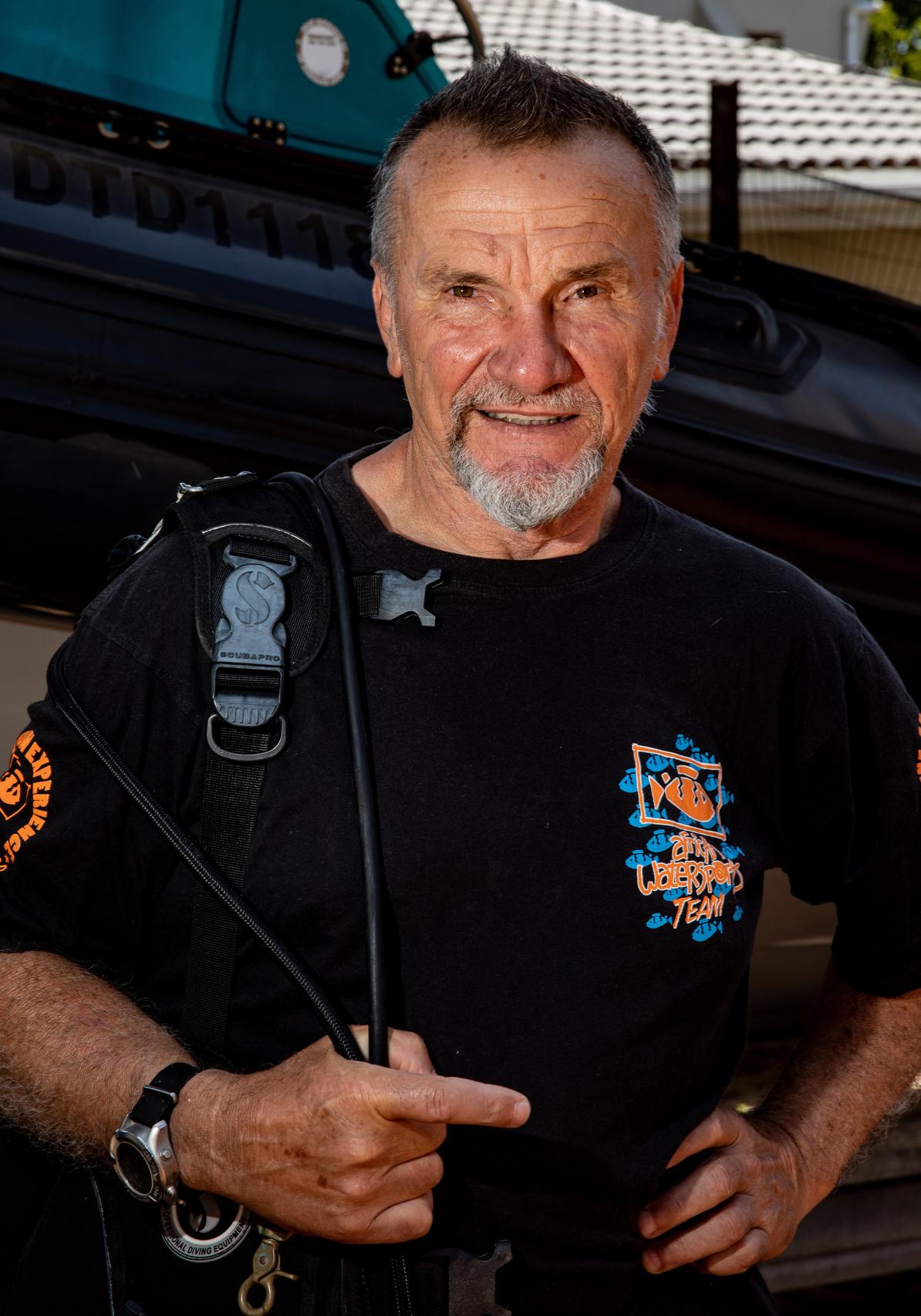
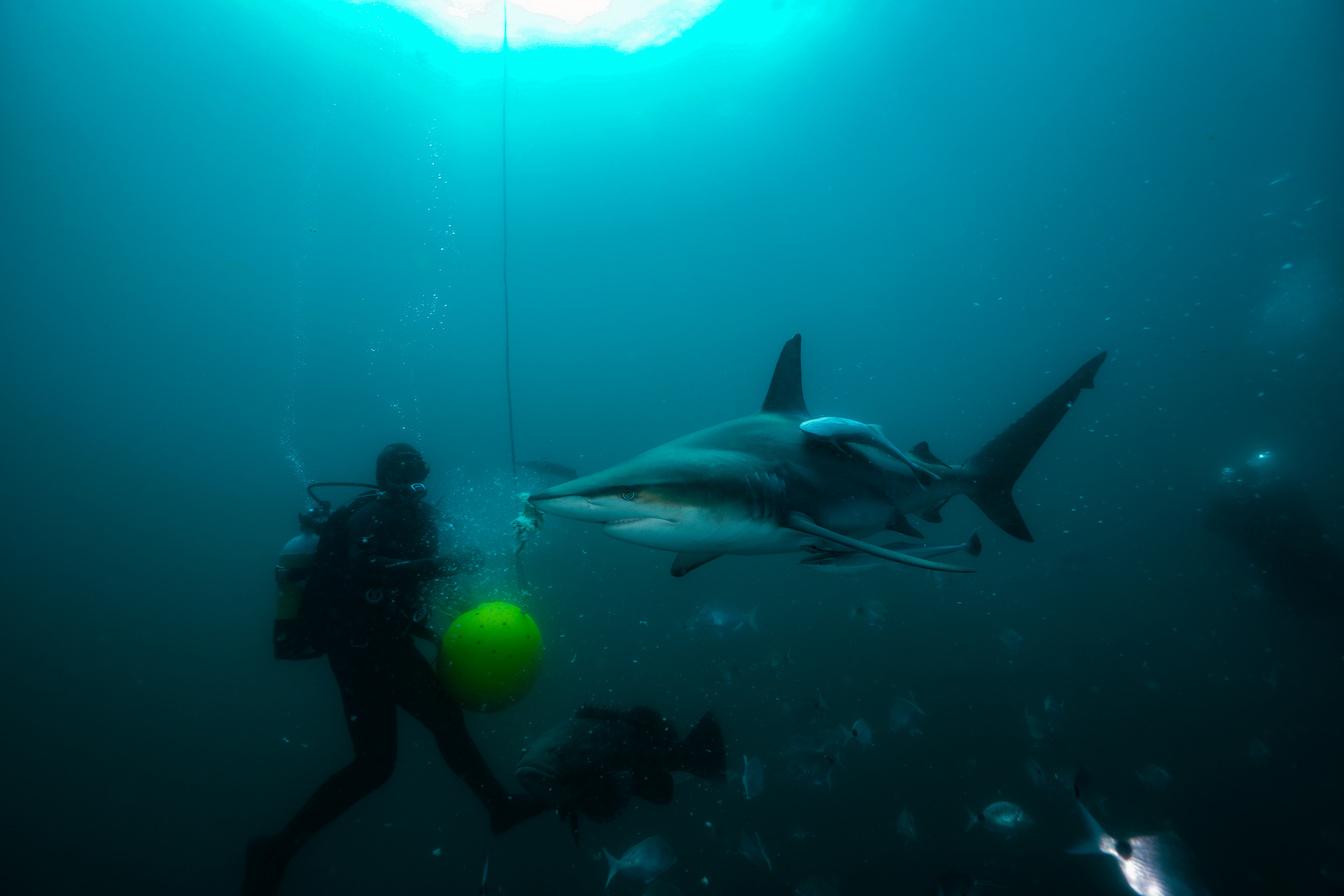

Many international divers travel to South Africa to dive, view and experience sharks underwater One of the preferred destinations is the village of Umkomaas in KwaZulu Natal, South Africa The Aliwal Shoal reef is home to various shark species It is a world-renowned site frequented by shark researchers, divers, and enthusiasts One of the specialists and pioneers of shark diving, Walter Bernardis of African Watersports, is based in Widenham, close to Umkomaas.
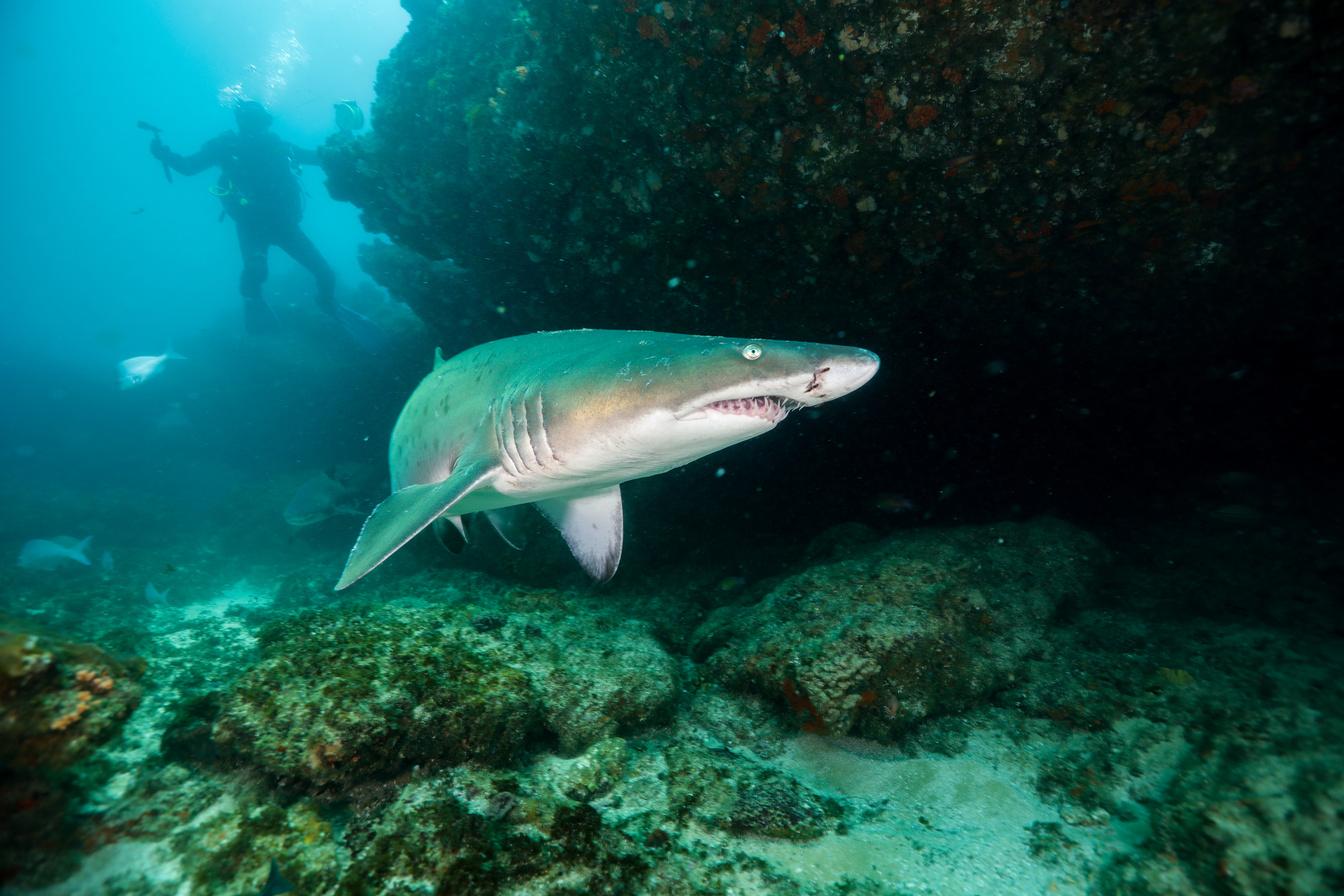
”African Watersports was founded in the early 1980s by the well-known Addison family, Brent, Wayne and Mark, says Walter I joined the Addison operations as a subcontractor in the late 1980s.” African Watersports was always about innovative diving and pioneered the Aliwal Shoal area Most of the innovation was done by Mark as they were the first in the world to offer the adrenalinepacked experience of Tiger Shark Diving commercially, and this included the Sardine Run Walter continued this
legacy when he purchased African Watersports from the Addison family in the 1990s “We are always at the forefront of offering adrenaline-packed diving. From Shark diving to reef and wreck diving off the coast of KwaZulu-Natal, to the Wild Coast for the Sardine run and to Botswana to dive with Nile crocodiles in the Okavango Delta ”
Walter qualified as a teacher and Mechanical Engineer. He pursued a teaching career for 30 years, attaining the position of Deputy Principal at a local Technical High school. “This afforded me the ability to pursue my love of the ocean Having most weekends and school holidays free to the point where I decided to take early retirement and concentrate on running AWS, says Walter. He always loved Sharks, and diving with them safely was his ambition “Tigers have always been my firm favourite. Debunking their myth as mindless killers became my obsession The only way to do that was to bring humans and sharks together.”
Walter’s philosophy has always been to bring people in contact with sharks to show them the beauty of these animals and their vital importance within the ocean’s ecosystem “Because we only protect what we love; we only love what we understand, and we only know what we are taught. Unfortunately, when it comes to sharks, we are only taught fear. He said my goal has been to create this mind shift in understanding sharks AWS is involved in the Shark Wise Project with Dr Sarah Andreotti and the University of Stellenbosch. This takes up much of his time in lectures and facilitating safe diving with the research interns.
“The other is my gut feeling. In his quest to understand sharks and their behaviour, he discovered his way of inducing Tonic immobility in a shark. This allowed him to help entangled sharks and made it possible to remove hooks from them The knowledge of this unique skill has kept him safe from being injured and bitten by sharks. Walter said the other diving participants are briefed extensively and provided with as much information as possible to dive safely with Apex Predators
If there are photographers in the group, they are advised and informed of a few basic photographic concepts, like having the sun behind them and being aware that their
photographic equipment will, in fact, attract the sharks, and they should be prepared for that. “ It has always been our goal to get them “that shot” they are after. We don’t always get credit for it Still, we work hard to create the right setting, platform, and opportunity for photographers to take their best images and videos.” Walter has been a DAN Southern Africa member for more than twenty years. “DAN is the leader in dive accident cover, and they have always been very affordable.
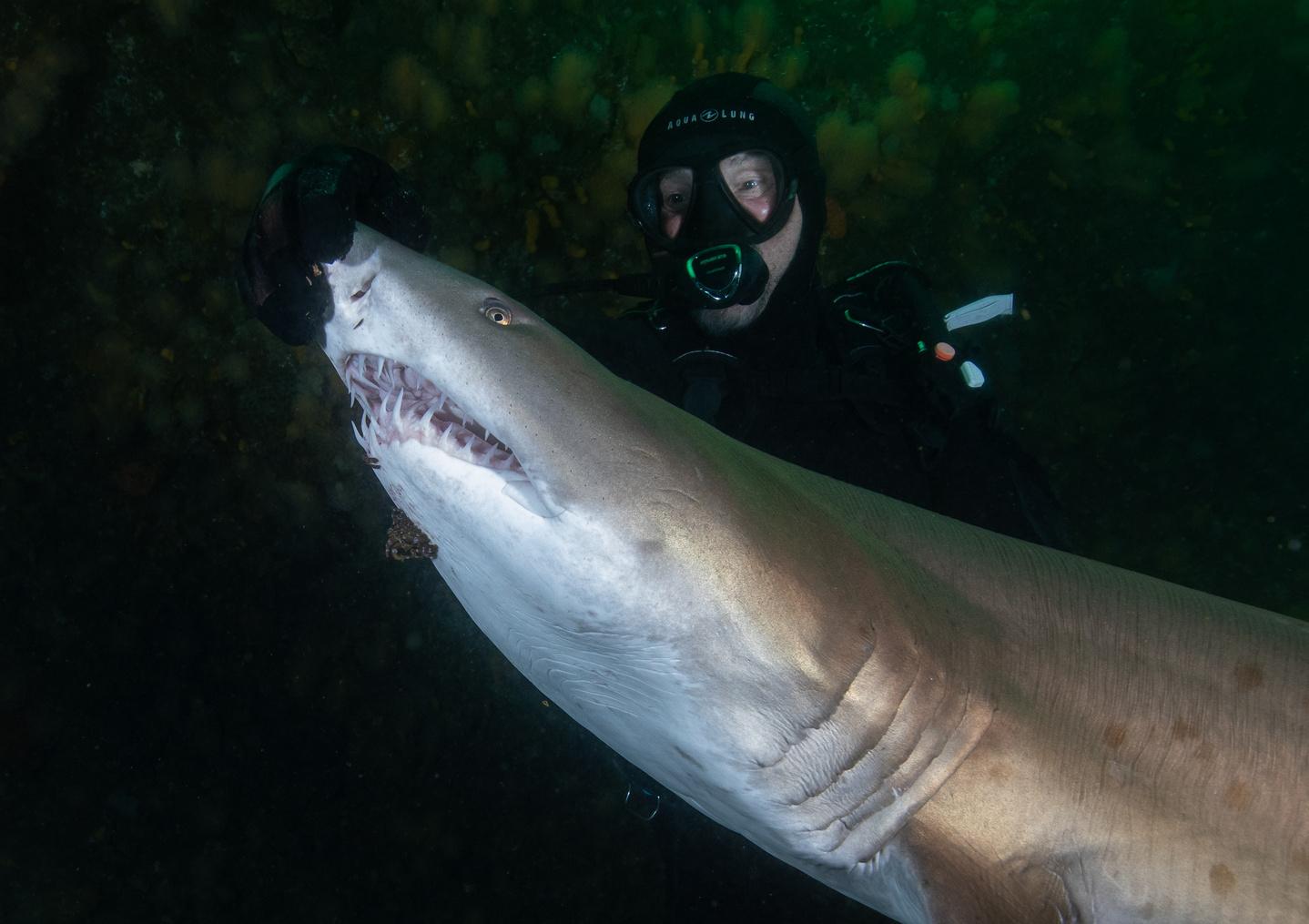
 E X P E R I E N C E T H E T H R I L L
By Dennis Guichard, UHMS Hyperbaric Technologist With edits by Dr Frans Cronje
E S L A T E
E X P E R I E N C E T H E T H R I L L
By Dennis Guichard, UHMS Hyperbaric Technologist With edits by Dr Frans Cronje
E S L A T E
There is so much to be learnt and so much fun to be had, from a 50m chamber deep dive experience that is performed in a safe, controlled manner by diving & hyperbaric specialists who have your ultimate wellbeing at heart, wherever in the world you might get to enjoy the experience of one

Any chamber facility, of course, has a responsibility to plan a safe dive due to current knowledge around decompression sickness and arterial gas embolism risk But whilst we can do everything in our power to plan a safe dive within reasonable limits, there are things outside our control that we can’t ever know about our guests
To be fair, a mathematical decompression algorithm can’t simulate the complexity of the human body perfectly John Scott Haldane believed originally that each of the tissue groups in the body absorbed and eliminated gas independently and exponentially and that bubbles didn’t form until a critical supersaturation limit was exceeded. We now know that this isn’t entirely correct; ALL dives deeper than 6 meters (in saturation) have the potential of generating asymptomatic microscopic bubbles.
So decompression theories have evolved to try and more closely predict how we think bubbles might form and how we might better model decompression physiology.
The original US Navy Dive Tables closely followed the Haldanian bubble hypothesis, although they had a known 30-40% bend rate A newer algorithm released by the US Navy in 1984 known as the Exponential Linear model, developed by Dr Edward Thalmann, assumed an exponential in-gassing rate and more accurately included consideration of microbubble formation slows off-gassing such that the decompression rate would be linear rather than exponential.
A linear off-gassing hypothesis results in a slower ascent rate, longer decompression stops, and a slower surface off-gassing rate. These, i.e., more conservative deco profiles, were safer than previous USN algorithms Following some still-high DCS risk rates, Dr’s Gerth and Doolette published a revised
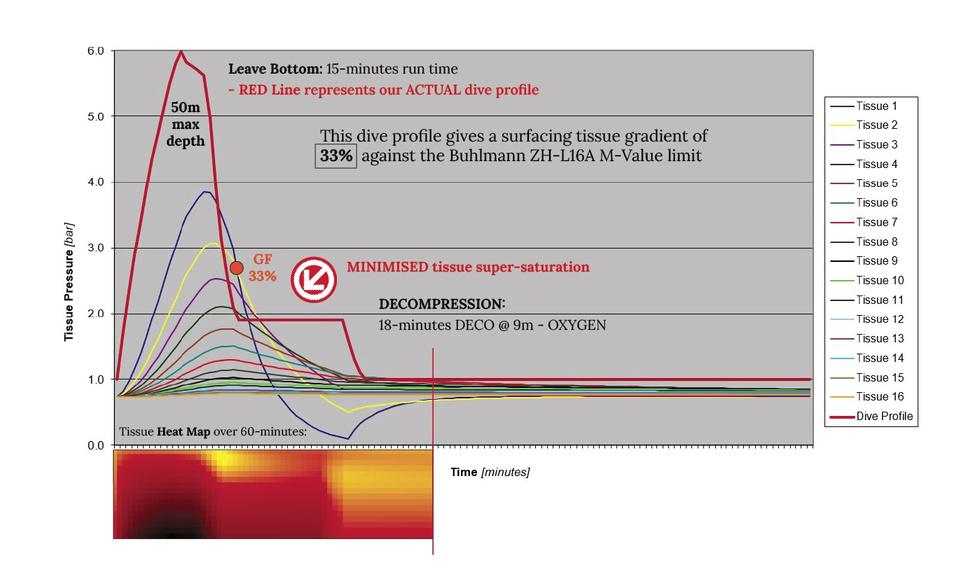
version of the VVal-18 Thalmann algorithms Version 6 of the 2008 USN Diving Manual included new tables for these adapted approaches to minimising DCS risk. Tests by the Swedish navy demonstrated a 10% bend rate with those v6 USN Tables on a series of 40m/20minute dives
A newer Version 7 of the USN Tables, based on the VVal-79 algorithm, was released in 2016, which requires slightly longer deco stops They seem to minimise DCS risk, although high VGE microbubble count is still measured post-dive Bubble loads can take up to an hour post-dive and persist at peak for over 2-hours It’s critical if we rely on the USN Tables for dive planning to ensure we’re always using the most current versions
When I run my Excel spreadsheet tissue super-saturation algorithm analysis over some early chamber dives I did and plot the resultant tissue heat maps, I can see how the air deco profiles (performed in alignment to a now-outdated 1999 Version
4 of the USN dive tables) pushing a 20minute bottom time at 50m, gave me a 70% pure-Bühlmann super-saturation gradient factor in my leading Tissue 3 or instead drove me to within 90% of my typical 85% gradient factor comfort zone limit And what’s surprising to realise is that peak super-saturation doesn’t happen at the surface. Instead, it occurs during the ascent phase just as I approach my first deco stop
Thanks to extensive back-and-forth discussion and dive protocol development with DAN’s leading most senior diving physician Dr Jack Meintjes, as well as with Dr Lyubisa Matity from the Gozo hyperbaric facility (to whom I am both profoundly indebted), we have been able to substantially reduce the risk of these deep dives by shortening the 50m bottom run time to just 15-minutes and also including for 100% oxygen decompression in the chamber to help with accelerated tissue off-gassing

Running and analysing my tissue
saturation spreadsheets for my various previous deep dives, I can clearly see why the newer tables require more extended/deeper deco stops - when the maximum tissue saturation is formed on the ascent approaching the deco stops, it makes absolute sense to stay slightly deeper to limit microscopic bubble size growth so that gas can be efficiently released The off-gassing gradient formed by breathing 100% oxygen in the chamber via our hyperbaric hoods most efficiently helps with nitrogen offgassing, so there is no benefit to ascending shallower when doing oxygen decompression like there is keeping a progressively shallower depth-driven off-gassing gradient high with air decompression.
espite all the safety factors designed into our dive profiles, some risk is still there with these deep dives. We don’t know (and you probably don’t) whether you might have an atrial septal defect or a PFO that triggers an atrial shunt resulting in an arterial gas embolism.
We don’t know the integrity of your blood vessel walls due to your age or due to COVID-19 damage in previous years. So it is always thus critical that a diving physician is present at any chamber dive to assess divers afterwards for any DCS-related symptoms, which can undoubtedly occur albeit rarely.
One of the lingering concerns with 50m dives is that unless guests have deep water technical diving certification, it is unlikely that their private medical aids or DAN membership will cover them for any DCS or gas embolism that occurs when a neurological insult can have you in a hospital neuro ward for up to 10-days with specialist care and daily long Table 6 and Table 5 hyperbaric treatments, all at a phenomenal expense. So, one has to wonder why we even risk doing them in the first place and whether the same benefits and learning experiences can be enjoyed by constraining the dives to just that 40m advanced sports diver limit instead
By analysing and adapting our dive procedures with current knowledge and skills, we can reduce the pure Bühlmann-based DCS gradient factor risk profile from 70% down to just 33% on dives. Although it is just a mathematical approximation of hypothetical bubble behaviour, it gives us a better comfort zone to buffer safety against physiological occurrences like bubble clamping and individual physiological concerns that we can’t reasonably foresee in the diving guests we get
If you’ve ever done a 50m chamber dive, we’d love to hear about your experience and how much fun you had. If you haven’t, they’re worth doing for the knowledge you should gain from experience - go and do one!
 Dennis Guichard is qualified as an Integrative Nutrition Health Coach with advanced gut health and hormone optimisation certification. He is also an IMCA Assistant Saturation Life Support Technician, HSE Offshore Diver Medic, and a DAN ‘Master Dive Pro’ member He freelances as a Hyperbaric Technologist at the Netcare St Augustine’s Hyperbaric Medicine and Wound Care Unit in Durban, South Africa
Dennis Guichard is qualified as an Integrative Nutrition Health Coach with advanced gut health and hormone optimisation certification. He is also an IMCA Assistant Saturation Life Support Technician, HSE Offshore Diver Medic, and a DAN ‘Master Dive Pro’ member He freelances as a Hyperbaric Technologist at the Netcare St Augustine’s Hyperbaric Medicine and Wound Care Unit in Durban, South Africa

Protea Banks is known for many things Sure, it is a long boat ride, but if you want to dive with sharks, there is no better place to do so!

During our recent dive there, we saw eight species of sharks: scalloped- and great hammerheads, ragged tooth (sand tiger) sharks, tiger sharks, lots of Zambezi (bull)-, Oceanic Blacktip, Dusky sharks and Giant Guitarfish All this in only a few dives!
Protea Banks is situated approximately 7.5 kilometres out to sea from Shelly Beach on the East Coast of South Africa. The reef lies at s ranging from 27 to 40 meters, about 6 kilometres in length and only 800 meters wide. Essentially the reef is a fossilised sandbank that comes up from 60 meters
We booked ten dives over six days for ourselves and a group of Just Africa Life skills preparation year students. Every day was like opening a lucky packet In one week, underwater visibility varied from five to 25 meters The primary purpose of the dive trip to African Dive Adventures was to see the schooling hammerhead sharks that usually visit the east coast of South Africa during the summer season. (This is due to the time of year we visited; December is not their high season We mainly went to see the schooling hammerheads from October to March.)
African Dive Adventures has been diving on Protea Banks, a worldrenowned shark-diving site, since 1994. Their love for the ocean, and especially sharks, is inspiring Changing people's negative opinions of sharks is vital to their conservation and protection. It starts with passionate people
Because all the dives on Protea Banks are in the deep diving range, divers should be qualified as advanced and comfortable diving in strong currents. The dives are generally done as drift dives
Divers are briefed not to fiddle around on the surface as this can have them floating off the dive site and missing the action underwater. Diving here may be challenging, but it is extra rewarding and will keep you returning for more.
The Protea Banks reef is divided into two main dive sites, the Northern and the Southern Pinnacles.
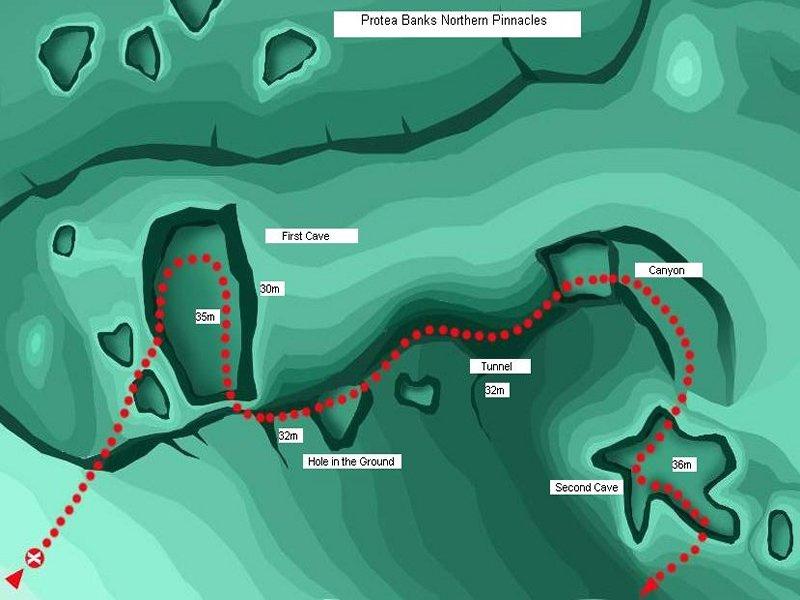
The Northern Pinnacles are virtually untouched and have two caves used by the Ragged-tooth sharks on their annual migration and congregation route The dive starts at the larger first cave, and divers then pass the tunnel and the canyon and get to the second cave This cave has several chambers, each one with a wide opening overhead.
The caves are big and spacious, giving enough room for a group of divers plus a shiver of ragged tooth sharks Swimming into these spaces with the sharks makes for a thrilling dive, especially if you're the first diver to enter; you poke your head down into the opening and find that it's filled
with sharks The caves provide shelter from the current and create a peaceful space to observe and enjoy the sharks in their natural habitat.
Hammerheads | Leaving the last cave, we started to ascend to drift mid-water slowly. There were large schools of scalloped hammerheads passing by These sharks are painfully shy, and we were not fortunate enough to get them in good visibility But they were there, intriguing silhouettes moving just out of sight as we tried to get a closer look. It's a good idea to book your stay for a more extended period, giving you a better chance at great sightings in good visibility
Once back on the boat, we were pleasantly surprised to be accompanied for some distance by a small group of great hammerheads cruising at the surface: what a delightful sighting to see them through the water with the rise and fall of the swell!
We dropped to around 30 meters, with the bottom between 35 and 40 meters Again, just relaxing and drifting with the current, hardly

having to kick at all. A school of trevally met us with much interest, schooling around us
Giant Guitarfish | Diving on a large sand patch called Sand Shark Gully, we saw giant guitarfish in large numbers all over the sandy bottom This was excellent news for local scientists because giant guitarfish are critically endangered according to the IUCN's red list Their population is believed to have declined significantly due to unregulated high levels of exploitation for their flesh and fins These sharks can be seen here from November to March
On each dive, different sharks appeared and disappeared into the distance Some allow us a good view, some in fleeting moments, and others as dark shadows at the fringe of visibility. This made each dive a real adventure full of anticipation for what you might encounter next
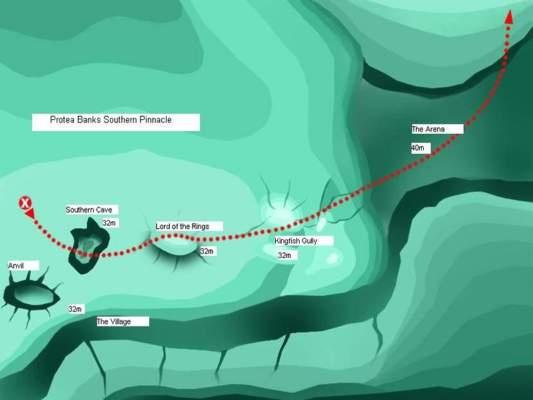
Baited Shark Dive | Doing a baited shark dive almost felt unnecessary, as you get to see sharks on most dives anyway Still, the baited dives give divers an up-close and personal experience This is where video and photography enthusiasts have their chance at great footage
Meeting the Zambezi Shark Up Close | At first, it was quiet, with no sharks to be seen, not even a single oceanic blacktip, frequent visitors on baited dives Then after a while, below us, we could just make out the shape of a Zambezi shark circling, and minutes later, he was joined by another Ultimately, we had 3 Zambezi sharks playing around us for the entire dive. They were calm and interested in us, swimming right up to the divers to check us out Unfortunately, the top layer of water was dirty on this dive, making it a low-visibility dive.
We take groups on shark dive trips to break down the negative image of sharks through education and exposure Showing people what wonderful and necessary animals they are.
We aim to educate people about sharks and give them a firsthand experience of being in the water with them. This is a teaching experience like no other. I started diving with these magnificent animals more than eight years ago From my first shark dive with our local broadnose sevengill shark, my fear turned into immense respect and admiration
We protect what we love and come to love only what we endeavour to understand.
 D I V I N G T H E
D I V I N G T H E
Wide-angle photographers have a fantastic selection of wrecks to shoot in Mauritius I was amazed to see how spectacular wreck photography can be So, I thought you might enjoy looking at a gallery of The Wrecks of Mauritius.
We find only a few anchors as a reminder that over 480 ships have been wrecked off the coast of Mauritius over the last 400 years. You will not be able to dive Le Coureur or the Saint Geraint, the notorious slavers of the 18th century that foundered with their human cargoes off the coast of Mauritius They are now just shameful memory.
Instead, the Mauritian Government and the Mauritius Scuba Diving Association (MSDA) have stepped up and dropped some iconic ships to establish secure artificial reefs Some of these are truly spectacular
Most of these wrecks are within easy reach of the dive centres in the North, and a Safari trip to Coin de Mire makes for a great day’s diving You take 2 or 3 tanks each, and the boat loads up with delicious snacks, water or juice and often a light lunch.


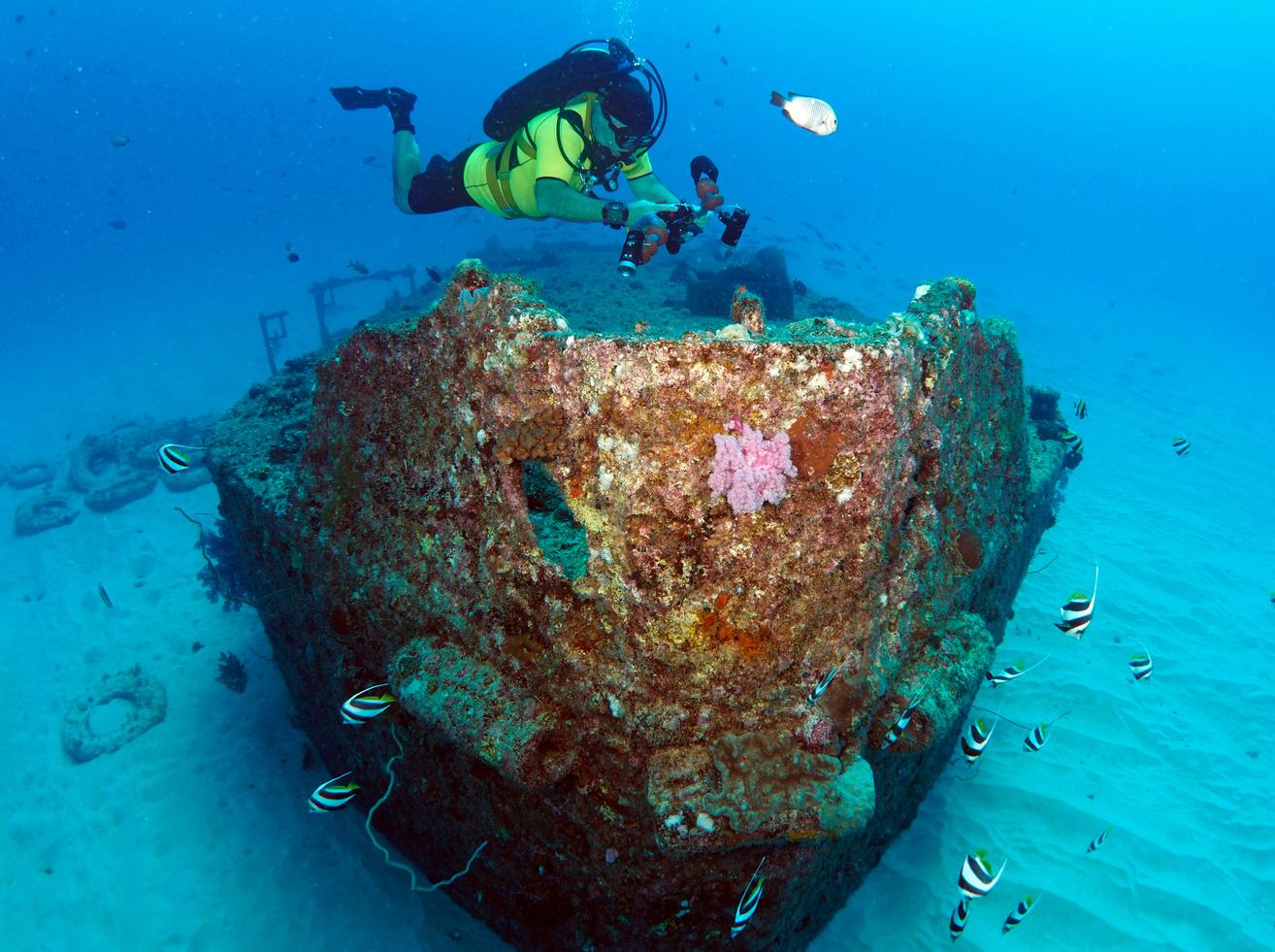 DJABEDA ON COIN DE MIRE
THE TWIN BARGES
DJABEDA ON COIN DE MIRE
THE TWIN BARGES

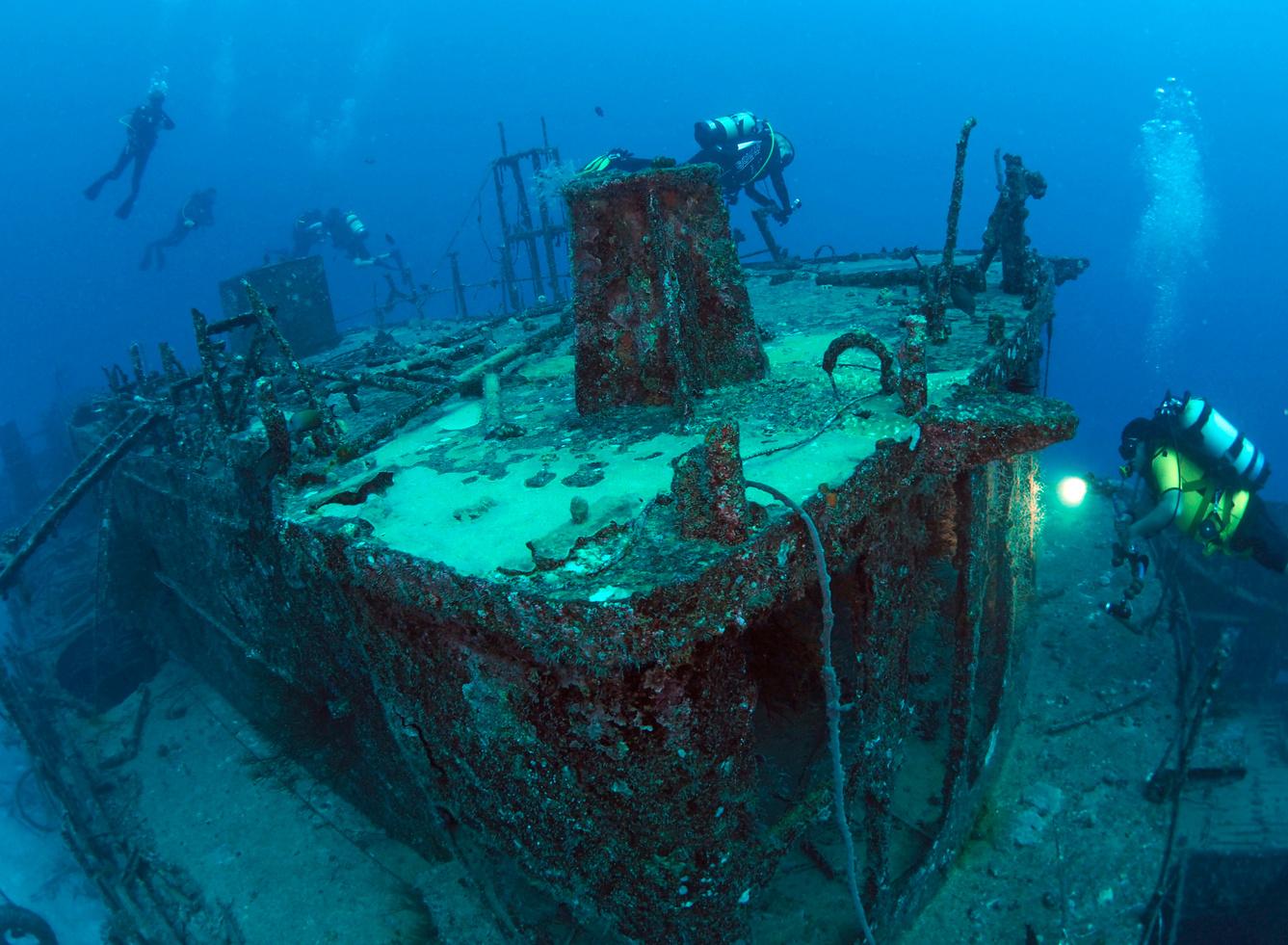 THE TWIN BARGES
SILVERSTAR
THE TWIN BARGES
SILVERSTAR
Coin de Mire Island, so called because it’s shaped like the wedge or quoin that gunners used to raise or lower the barrels of their cannons, is a National Park and the breeding ground for the long-tailed Tropicbird. It’s a short 10-15 minute boat ride We dived with Ocean Spirit, a small, well-equipped, friendly diving centre in Pereybere, the village closest to the Northern reefs.
The Djabeda wreck lies at an average depth of 24 meters, from 20 metres on the mast to 32 at the keel, with dense shoals of fusiliers, blue banded snappers, and scorpionfish, two massive Javanese Moray eels, rays in the sand and exquisite corals It was sunk in 1967, and parts have scattered across the sand, offering additional hiding places for marine life. There is a pair of sling-jaw wrasses living and breeding there as well; worth looking out for them as they are uncommon. It is also rich in colourful corals. It begins to collapse, and we have consented to sink another one After 20 minutes on the wreck, towards the Island Then you decomp the rest of the 50-minute dive t Confetti Bay, an exquisite shallow site the Island, where you have snac prepare for the second dive Pure bliss
The Silverstar is 5 minutes from Per sunk by the MSDA on 39 metres, ascen 28 metres It’s absolutely stunning be is deep blue, resting on white san looms out of the ocean like a fan pirate ship It was sunk away from th so this is a short but dramatic dive penetration is possible for qualified d would help if you had a good torch, a you are into the hold, it’s almost sini filled with crustaceans and morays the mast, there are massive shoals, resident school of spade fish and o batfish This is a huge wreck, with a propeller at 40 metres, plenty o growth, and is best dived with Nitrox, but you need to watch your computer.
Stella Maru is an old Japanese fishing trawler deliberately sunk in 1987 by the Mauritius Conservation Society to create an artificial reef, which is almost entirely intact. It has a businesslike silhouette and a warlike presence It’s full of shoals of blue-banded snappers, giant morays and scorpionfish, but it is also a great photographic subject. We recently found a hairy frogfish, and huddled against a broken portion of the
superstructure was a very small gurnard, that fantastic little guy with wings and legs like a crayfish
The Emily and Waterlily were sunk in 1981 and lie in reasonably shallow water They are a superb example of how quickly soft corals can grow and how rapidly they become home to a host of tiny sea creatures. Both wrecks are abundant with soft corals and small juveniles These features create a photographer’s paradise with white sand, blue water and lilac, purple, blue and pink soft corals. It is often done as a two-tank dive, with snacks on the boat and a visit to one of the corals and reeffish-infested sites in the area nearby
KT Mawa is new, lies on its side and is absolutely brilliant to dive It invites penetration and is filled with new coral growth, rays and plenty of rare fish- two Frogfish on the mast.
Jenny has been diving for 15 years and has more than 1000 dives under her belt. Learning to dive in the chilly, low-vis conditions of Cape Town was not easy, but she overcome her anxiety and is now an experienced drysuit diver. She loves wide-angle photography the most and is lucky to have travelled widely with her Olympus OMD EM5 ii mirrorless camera, from Tahiti, Mexico and Maldives, to the Red Sea, Mozambique and of course, Mauritius.

DAN’s medical assistance services are available to divers, dive professionals, and health care providers. We offer an emergency hotline, medical information, physician consultations, continuing medical education, and a worldwide referral network of doctors who evaluate and treat divers. We provide real-time assistance during dive emergencies and work to prevent injuries and promote dive safety.
W A T C H V I D E O

The Maldives opened sooner than most foreign dive destinations, so there was ample photographic inspiration for our trip in May While the world was still mostly locked down with travel restrictions, my social media feed was alive with gorgeous photos from the Maldives The online coverage included the whale sharks, manta rays, tiger sharks, and colourful tropical reefs we hoped were awaiting us.
All we had to do was get there, which was easy by exotic dive travel standards. A direct flight from Miami to Doha, Qatar, took 14 hours Then a five-hour connection took me to the international airport in Malé, the Maldives' capital. While that is a long time, especially factoring in the layover in Doha, it is also easy, making the Maldives more accessible than most world-class dive destinations. While Miami was convenient for me, others in our group departed from New York, Seattle, Houston, and Los Angeles There are other U.S. and European gateways to the Maldives, which depends on tourism Easy air access is the lubricant that keeps the wheels of commerce spinning.
From Malé, a speedboat or aeroplane can whisk visitors to a land-based resort on one of many whitesand-rimmed islands. There are 1,192 recorded islands
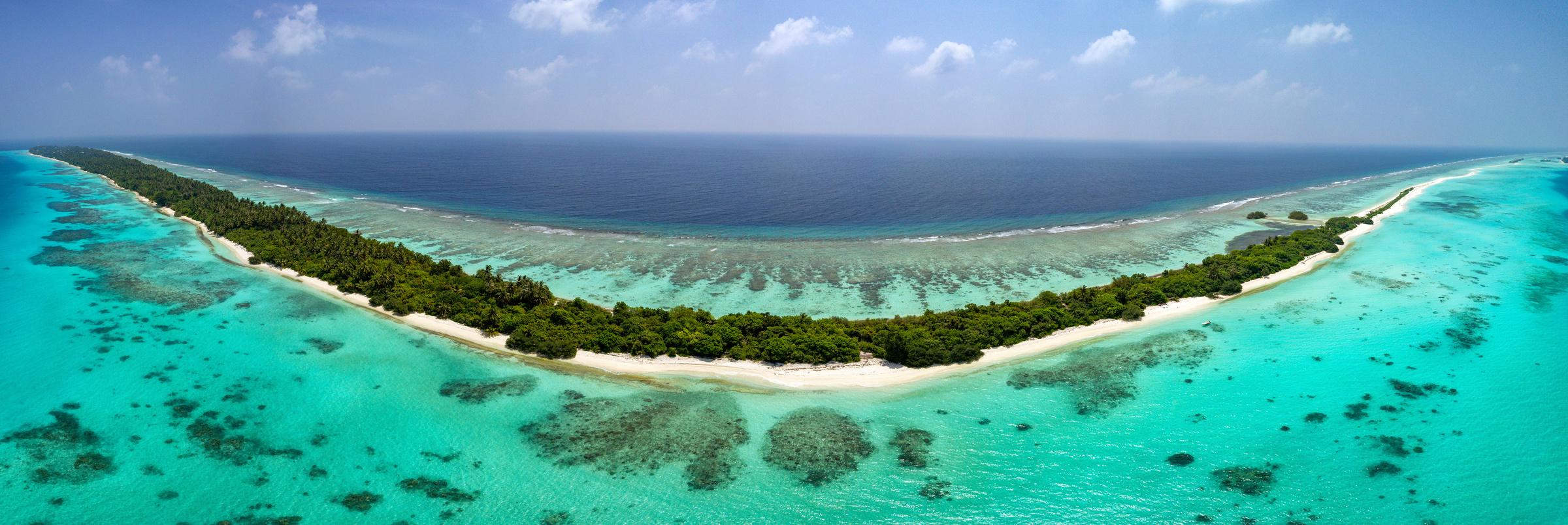
in 26 atolls throughout the Maldives. As we did on this trip, you can meet a liveaboard for one of many possible itineraries However you do it, the dive opportunities are situated away from the capital's congestion and amid a sea of blue Fortunately, being away from the capital doesn't necessarily mean a far trip. There is good diving less than a 30-minute boat ride away and throughout the archipelago.
A brief overview of the Maldives' reef structure helps explain the dive opportunities. The Maldives feature submerged volcanic mountains, which provided the substrate for coral colonization The low coral atolls built up these peaks, and rising sea levels led to extensive fringing reefs These islands are now only the very tops of submerged mountains They are soon in jeopardy of the sea (geologically speaking) subsuming them Large apartment developments are under construction on Malé to house residents from the outer islands that are losing land. Still, tourism continues to thrive despite this infrastructure problem
The diving varies according to whether you are along a channel, faru, thila, or giri Divers generally drop in the channels between the open ocean and lagoons on an incoming tide for two reasons: It brings the blue
ocean water through the channel, and an outgoing tide would sweep you into the vast ocean rather than a quiet, protected lagoon, where it's easier and safer to reboard the dive boat.
Farus are circular reefs rising from the seafloor, usually within a channel. With each tidal shift, the current and nutrients sweep past, meaning there are plenty of good farus with soft coral growth In an optimal tide, good pelagic action happens at the current-facing point. A thila begins in shallower water inside the atolls and can be small enough to circumnavigate on a dive The giri is often smaller, but these terms are often interchangeable. Both lack the circular structure and present a shallow promontory with a concentration of coral

This is relevant because the type of diving depends on the tide, where the structure is located relative to the channel, and whether it is in an area protected from the current Our group of photographers found some of the drift dives through the channels to be unproductive. While there were plenty of things to photograph, it was hard to stop long enough to set up the shot We often opted for a quiet reef dive instead of a high-velocity drift. The Maldives gives you plenty of options depending on the group's preferences.
Malé is at the southern edge of North Malé Atoll, and this area is well-explored, with dozens of quality dive sites Beginning our expedition here, let bags that did not arrive on the international flight catch up to us while we were still near the airport
You can move farther afield to start, and various liveaboard itineraries have evolved to support specific dive interests A southern itinerary can increase the likelihood of shark encounters Addu and Fuvamulah are known for tiger, guitar, thresher, hammerhead, oceanic blacktip, whale, and silvertip sharks, along with oceanic and reef mantas While that sounds exciting, we weren't going so far south this time, but it may be the itinerary for my next visit
The archipelago is spread over nearly 35,000 square miles, running more than 510 miles north to south and 80 miles east to west The country is so vast in marine attractions that you can't go wrong no matter where your liveaboard sails As you move away from Malé, you can choose among popular itineraries, including Ari and Rasdhoo Atolls or perhaps Baa Atoll, which is famous for the scores of manta rays often in residence at Hanifaru Bay between July and November Or you might head south to catch Mulaku, Vaavu, and Kolhumadulu, which is what we did on my 2016 trip to
the Maldives.
Departing Malé boats can cruise a circular route either clockwise or counterclockwise. We opted for counterclockwise to stay within reach of the airport and began with Rasdhoo Madivaru Our checkout dive helped us dial in our buoyancy and refresh dive skills grown rusty during travel restrictions. Not expecting too much, I jumped in with a 50 mm macro lens, thinking that the water clarity would be marginal, but at least there would be good fish. The fish did not disappoint, and the visibility surprised me We had at least 80-foot clarity and 84°F water, so it was very comfortable with my 3 mm suit. I immediately found a large school of blue-lined snapper and one of my favourite Indo-Pacific reef dwellers, the clown triggerfish. Coral groupers and long-snout butterflyfish decorated the sloping reef At the same time, host anemones and their resident clownfish provided willing subjects to hone our group's somewhat neglected photo skills
I was surprised that our second dive would be at a manta cleaning station at North Ari Atoll because that had the potential to be a highlight of any Maldives dive holiday. I thought the crew would save the outstanding opportunities later in the week. Still, our trip's direction changed their priorities The cleaning station was indeed spectacular, not only for the manta interaction but also for the critters we encountered while waiting for the mantas to arrive According to our dive briefing, the prevailing tide would signal which side of a particular shallow coral bommie our group should occupy The fish that cleaned the mantas were in residence there, so all we had to do was wait and not bum-rush the mantas when they eventually came around
Our group did precisely what the dive crew had told us: stay on the bottom and let the mantas come to us The waiting could have been tedious but for the large school of humpback red snapper at the periphery of the coral head. Our discipline to stay in place and await the action was tested when a mellow eagle ray came by and was tolerant of me swimming alongside only 2 feet away. Recognizing the farther I swam with the eagle ray, the farther I'd have to swim back to the
cleaning station when the mantas came, I turned around just in time to see the mantas approaching from some place known only to them
When I settled in again, one of the mantas was hovering just inches above my friend Paula Selby's dome port. I got some great shots of the interaction from the side. Still, I was envious of Paula's vantage point until I looked at her port extension and realized she had to shoot with a 16-35mm zoom lens That is plenty wide for most things, but a manta belly 6 inches from the dome would be little more than a blanket of white draped from above Still, it was a fantastic experience for her, and it went on like that for two full minutes Fortunately, the manta circled back around, allowing her to get the side view
The following two dives at Bathala Thila and Hafsa Thila required a bit of self-control because so many different anemones were balled up with their colourful mantles How many of those can you photograph in a lifetime? Apparently, a few dozen more, judging from that day's folder of Maldives shots. At least I shot some more clown triggerfish and blackbar soldierfish to add some variety to the day
The night dive at Maaya Thila was an anomaly from the clear water we had earlier in the day; with the outgoing tide, the visibility couldn't have been more than 30 feet. We tried to drop onto a pinnacle but couldn't see it and missed the top While getting my accidentally released surface marker buoy (SMB) reorganized, I descended steadily deeper until I found myself kneeling on the sand bottom at (yikes!) 116 feet It shows that doing 6,000 dives doesn't prevent making stupid mistakes, but, fortunately, the deep descent did us no harm My dive buddy and I made our way back to the pinnacle's top at 8 meters, where we were supposed to be, and photographed marbled rays, jacks, and whitetip reef sharks
The morning dive continued our southward trajectory to Fish Head, a dive site on Mushimasmigili Thila. That's a dive I would have revisited, but it was good because of the incoming tide, and the energy would have abated at slack tide. t was more like Fish Soup due to a light-obliterating school of Moorish idol on
the island's current-facing point. I also had great encounters with a docile hawksbill turtle and a large school of blue-lined snapper Better to leave that one in the memory bank and on the memory cards and move on to the next adventure, another manta ray cleaning station at Mahibadhoo Rocks
The protocols stayed much the same, and our group got situated along the shallow reef's down-current edge On this dive, Tracey Bennett benefited from the manta-belly blanket dropping down on her dome port, the animal touching the dome ever-so-gently before lifting off to the reef to be cleaned
The following day's first dive was in a channel with a strong current passing through During the briefing, the divemaster informed us that we would drop to a rocky promontory jutting out into the blue With the incoming current ripping, we were to use our reef hooks to attach to a bit of rock and wait for the sharks to come to us The catch was that this was at 90 feet, so I wouldn't have much time, which meant a grey reef shark might come within only 5 or 6 feet at the very nearest. I would be lucky to get more than a distant fly-by This wasn't fodder for a world-class shark photo, so I cut loose from the reef and did the drift through the channel.
One extreme channel dive was enough for me When it was time for the next dive, I wanted to know the options and asked the crew about what looked like a sloping reef from the topside It was a random spot they had rarely dived, but for a healthy reef and colourful reef tropicals, this turned out to be one of the best dives of the trip The ubiquitous clown triggerfish was also here, but because the reef was so pristine, the backgrounds were awesome I had a great series with very approachable regal angelfish before moving to long-snout butterflyfish doing what they are anatomically designed to do: poke inside tiny coral fissures to feed
That night we were treated to one of the highlights of a Maldives adventure a whale shark at night Whale sharks are a highlight of South Ari Atoll, particularly during the northeast monsoon season from December to May As dusk approached, the crew turned on a
powerful quartz halogen light mounted to the swim platform at the boat's stern The light attracted tiny shrimp and plankton as the twilight gave way to black As the crew predicted, a juvenile whale shark came to dinner. It was perhaps 6 meters and not going anywhere else as long as the food was served We had all the time we wanted to snorkel with the whale shark. Hours later, we went to bed with the whale shark still at the stern I don't know what happened when they turned out the light, but I assume the food chain quickly snapped, and that was the end of it until the next night's visit from another liveaboard
Douglas Seifert reported in a 2018 article in Dive magazine that the Maldives is home to "the world's largest population of reef manta rays Estimates of the total population of manta rays in the Maldives are said to be as high as 10,000 individuals; some believe the figure could be double that " That was four years ago, but I saw nothing to dispute the claim. The following day brought us yet another manta cleaning station at Kurali Manta Point This dive was also productive, with the entire group following orders to hold in one position. Our reward was mellow mantas happy to be in proximity and get cleaned
Other trip highlights include the pristine shallow hard coral garden at Hakura Thila and the school of redtail butterflyfish at Vanhuravalhi Kandu By this time in the trip, I was noticing a curious lack of soft coral, and to scratch that itch, our dive staff suggested Fohtheyo Kandu It was better than some of the predominantly hard coral reefs we dived in the week. Still, we weren't seeing anything compared to Fiji, Raja Ampat, or the Red Sea in the soft coral department I don't doubt some parts of the Maldives have more soft coral than we saw, but overall it wasn't a big feature of our itinerary
One of the best dives of the trip was on the last morning Some of our group chose to sit out to offgas, although we had more than 24 hours between the dive and our flight. We had returned to anchor just off Malé A dive called Fish Tank originated with local restaurants dumping their fish carcasses off the dock. As the dive evolved into a productive site, local snorkel and dive boats often chum the water as a
piscine enticement. The most noticeable beneficiaries of this largesse are the moray eels Countless morays are in nooks and crevices along the bottom It is common to see two or three species of eels cohabitating in a single reef recess. It was so good there I dived it twice, once with a 16-35mm wideangle lens to capture the large school of Moorish idols and models posing before immense honeycomb morays, and later with a 50mm macro lens to take advantage of all the easy fish portraits
Currently, there are 33 marine protected areas throughout the Maldives, an indication that the government is conscious of the value the coral reef and their significant megafauna (whale sharks, manta rays, and sharks) contributes to the national economy by attracting dive tourism. They may not be able to do much to influence climate change and rising seas Still, they can enhance their marine resources' quality, and the government and the Maldivian dive industry are committed to doing just that

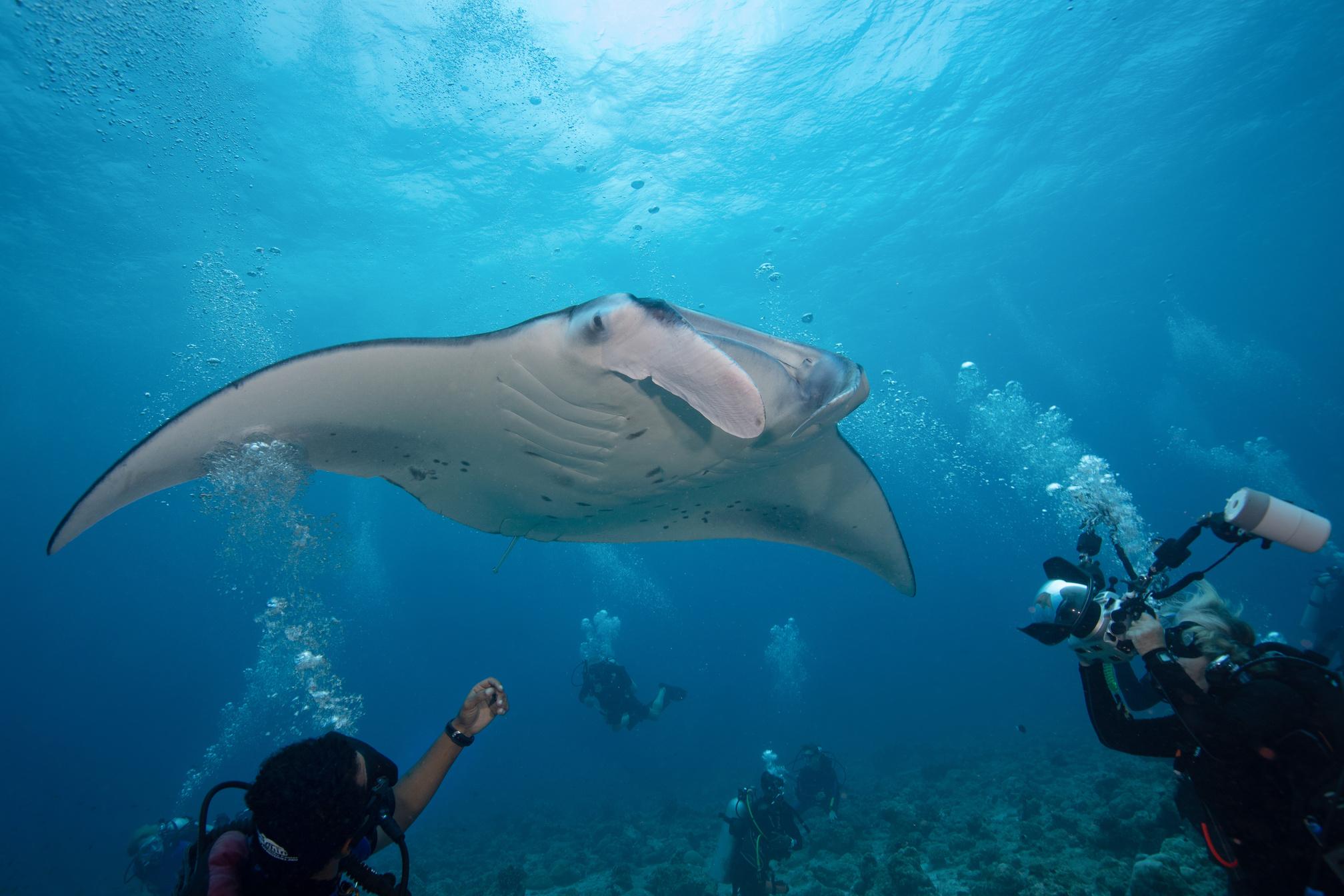


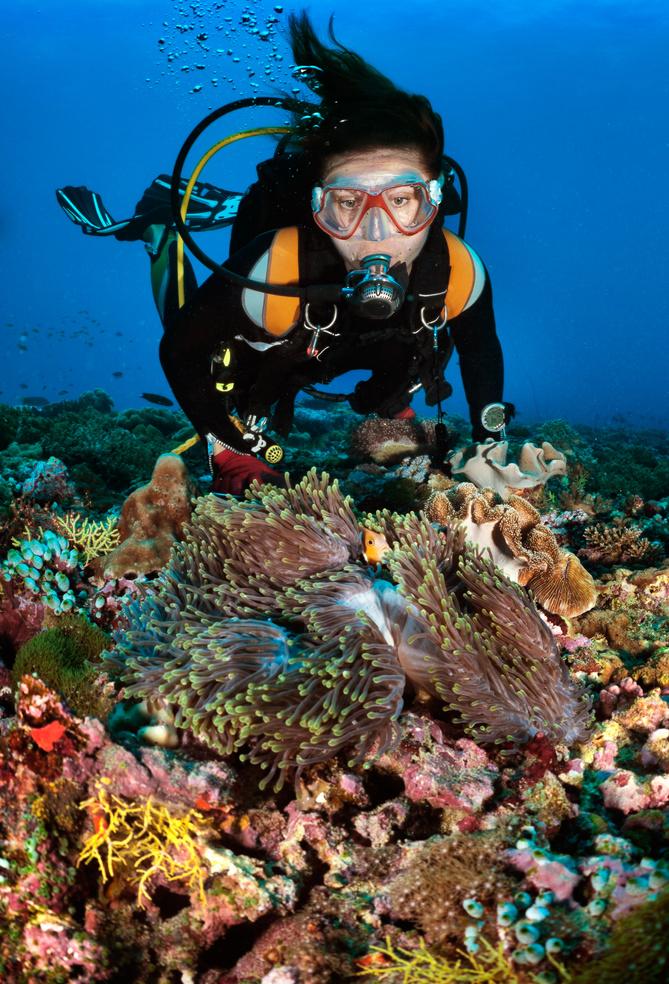


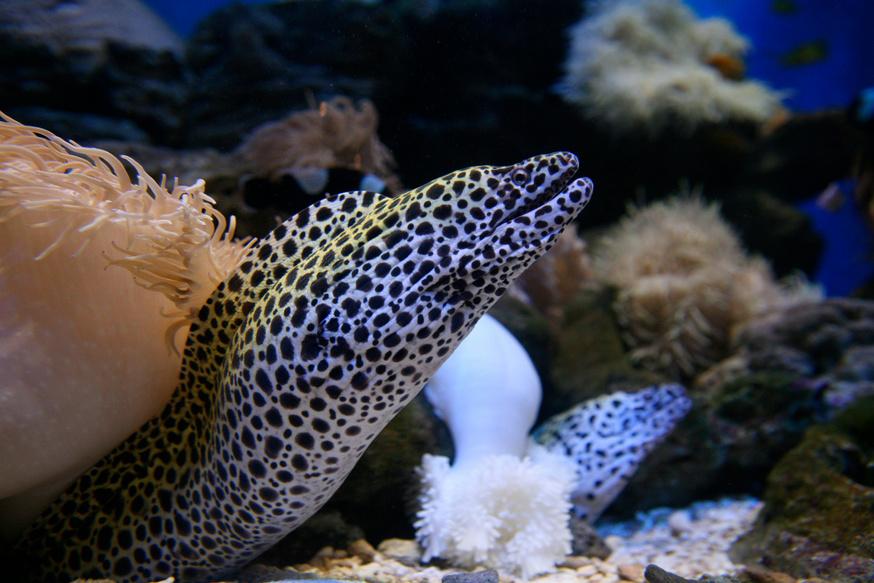
Diving season: The prime dive season is from December to May, although diving is now pretty much year-round. A northeast monsoon arrives around late December and brings calmer water to most of the archipelago. In the clearest conditions, you can have visibility in excess of 30 meters, but tidal movements can reduce it Incoming tides bring clear water, but outgoing tides carry sediment from the lagoon and sometimes decrease visibility on the fringing reef
Dhoni diving: Most liveaboards operate synergistically with a dhoni a 15- to 20-meter yacht with diesel engines and a compressor on board (usually for air and nitrox) Sleeping and dining happen on the mothership, but diving is from the dhoni This isolates the fill station noise to the dhoni, which also has a stable platform with a sturdy ladder for getting back onto the boat
Currents: Diving in currents is a fact of life in the Maldives, although your dive staff can choose reefs devoid of currents or opt for the high-voltage drifts through the passes It is possible to surface far from the dhoni, so each diver should travel with a delayed surface marker buoy and be skilled in deploying it.
Depth: Maldives law restricts dives to 98 feet (30 meters) There is no reason to go deeper, given the topography of the reefs and passes

Temperature: Expect air temperatures in the 80s°F and water temperatures of 80°F to 86°F. I've found that a 3 mm wetsuit is comfortable year-round
Passports and documentation: Check the current information on Passports, visas and other entry requirements at travel.state.gov/content/travel/en/international-travel/International-TravelCountry-Information-Pages/Maldives html Current travel restrictions and COVID-19 policies are available at visitmaldives com/en/covid19-updates
 E L E M E N T O F L I F E & F I T N E S S
E L E M E N T O F L I F E & F I T N E S S
Human life begins in liquid, with amniotic fluid protecting and surrounding the prenatal body. The human body is made up of four main elements: water, fat, minerals and proteins Water accounts for 5060% of the body’s mass So, it seems natural that we are drawn to water for consumption, exercise, recreation and relaxation
The physical principles of immersion in water provide benefits to the body. When the body is submerged, hydrostatic pressure can decrease swelling, aid in blood circulation and support the body The weightlessness you feel in the water also means that the water is reducing the compression of your joints. Moreover, assuming the water temperature is not too cold, your heart rate decreases after submersion, resulting in a relaxed state.
Water also provides an excellent environment for rigorous exercise It is 12 times more resistant than air, and exercising in water provides bidirectional resistance that is difficult to obtain on land without specialised equipment
Scuba divers must work the water efficiently, swimming, streamlining and managing air

consumption by moving smoothly As with any sport, maintaining a healthy body and good physical state are key to maximising your experience. Water aerobics provides a diverse exercise programme, and its bidirectional resistance targets opposing muscle groups throughout the entire body.
e minutes of warm-up exercises using shortlever movements (i.e., jogging, marching, sidestepping, paddle-wheeling forearms and plunging arms). This is followed by five minutes of stretching, five minutes of cardiovascular warm-ups, 25-30 minutes of cardio, 10 minutes of muscular conditioning and five minutes of final stretching. The water’s resistance, coupled with the force behind each movement, increases strength and endurance while burning 250-500 calories per hour.
Try the following five shallow-water exercises to condition the core. The water depth should be between your chest and belly button while your feet are flat on the pool floor. These exercises require the use of a playground ball of approximately 20 cm.
danmedic@dansaorg
They can be performed using repetitions (16-32 repetitions each) or time (one minute each), or as interval training (vigorous exercise for 30-60 seconds) between each ball exercise. If you choose to use these exercises in interval training, the duration of each ball exercise portion should be about three times as long as each cardio portion.
Before completing each exercise, follow these steps to align your body:
Stand on the pool floor with your feet hip distance apart or wider, being careful not to hyperextend your knees. Draw your navel to your spine, and hold the contraction throughout the exercises to keep your core engaged
Place your hands on top of the ball and press the ball down toward the pool floor. Keep the ball close to your hips and the tops of your thighs Stabilise your shoulders by rolling them back and down and retracting the shoulder blades (squeeze the shoulder blades together)
DAN recommends that divers avoid strenuous exercise for 24 hours after making a dive. This avoids increasing the chances of decompression sickness.
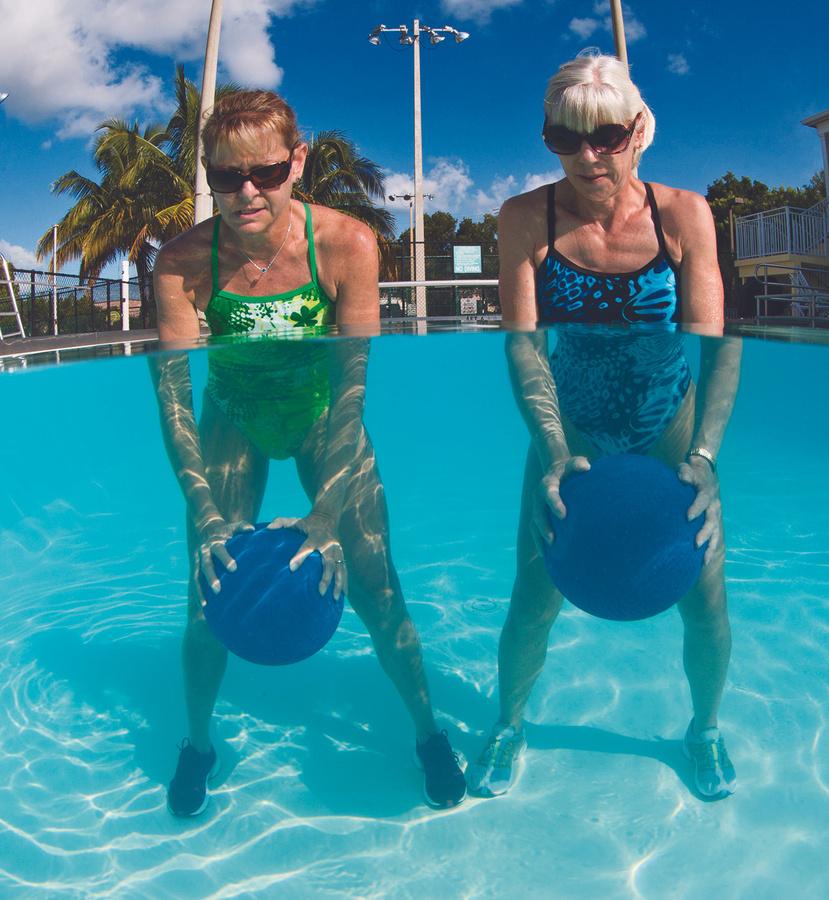
Keeping the elbows tight beside the body, inhale as you bend your elbows to a 90º angle, resisting the upward force of the ball. Your palms should be on top of the ball, facing the pool floor. Exhale as you extend your forearms, pressing the ball back toward your hips and tops of your thighs.

Keeping the elbows tight beside the body, bend your elbows to a 90º angle, resisting the upward force of the ball. Your palms should be on top of the ball, facing the pool floor. Square your hips forward and plant your feet on the pool floor. Inhale and twist from the bellybutton area to the left (around 10 o’clock), exhale and hold. Inhale and twist from the belly-button area to the right (around 2 o’clock), exhale and hold.

Straighten your arms and press the ball to the tops of your thighs. Inhale as you lift your arms straight out in front of you, only high enough that you can keep the ball underwater.
Exhale as you press down on the ball to return it to the tops of your thighs.

Place the ball between your legs, just above your knees.
Stand tall and squeeze the ball with your inner thigh muscles (adductors). This is a quick action.

With extended arms, hold the ball about 15-30 cm away from the front of your body. Exhale as you lower the base of your rib cage to the top of your hip bones for a crunch. Inhale as you raise your upper body to stand, releasing the crunch. Resist the pressure of the ball throughout the movement.
DAN NOTE | It is important to participate in exercise programmes that are diverse and designed to focus on muscle movement, muscular strength, endurance and functional movements. Before beginning any exercise programme or changing your physical activity patterns, you should always consult with your doctor.

LET'S FACE IT. MANY SAY PHOTOGRAPHY CAN'T BE TAUGHT, AND THE PURITANS WOULD SAY YOU HAVE TO HAVE AN EYE FOR IT.
In reality, anybody can call themselves a photographer these days. Creating images is fine if you have a good-quality-camera or cell phone camera Digital imaging equipment makes it easy for anyone and everyone to develop acceptable imaging published on social media and printed Several manufacturers have now also produced housings and waterproof cases for action cameras and various mobile phones
SCUBA DIVING PHOTOGRAPHER | Many scuba divers invest in photographic equipment they can carry on their dive excursions The GoPro action camera and the smaller compact cameras, such as
the Olympus TG6, are sure favourites among underwater photography enthusiasts Becoming an underwater photographer was never my plan I started my photography career during the analogue era, started diving in the early 1990s and never considered doing underwater photography With analogue film-type cameras, it was challenging to take underwater photos, and digital cameras made it much easier to create images underwater
As a diver, starting with a smaller compact system that you can handle easily while diving will be best Consider that you must be much more aware of your surroundings, practice good buoyancy, and monitor your air while trying to get that ultimate shot Also, remember that you will most likely need to learn to use a surface marker buoy when you get into underwater photography Remember to stay within the limitations of your dive qualification and experience.
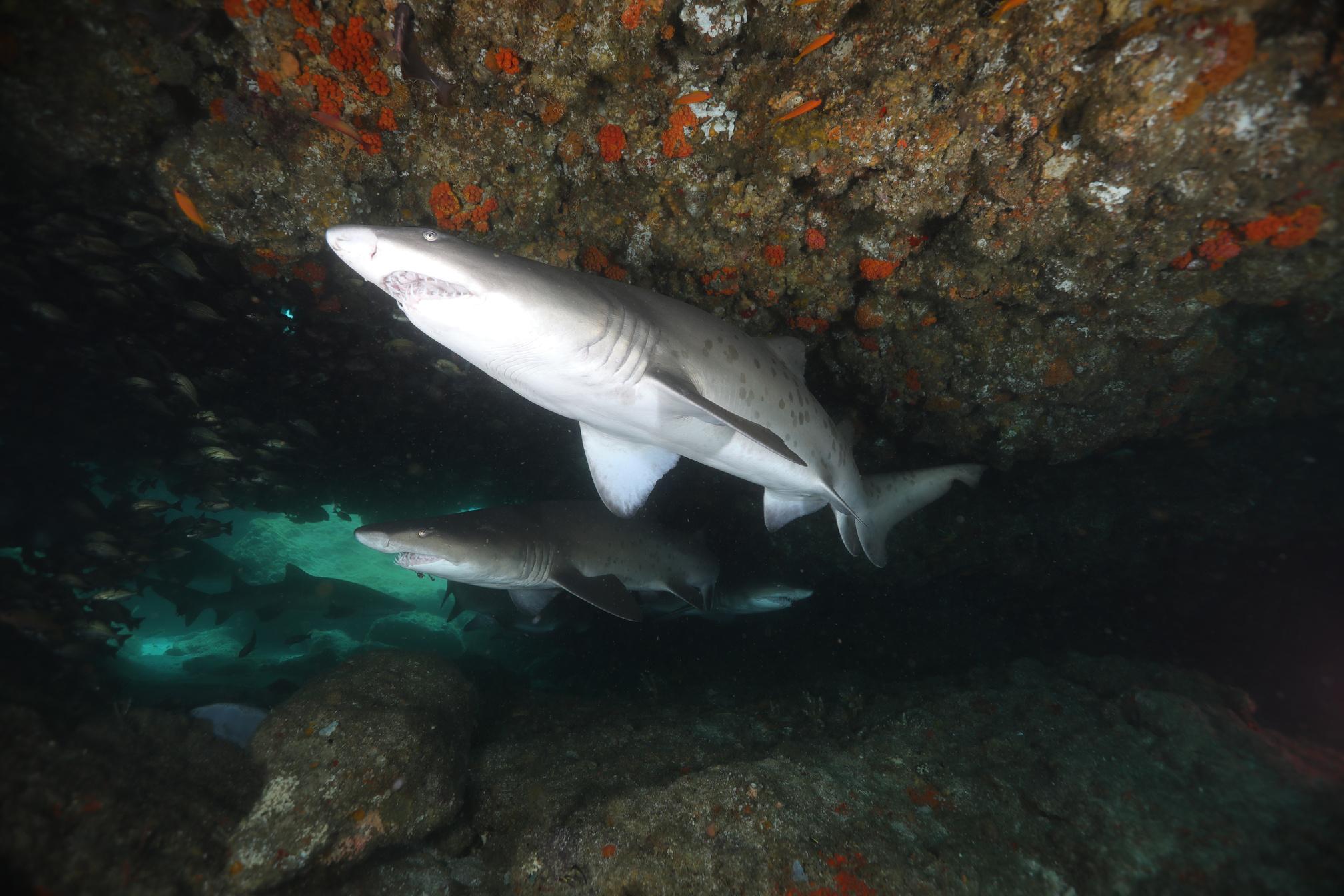
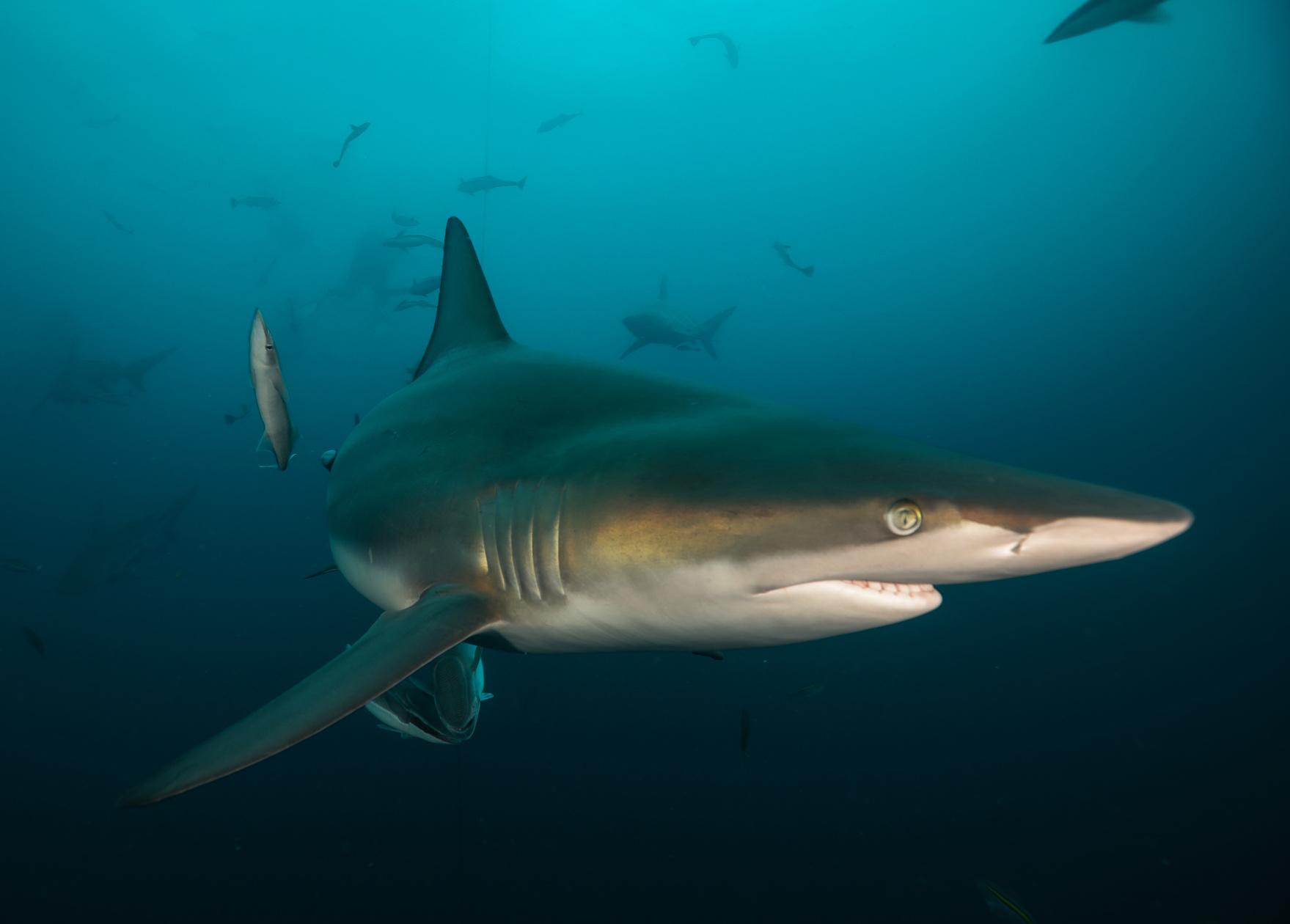 IMAGE TAKEN USING THE NAUTICAM HOUSING
IMAGE TAKEN USING THE NAUTICAM HOUSING
IMAGE TAKEN USING THE NAUTICAM HOUSING
IMAGE TAKEN USING THE NAUTICAM HOUSING
I was most fortunate to be offered the professional-looking Nauticam NA-5DMKIV housing with a 180mm dome port and extension tube. This enabled me to take the Canon 5D MK IV DSLR fitted with a 16-35mm F2 8 MKII lens and explore the underwater world. The underwater housing from Nauticam is made of durable, sturdy aluminium that is ergonomically shaped to feel comfortable in any photographer's hands. All the functioning features of the camera are accessible on the housing, making it very easy for the photographer to change settings and review images underwater
WEIGHT WATCHING | The assembled Nauticam housing with 180mm glass dome port, extension ring 70mm, DSLR camera with lens and two large Ikelite DS160 strobes, weigh in at an approx 5kgs on land. You would think that with all that extra weight, I would sink like an antique ship's canon However, this setup has closer to a neutral buoyancy in the water and I actually needed additional weights on shallow depths to keep the housing with the dome port and myself
stable This was on a rare, 'hare-brained' dive in 6-8 m of water, waiting for a great white to swim by in Plettenberg Bay, Western Cape, South Africa. Exciting, yes, but only advised with a proper briefing and checks We did not have the privilege of seeing the apex predator underwater.
Extra weight tends to produce another concern Your buoyancy control will differ, and you might use more air at deeper depths. Once you become accustomed to diving with this underwater set-up, you soon realise the full potential of the DSLR housed inside 'The Beast', as the 5DMKIV camera is often referred to, is well-known for its technical capabilities. The Auto White Balance (AWB) in video mode is one to note
STROBES, VIDEO LIGHTS AND FLOAT ARMS | Depending on which strobes you have, you will either use fibre optic cables or electric sync cables. In my case I’m using the electric sync cables with my Ikelite strobes. I am not using TTL settings as the hot-shoe connector is not wired to allow


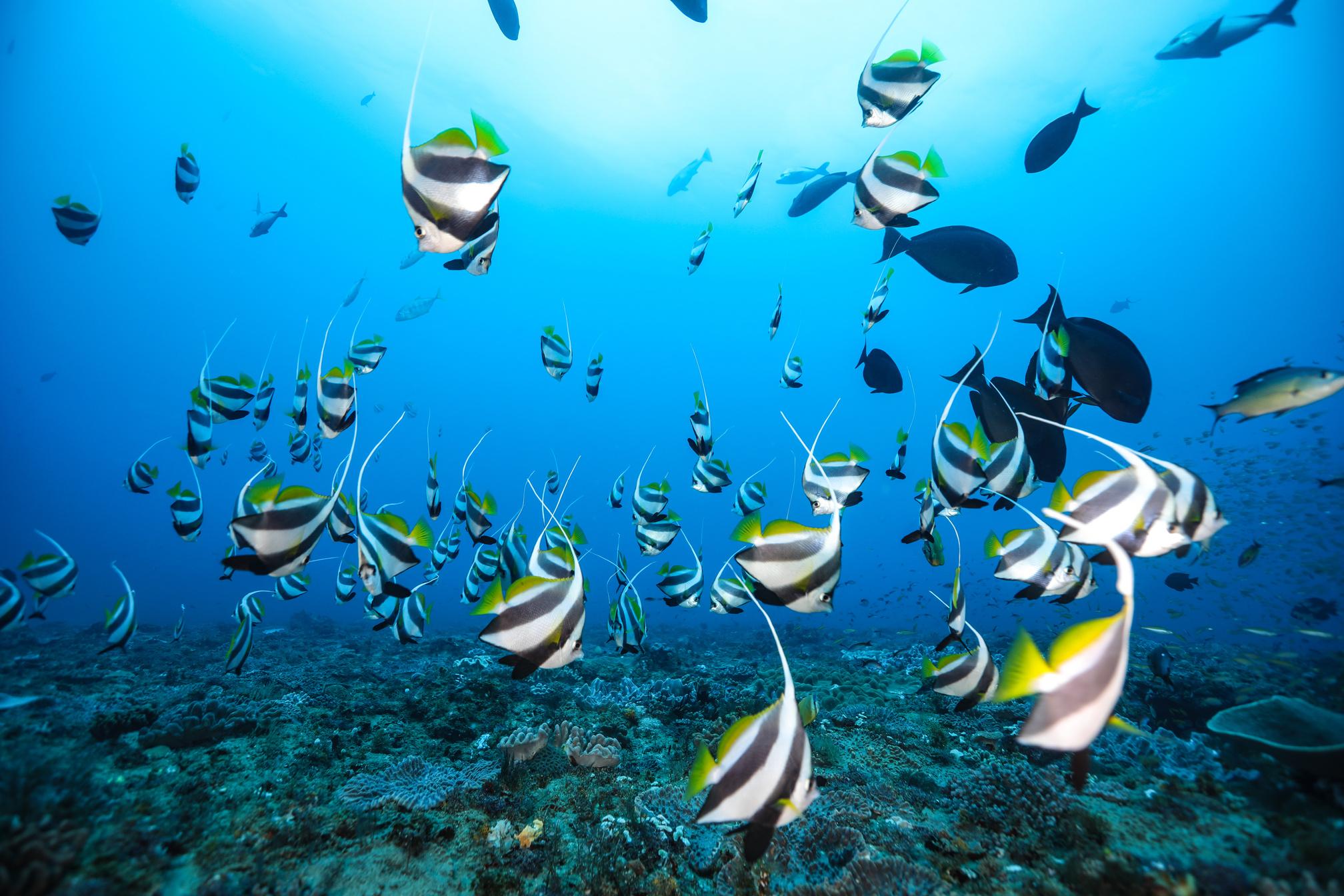
 IMAGE TAKEN USING THE NAUTICAM HOUSING
IMAGE TAKEN USING THE NAUTICAM HOUSING
IMAGE TAKEN USING THE NAUTICAM HOUSING
IMAGE TAKEN USING THE NAUTICAM HOUSING
this Ikelite advises that one use an E-TTL converter to protect the camera's electronics

Adding lighting to your housing is always an issue for beginners Like many, I started with one strobe and quickly got it right. That was with some hot tips from my favourite underwater photo coach Using two big Ikelite DS 160 strobes that pack an excellent light punch also makes for an insane amount of backscatter when I get the positioning of the strobes wrong This also happens accidentally While diving at the world-renowned dive site of Aliwal Shoal on the East Coast of South Africa, the strong surge motion underwater pushed me around, and I knocked the strobes out of position and was rewarded with backscattered images Lesson learned: Keep checking your strobe or light positioning when diving in rough sea conditions.
A further consideration you should note in rough or fastmoving water is to stay safe and prevent bumping your glass
or acrylic dome into the reef These unexpected knocks can become a potentially expensive accident Once again, buoyancy is vital.
To get the correct positioning for your strobes and lights, it would be best to use a combination of a float arm with a double ball arm this attaches to the mounting ball on each handle This gives you the flexibility to get the optimum positioning for your strobes or lights and you can use them for wide-angle and closeup shots The float arms assist with the buoyancy of your underwater camera system with the extra weight in the strobes, lights and glass dome ports. The ideal for me is to have a 20cms and a 13cms double ball arm which will allow you to utilize the best light for your fabulous wide-angle photography It also enables you to position both the strobes or lights to one side, to get creative with side lighting Once again, I advise you to speak with your housing supplier regarding the correct float arms I liked the blue trim finish on the Nauticam float arms. I can be swayed by a bit of
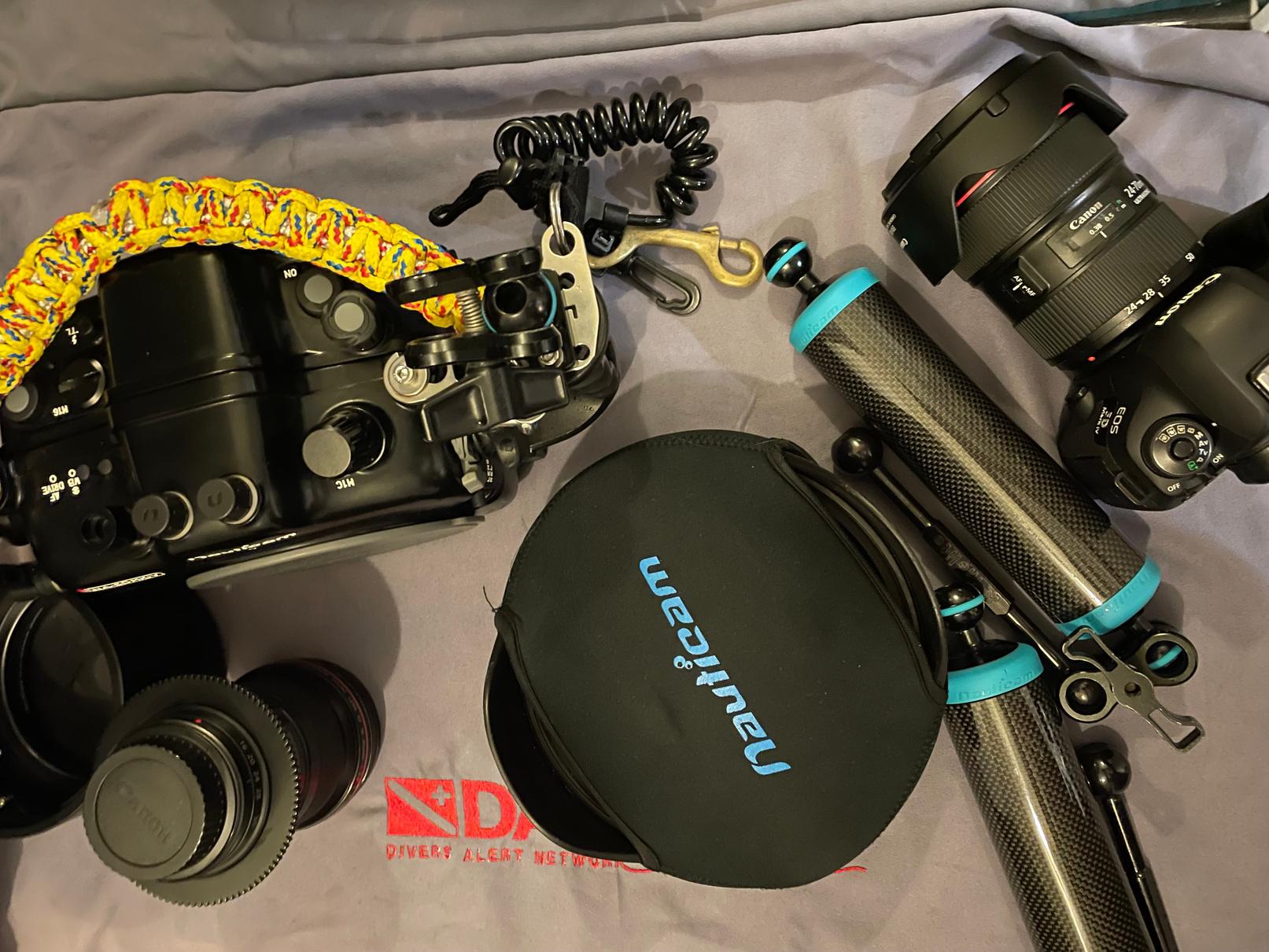

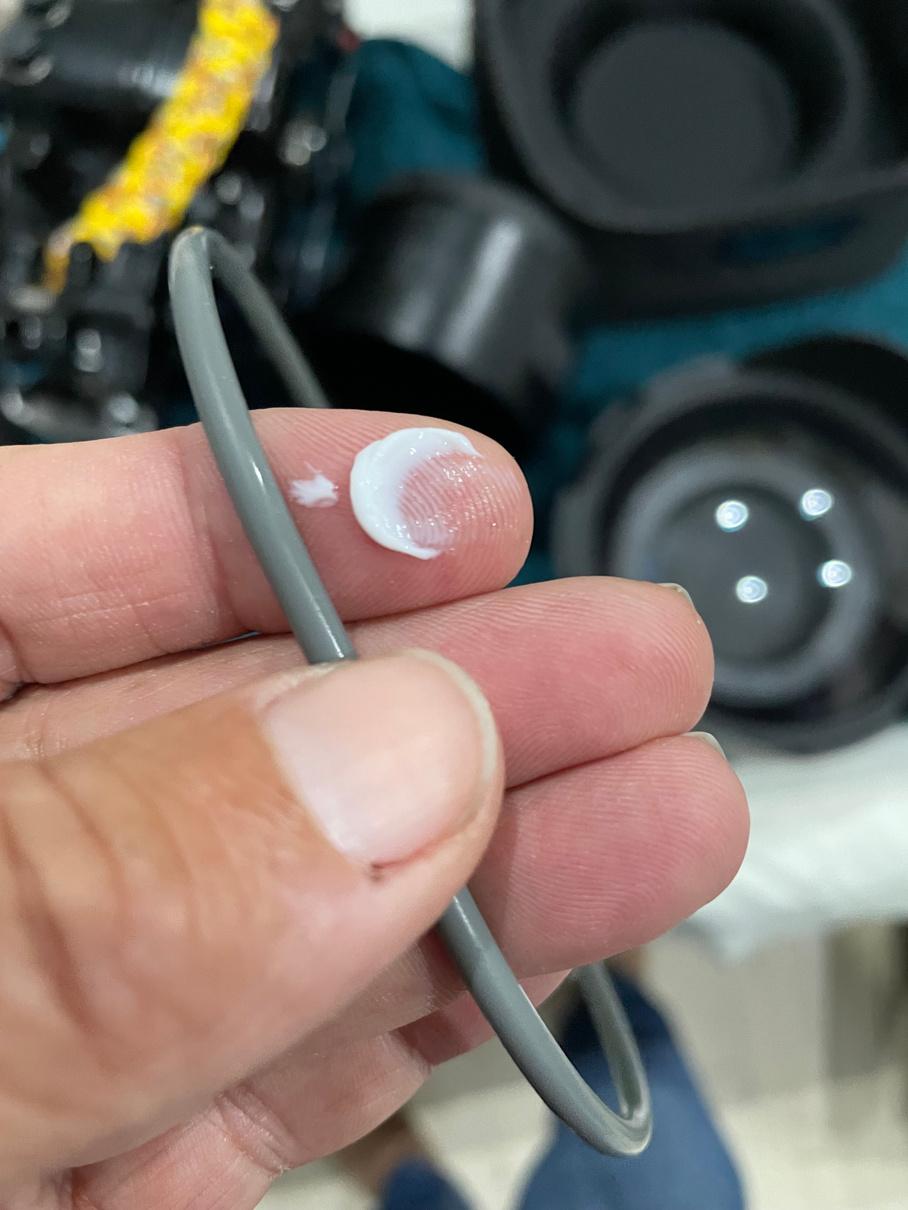
colour, but most dive equipment should be fashionably black
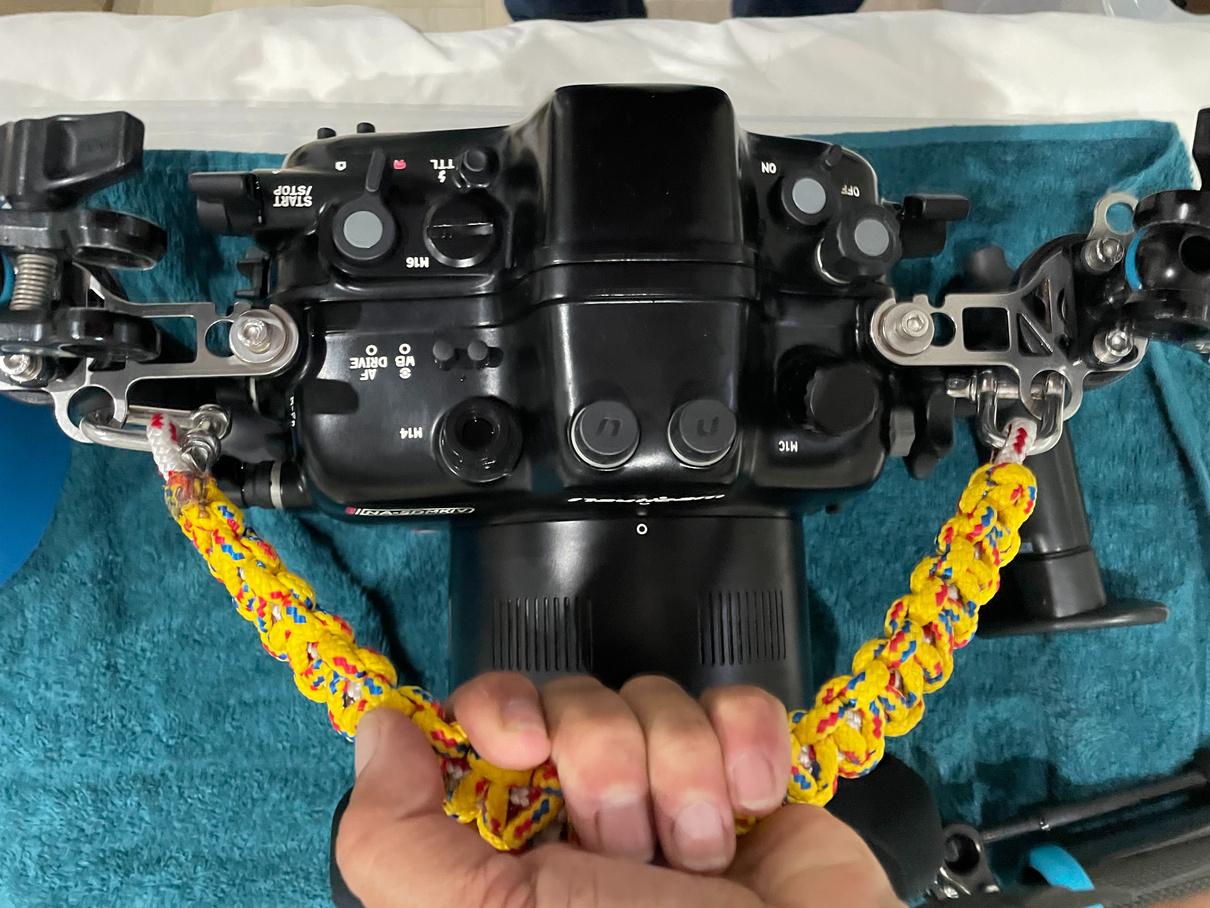
I am unfamiliar with video lights and have only recently started experimenting I'm looking forward to developing some skills and techniques with these for another article. My limited experience with video lighting was with a compact camera – the legendary Canon G12 and canon housing – to which I added two dive lights. With this, I had great success, but we all want to progress to better and bigger cameras that provide higher and better quality images
FIRST & LASTING IMPRESSIONS | Access to every function on the camera is a sign of well-thought-out engineering and design, which is evident in the Nauticam housing. My first impression of the Nauticam housing was that the engineers and design team have seriously considered safeguarding your valuable camera equipment. They have a patented port
locking lever to secure your extension rings and ports, in addition to housing locking latches to prevent you from accidentally opening the housing. This all helps to give the underwater photographer peace of mind. Essential to take your equipment underwater is to be sure that you keep the O-rings clean, dust-free, hair-free, sand free and adequately lubricated. Use lint-free cloths when cleaning and drying Orings With proper lubrication, I have been told that you should be able to feel the silicon grease but not obviously see it.
Last but not least, every good camera housing should have a vacuum system. This Nauticam housing feature takes time to get familiar with. What I liked about it is that you don't have to guess when it is active and the housing is safely sealing. The suction pump also does a quick job of evacuating the air with little effort. Get familiar with your housing systems by reading the user manual The battery system in the housing has a good lifespan if appropriately

 IMAGE TAKEN USING THE NAUTICAM HOUSING
IMAGE TAKEN USING THE NAUTICAM HOUSING
IMAGE TAKEN USING THE NAUTICAM HOUSING
IMAGE TAKEN USING THE NAUTICAM HOUSING

 IMAGE TAKEN USING THE NAUTICAM HOUSING
IMAGE TAKEN USING THE NAUTICAM HOUSING
IMAGE TAKEN USING THE NAUTICAM HOUSING
IMAGE TAKEN USING THE NAUTICAM HOUSING
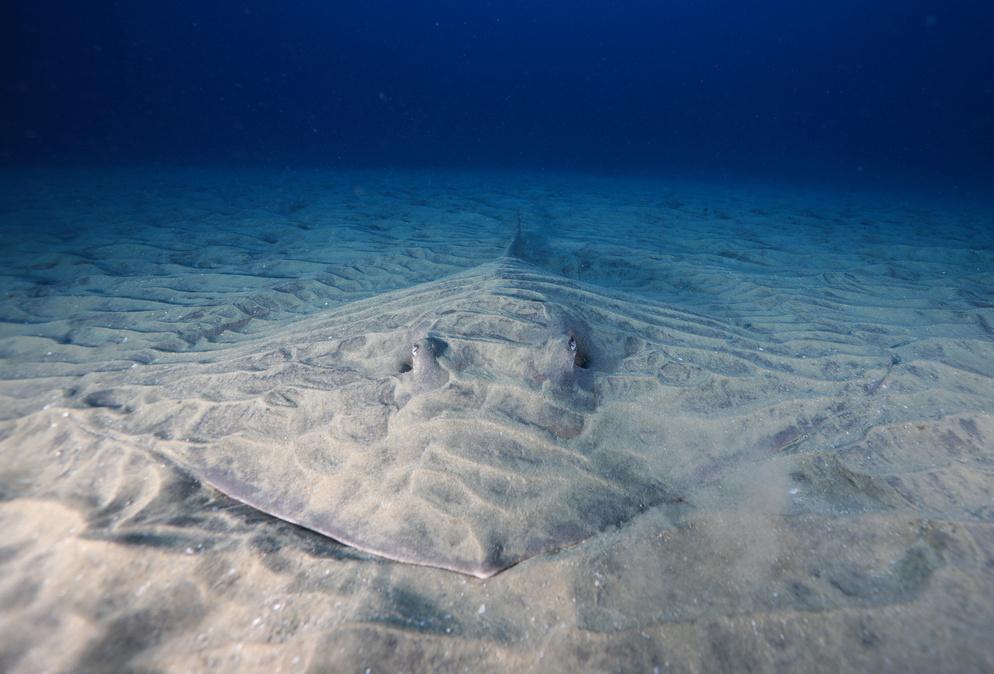
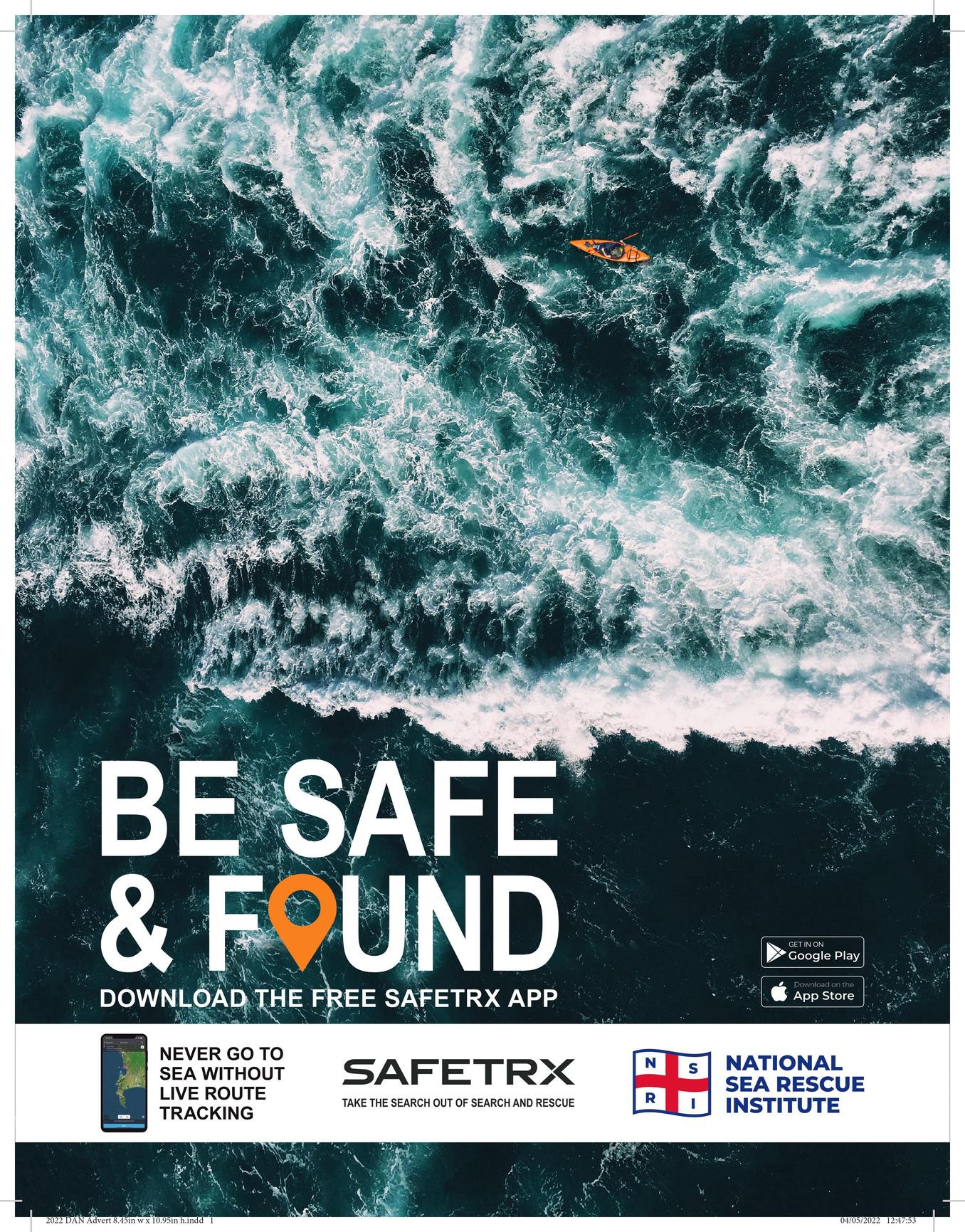
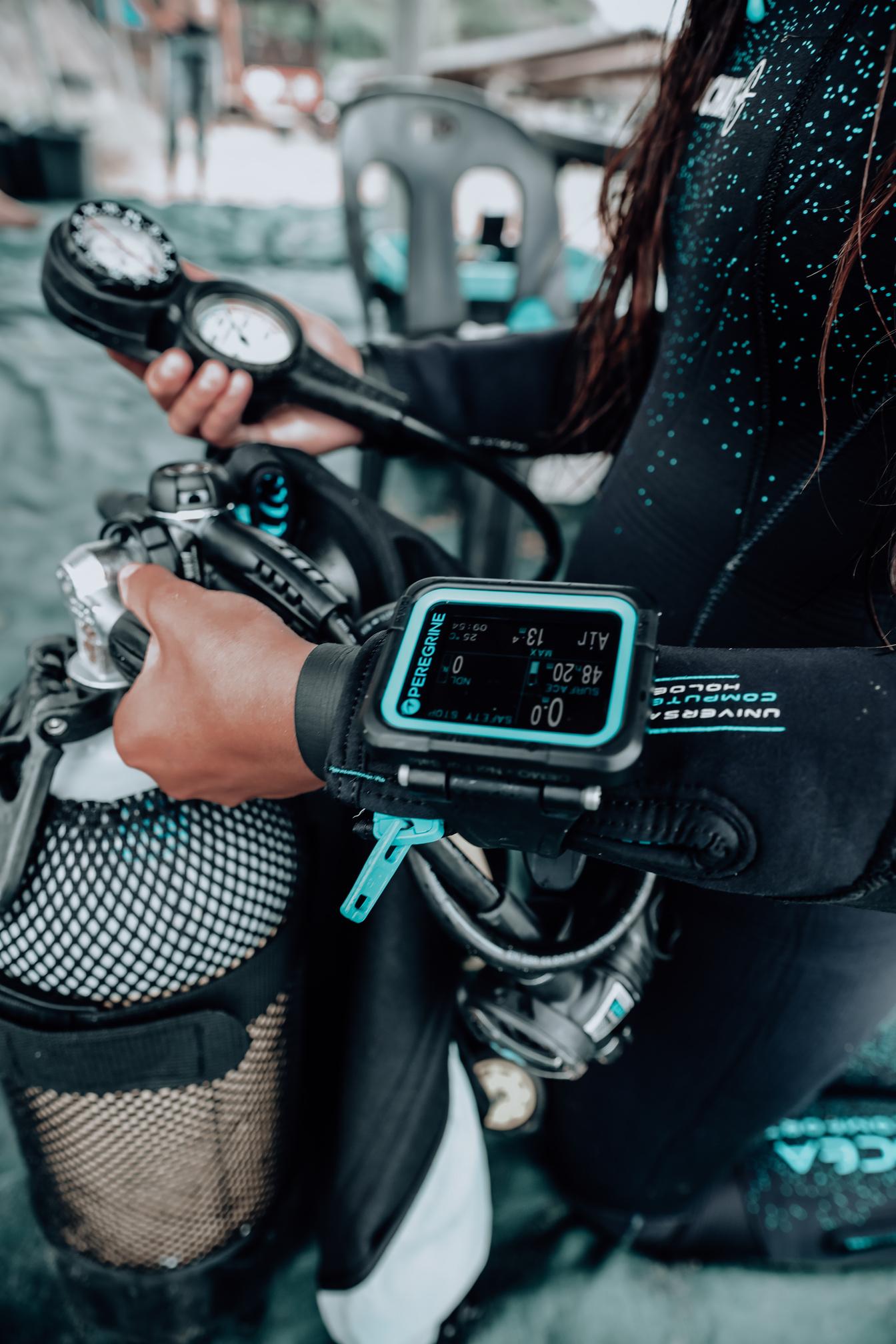
SHEARWATER DIVE COMPUTERS RULE THE SCUBA DIVER ROOST | Three factors determine any diver's stay underwater. One is the amount of air the diver has, the second is the amount of time, and the third is to which depth the diver will be going underwater Traditionally these are monitored by a timepiece/watch, a depth gauge and an air pressure gauge. The latter provides information on the available air in the diver's cylinder Having a dive computer to integrate all these is obviously ideal
I was fortunate to lay my hands on the latest dive computers available from Shearwater Research Based in Canada, Shearwater produces high-quality and accurate dive computers suitable for all kinds of diving. These dive computers have become the instruments of established choice for technical divers (and now increasingly recreational divers) I was provided three models to try out
THE PERDIX | This dive computer combines a clean design and innovative technology It provides reliable information Some might say its old style, square design and size make it too bulky for recreational diving Valid criticism, maybe, but it is eventually a personal choice. The Perdix is a dive computer that will stay with you through your dive experiences and continued diving education It is powered by a user-replaceable AA-size battery and will accept the rechargeable version too The standard AA battery should last around 40 hours of use. If you are a lazy dive log keeper, the Perdix will record 1000 hrs of diving, allowing you to keep your dive records until you can download them The ultra, legible, full-colour screen layout can be customised to your preferences. At the same time, important information is highlighted in different colours to make them stand out.
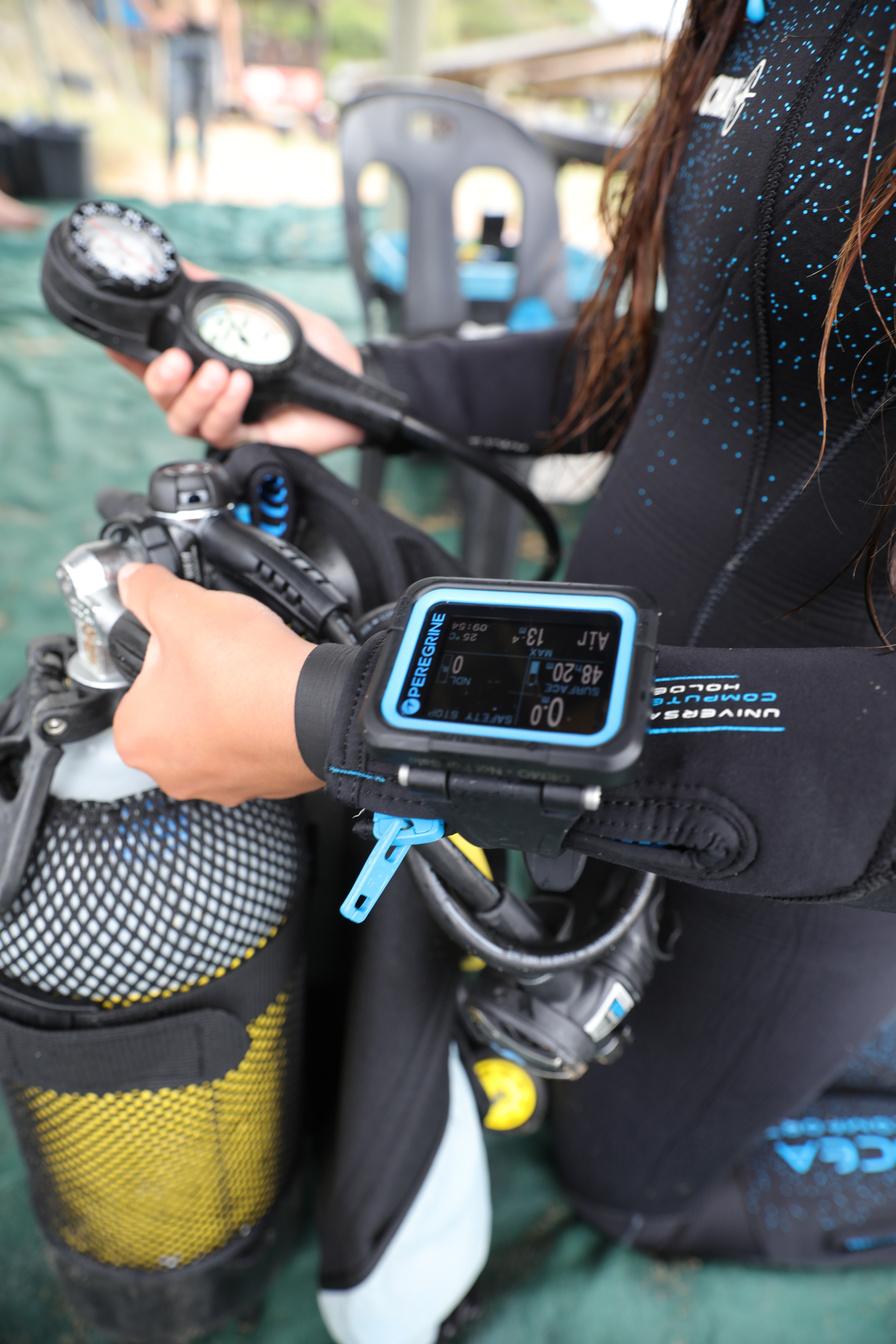
THE PEREGRINE | One of the new devices in the Shearwater repertoire is the Peregrine. It was clearly produced with the recreational diver in mind. Advancing recreational divers will find it versatile and functional
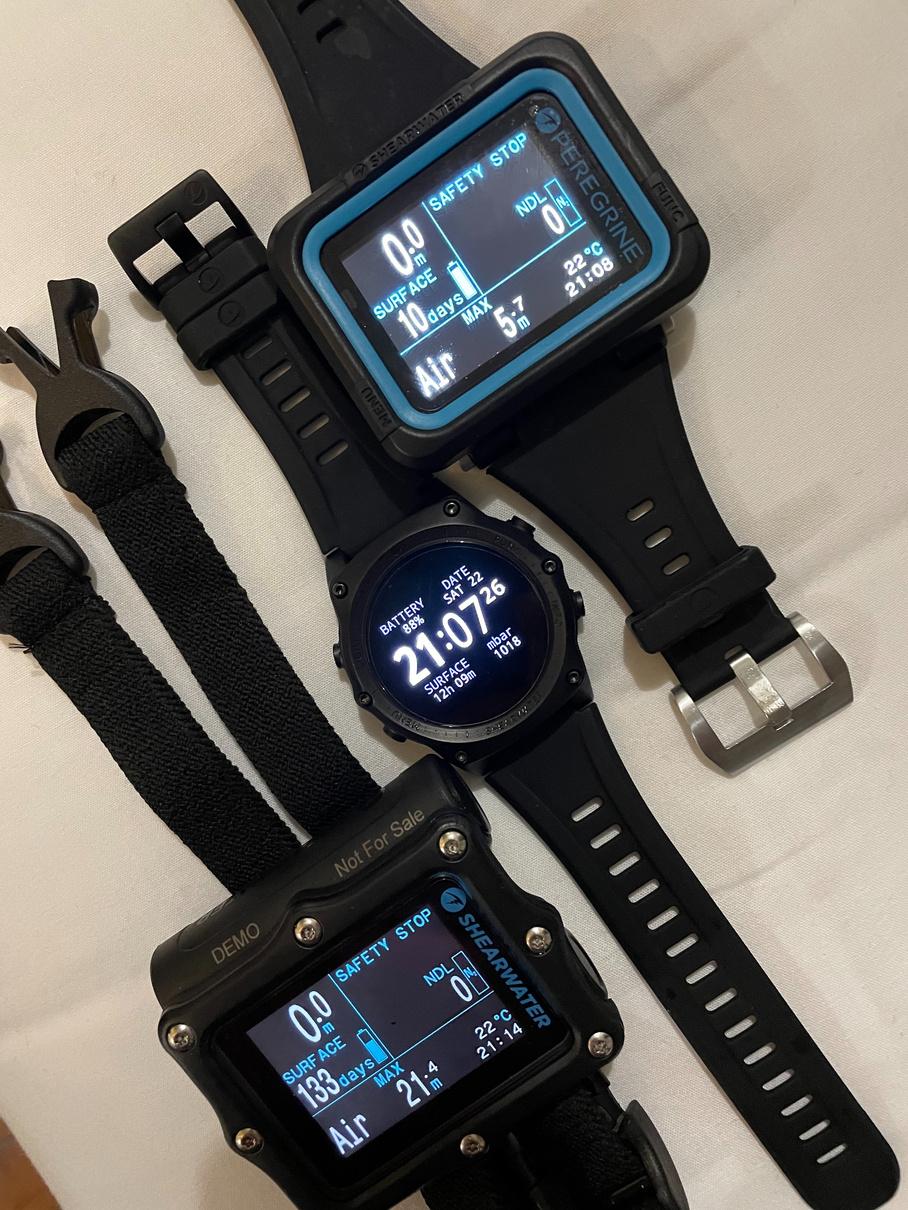
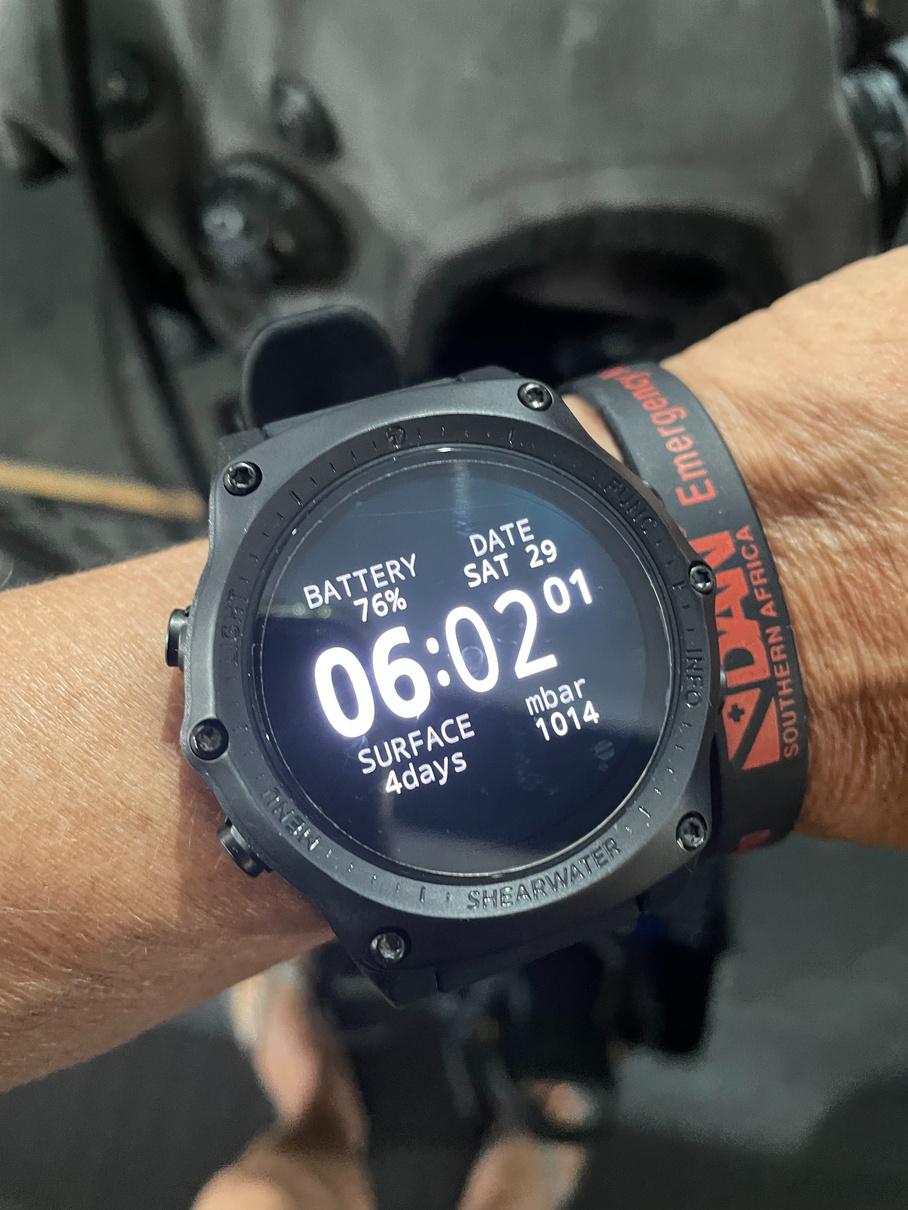


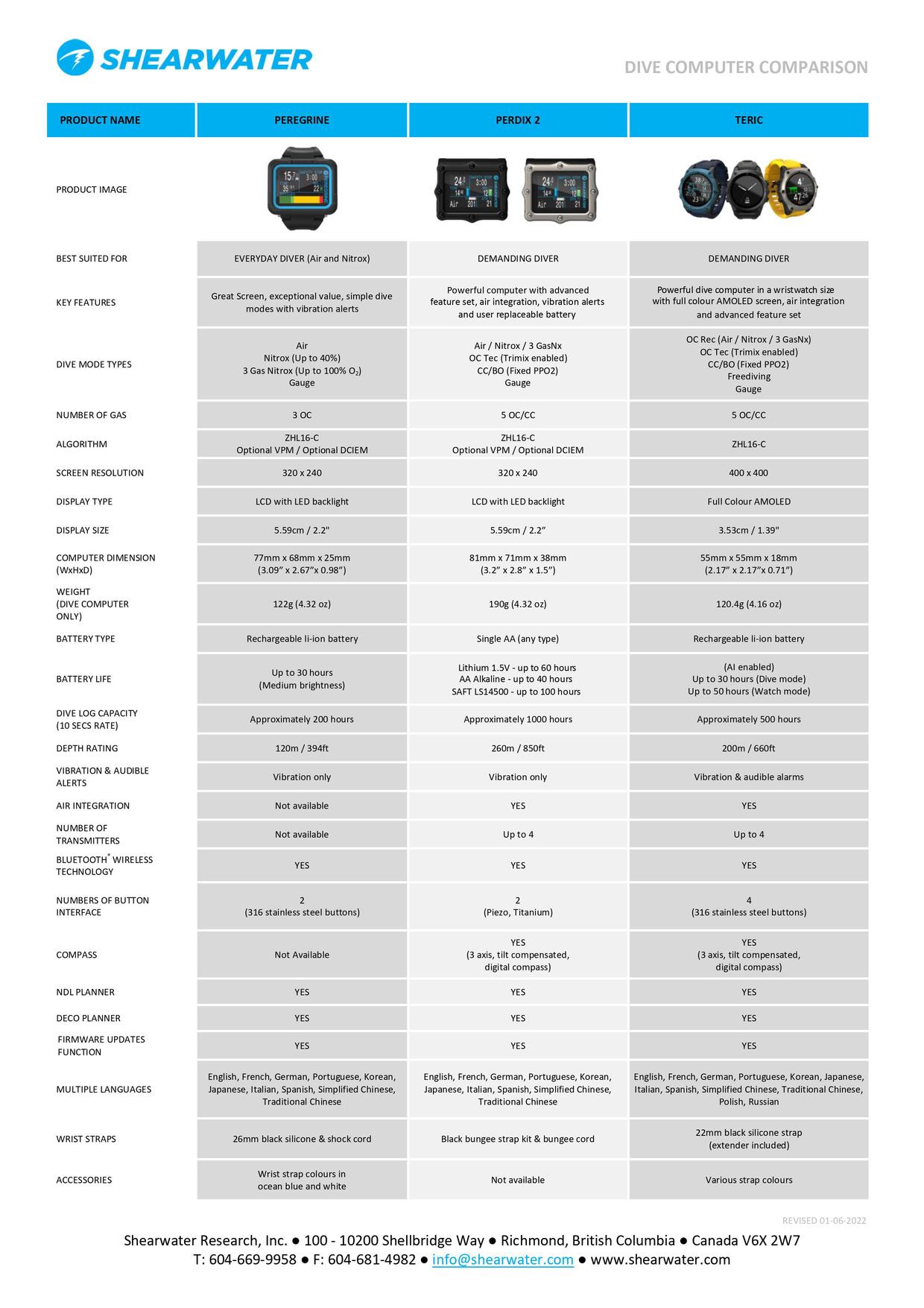
Unlike the Perdix, this dive computer does have a more modern 'look' with a blue bezel around the screen The rounded edges and more compact design will appeal to more fashion-conscious sports divers It packs many powerful, accurate modes and features you would expect from a Shearwater dive computer It also sports a rugged, sturdy rubber wrist strap that is long enough to fit comfortably over a 7mm neoprene-wrapped wrist Another great feature is that the computer uses a wireless charging dock. The latter comes with a standard, handy storage/carry case and minimises carrying around cables and adapters Shearwater has also reduced the amount of plastic used in the packaging – a sign of environmental consciousness. As with the Perdix, dive log storage is generous, and the Peregrine will record up to 200 hours of your underwater adventures The full-colour screen with essential information highlighted is again a valued feature The vibration alerts could be felt while wearing the computer over a 5mm thick neoprene-clad wrist. It is customisable with a blue or white strap that will make you stand out from those with typical black attire
THE TERIC | Almost all manufacturers have developed a watch-style dive computer, which the Teric also offers the

world of dive computers. The Teric is trendy with a smooth matt-black finish It is stylish enough to keep on your wrist, even when you change into your favourite little black cocktail dress The standard black strap is also available in five fashionable colours, which will suit the colour-coded clan. It is a powerful dive computer in a wristwatch size It has a fullcolour AMOLED screen and is air-integration enabled It can accommodate up to 4 AI transmitters This little black machine features five dive modes, including one for Freediving. The user can also select from 5 open circuit and closed-circuit gas modes The customisable conservatism offers flexibility to those who wish to customise their exposures for safety. Yes, and for the tardy dive log keepers, it will also record approximately 500 hours of underwater exploration time
BLUETOOTH LE & SHEARWATER CLOUD | Much like the Application icon, this Bluetooth device is a proper lightning bolt for those who want to keep their Cloud-based dive log up to date You have probably guessed by now that logging my dives has not been my priority In fact, I abandoned keeping a record of my dives years ago – in 2008, while training an open-water diver in Mozambique
[Editor's note: Having an electronic dive log is an invaluable safety feature in the case of decompression illness It allows diving physicians to evaluate the last dives you did, even if you did not log them consciously, and you do not have to remember everything So having this facility is invaluable]
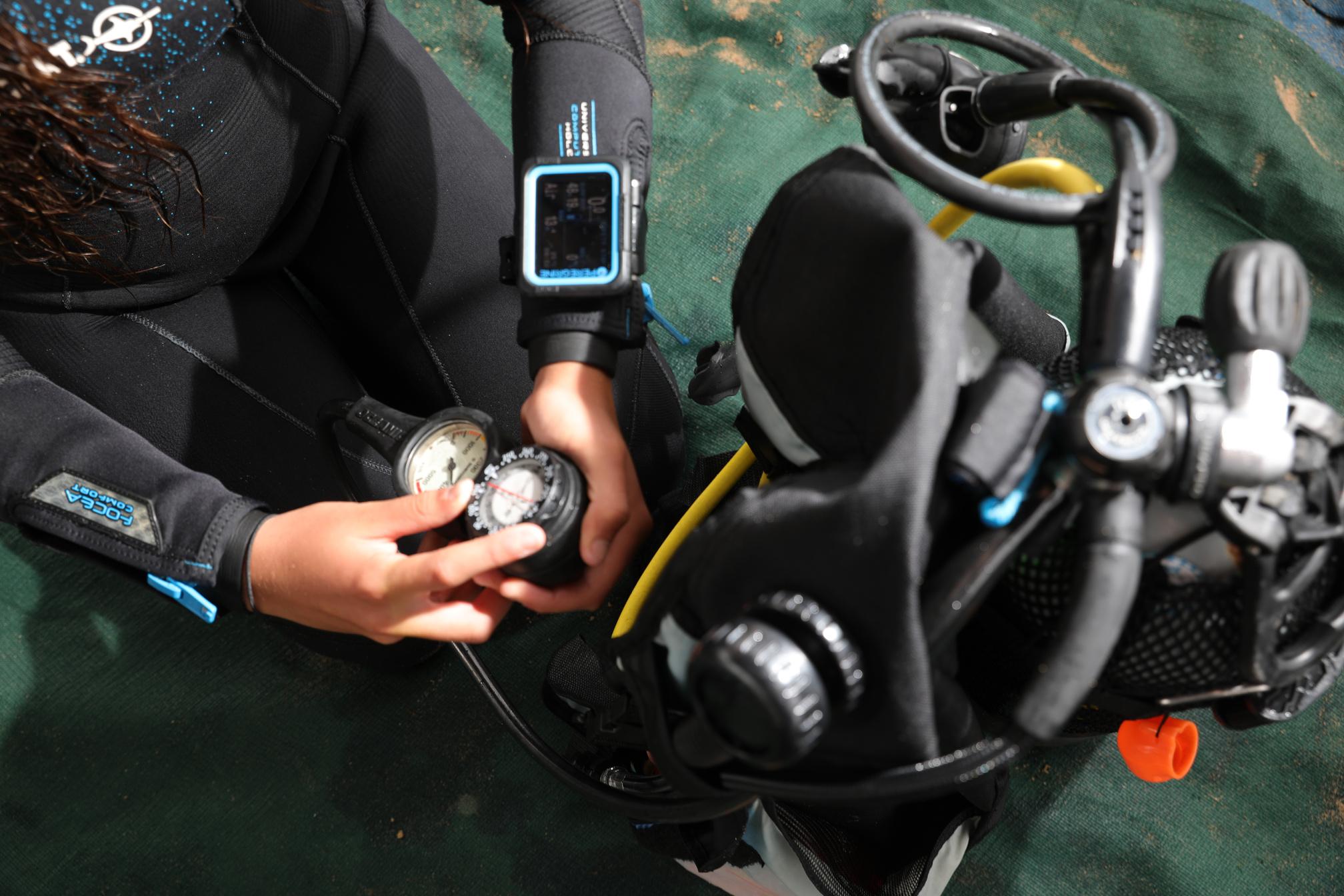
The application's different functions are very user-friendly. They offer you space to add personal experiences and details to your record The program and various screens are easily navigable and readable. Keeping your dive information handy and organised is easy once you have downloaded the dives from your wrist As for me, once I had downloaded the Cloud from Appstore – it is also available on Google Play - I paired it with the various models and downloaded my dive log in seconds It actually made logging my dives fun again: engaging with statistics, filtering them by Dive mode, location, site, environment, buddy, year/month or by year added to this. Once again, Shearwater utilises colour to its best advantage
When reviewing my basic dive statistics between 9 October
2022 and 24 November 2022, on Open Circuit, in Recreational dive mode, I counted 28 dives with a total underwater time of 22h11min
My deepest dive was 32 m, and the longest was 1hr 10minutes That was quite cool to know! I guess I will have to rethink my logging habits. In closing: My personal conclusion is that Shearwater Research is a leader in the dive computer field
Thank you to Dive Action in Cape Town for providing me with the various models for the duration of the DAN Road Trip. They are the importers of SHEARWATER computers and NAUTICAM in South Africa
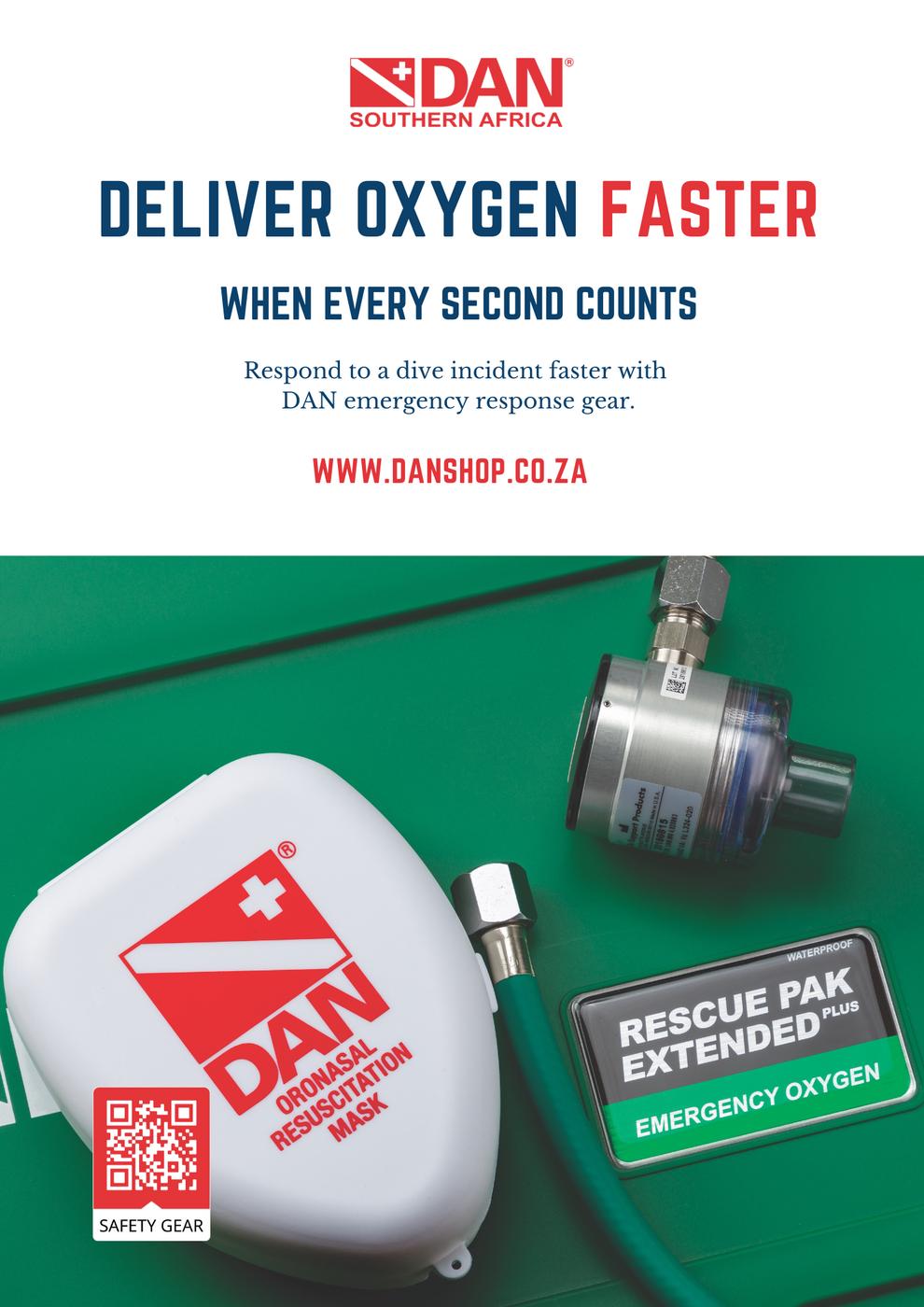
Dive computers might measure water temperature to display on your screen readout. Still, almost none of them actually incorporate that data into their decompression algorithm calculations.

Fluctuations in temperature may affect diving safety by increasing the risk of developing decompression sickness (DCS). The reason for this is two-fold – if the body is cold, it can retain more inert gas. Then, when the diver warms up after a dive, the recovery to normal body temperature may bring bubbles out of solution. Hot showers or baths and exercise may have the same effect: This is why exercise is not recommended within 24 hours of diving. If the diver is adamant about keeping to their exercise routines, then 4 hours before and after diving should be considered the bare minimum due to the influence of exercise and increased body heat on blood perfusion and gas solubility

After the dive, exposure to sudden and excessive heat, such as in a hot shower, produces increased superficial blood flow and lower solubility of gas, which could induce decompression sickness.
As mentioned previously, cold tissues in-gas more and have a higher affinity to hold excess nitrogen Active movement may help eliminate nitrogen during decompression before bubbles are likely to form Suppose a diver becomes mildly hypothermic during the ascent phase of a dive - in that case, the ability to eliminate excess nitrogen is decreased, and DCS can become more likely - in some studies, the perfusion rate was halved, thus doubling the required duration of decompression.
Some say that fat is only important as an indicator of physical condition and efficient gas exchange and is of no consequence to sport divers being a slow tissue, unlikely to affect those who stay within accepted NDT dive time limits as it in-gasses relatively little on regular sports dives. We know that fat has a much higher affinity for nitrogen than other tissues, but how this impacts the risk of DCS is still uncertain. ‘Chubbier’ subjects may be at slightly greater risk of DCS, as nitrogen is 5-6x more soluble in fatty tissues than aqueous ones Also, chubbier individuals may have elevated blood lipid levels that may increase susceptibility to DCS.
Theageingprocesscausesadecreaseintheefficiency of all biological systems. Generally, the older the person, especially over 40 years, the greater the susceptibility to DCS. A 28-year-old has twice the likelihoodofan18-year-oldinaviationdecompression sickness.
The number and area of ‘Active Hydrophobic Spots’ (AHS) in our blood vessels, a known seed source for producing the microbubbles, might lead to neurologicalDCSwithincreasingage.AHSareformed by(DPPC)surfactantswhichleakovertimefromour lungs and settle on the walls of the blood vessels in ourvascularsystem.
Exerciseperformedatdepthislikelytoincreasethe bloodsupplytothemusculartissuesandtherateof inert gas absorption at that site. It can increase decompression requirements by a factor of three. During or after decompression, strenuous exercise increases the speed of bubble development and the number of bubbles, perhaps due to increased cavitation from tribonucleation of tissues or turbulence, similar to shaking a bottle of fizzy juice. Mild exercise during decompression is of value in increasing the rate of gas elimination, perhaps by increasing tissue perfusion, if supersaturation and bubblegrowthhavenotoccurred.
Influencedbytheenvironment,exercise,respiration, immersion, and alcohol consumption, dehydration remainsoneoftheprimarycausesofdecompression sickness worldwide. Dehydration is a loss of body fluidsthatinadvertentlyleadstoa‘thickening’ofthe blood, reducing the efficiency of circulation and gas eliminationandinducingbubblecoalescence.Oneway to monitor your hydration level is to observe the colourofyoururine-itshouldbevirtuallycolourless. If it’s dark or cloudy, you’re dehydrated! It has been recommendedthatdiversdrink500mlofwaterbefore and after a dive to maintain adequate levels lost throughdiving
Alcoholisadiureticandinducesbodyfluidloss.Itis also a vascular dilator, causing peripheral blood vessels to expand, increasing blood flow, nitrogen absorption,andheatloss.Italsoreducesbloodserum surface tension, which can cause bubbles to form more easily. Alcohol also appears to reduce surface tension in bubbles that might remain too small to causeDCS.NeurologicalDCSseemstobetheprimary ‘target’ofdehydrationandalcoholabuse.Itisoneof themostsevereandcommontypesofDCSweseein thechamber.Afewsocialdrinkscanbefunthenight before,butnoonewantstodivehungover.
Repetitive recent exposure to scuba diving has been showntoreducethelikelihoodofDCS.Itisbelieved that frequent diving removes the naturally occurring gas nuclei that are precursors to bubble formation. Regeneration times for these classes of micronuclei are estimated to be near a week, so a lay-off of this periodputsyoubackatsquareone.
Detached ‘Active Hydrophobic Spot’ microbubbles stripawaythephospholipidAHScellstructureinour blood vessels which may also contribute to acclimation in repetitive diving. A rest day is recommendedafter3-daysofcontinuousdiving.
The many variables in diving complicate drug use. Quite apart from the unknown effect of many therapeuticdrugsinthehyperbaricenvironment,itis often the condition for which these drugs are taken thatrendersdivingunwise.DrugscanaffectDCSrisk, particularly if they impact circulation or blood chemistry.Sedativescanaggravatenitrogennarcosis, whilst stimulants, excessive caffeine, decongestants, and many weight loss products, can cause fatal arrhythmias of the heart, provoke heart attacks, and may precipitate oxygen seizures. So, generally speaking, all drugs affecting the central nervous system,theautonomicnervoussystem,andtheheart arecontra-indicatedindiving.
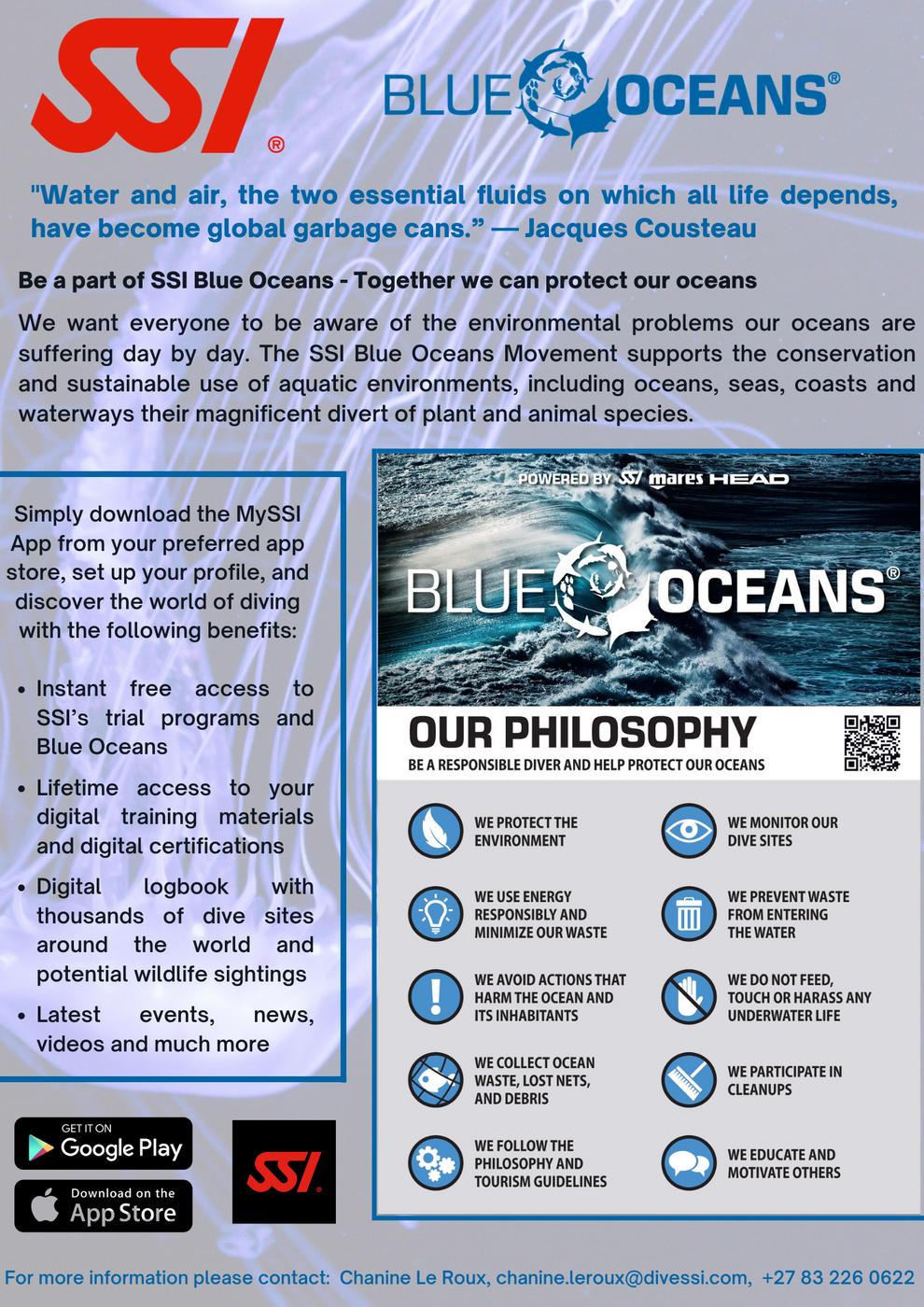
Learning to scuba dive can be daunting; in most cases, new divers must plan their finances to fund the endeavour. The course costs and buying your scuba gear is an investment that not all buy into Having your own equipment saves you money over time, and making good choices will guarantee your underwater adventures for years to come
The offer of used and secondhand scuba gear on online sites has grown into a significant business Many sellers peddle their used, unwanted and old equipment for what sometimes seems like a bargain On several of these platforms, we often find warning messages of buyers and sellers scammed or conned out of their gear or money It can be a
pricey affair Wise up about a few payment methods and be aware of possible scammers
This is why we would say: don't buy second-hand gear New scuba gear is an investment that will serve you a lifetime if you look after it. New equipment is manufactured with new technology and is easier to maintain. This is not only more specific to dive computers and gauges So let's dive in and look at that second-hand scuba gear you bought to see what it would cost to safely take it on your first underwater experience
When you purchase second-hand gear, there are always risks

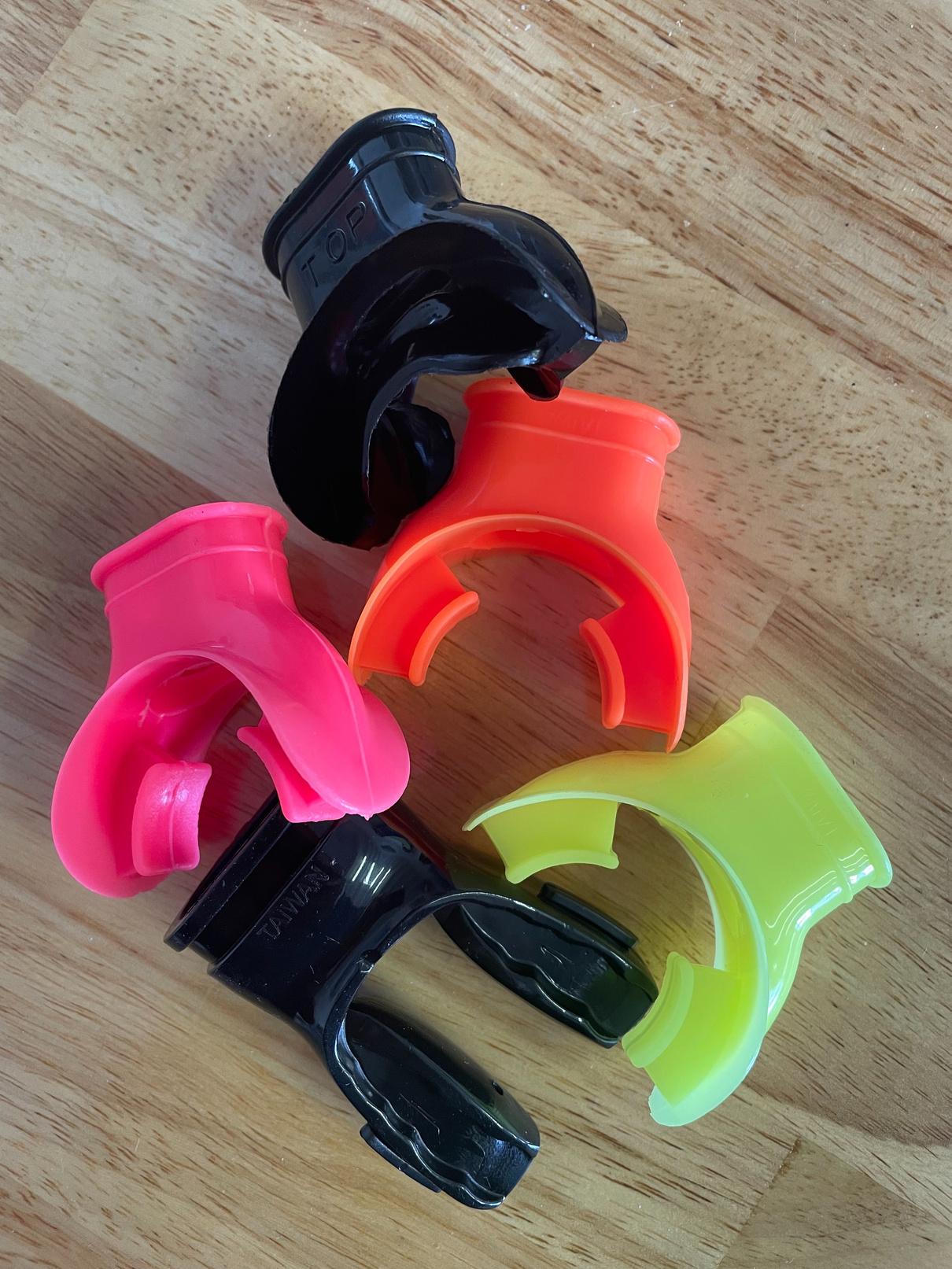
involved. You will need to know what you are looking at and be sure to do your research in the same way you would when buying new equipment Most scuba centres and instructors will prefer you to purchase new gear. There are several reasons to do so. You would say that they could make a neat profit, and yes, they have to; otherwise, they would not be in the business of scuba diving and dive training. New scuba gear utilises the latest in all technologies Internal working parts are made of better quality brass, stainless steel, O-rings and Teflon seats. The designs are improved to last longer if taken care of properly
When you purchase a second-hand regulator set, the best is to make sure that it is serviceable Nothing is more frustrating than having a car that has to be in a service centre because they can not find the parts to do the repairs The same goes for your regulator This is even more important because your life will depend on the equipment in prime working condition. Thus if the seller says it was serviced, ask for proof, and if they can't provide it, best walk away If you have proof, check it and test it again to be sure. Most scuba equipment manufacturers require a certified service technician trained to service and repair the specific brand. An old regulator could delay servicing and repairs if the dive centre has to shop for the correct fitting spares It might be that the regulator model service kit is discontinued by the manufacturer Sometimes, the brand is no longer supported, and service kits are unavailable
The same goes for the demand valves, octos or second stage. Small things can cost a lot to have repaired or replaced Broken face plates, cracked housings and missing exhaust covers will all add to the bill of fixing a second-hand set. Here again, buying new is best. The mouthpieces are made from high-quality silicone rubber, which is softer on your teeth and jaw Modern mouthpieces are more ergonomically designed to better fit in the divers' mouths and are more hygienic. You can also have these custom-made if you ask your dental practitioner. To service, a complete regulator set, including service kits, labour and dependant on the brand, can cost from R1200 upwards
When are dive computers too old? There are many excellent dive computers on the market, and I suggest you buy this as a new piece. New dive computers are far more accurate, and the algorithms are updated with new research to back them up. Their battery life is better optimised, and the lighting system is vastly improved Older dive computers will need a new battery, and some will require it to be sent out of the country to Europe or elsewhere, which could be costly You might need brand-specific computer software to download the dive log or recorded data This can be problematic if the software is outdated and no longer compatible with newer operating systems from Windows, Apple or Linux
In some cases buying a second-hand dive computer could be dangerous to your dive safety The last thing you want to discover is that the dive computer is not in working condition while diving Used computers often have faulty or broken depth sensors, which can only be tested in water under pressure. Most used computers require battery changes and strap replacements, adding to the cost Analogue depth gauges are much more straightforward, which makes it easy to spot a broken or damaged gauge.
Most divers will know that two types of hoses are fitted to their regulator set The high-pressure hose that connects the first stage to the air pressure gauge is as essential as the low-pressure hose that links the regulator to the air supply of your cylinder It might look great, but once it is connected to the highpressure air supply, this becomes evident with hissing air leaks Hoses have a limited lifespan indicated by manufacturers printing the date of fabrication on the hoses The life expectancy of most hoses is, on average, 5-years Equipment regularly used should be routinely checked for wear and tear or damage. Be aware that broken or faulty hose connections can be hidden under hose protectors The cost of new hoses depends on the type of hose. High-pressure or lowpressure hoses and material compositions such as Kevlar reinforced and braided hoses will also affect



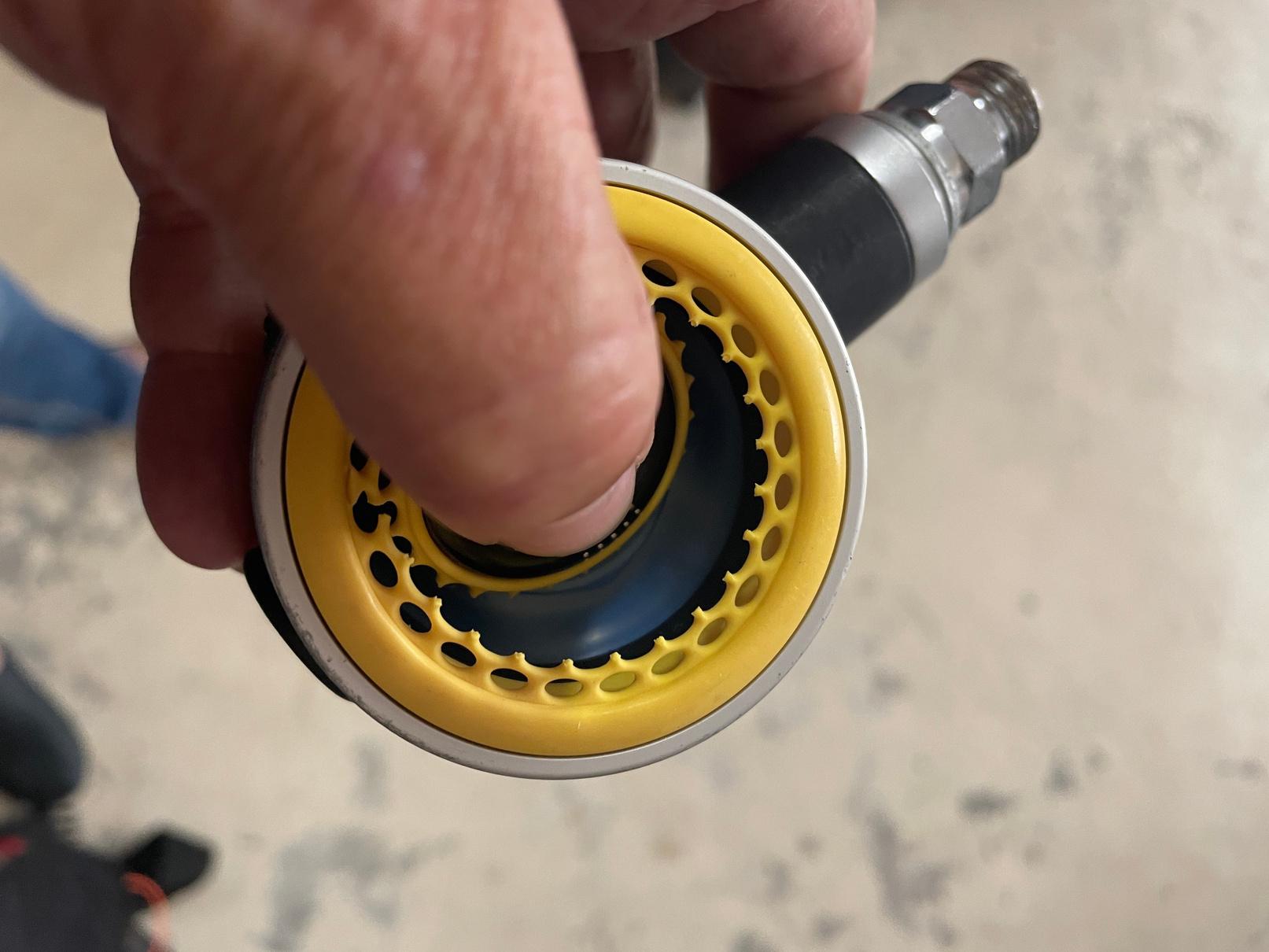

the cost of getting your regulator dive ready.
Scuba cylinders hold the air that we breathe The cylinder strapped securely onto your BCD is the one thing many divers neglect to consider as an integral part of their equipment. Scuba cylinders are either steel or aluminium, and both have advantages and disadvantages. Regardless of type, they should be visually and hydrostatically checked and serviced The legalities of this differ from country to country Most test facilities will inform the owner of problems and irregularities in a report Cylinders that don't adhere to the stresses and guidelines of the required tests will be condemned Visual and hydro testing of cylinders does not include valve service; on second-hand cylinders, the valves are usually very neglected or damaged
Owning your own scuba equipment contributes to your safety in several ways. The equipment you buy is more apt to fit just right, and you're more likely to become familiar with how it's configured and how to use it Above all, new scuba equipment will motivate you to dive more and plan those exquisite dive holidays that will make it stand out on your social media posts for years to come Having your own equipment fitted to you will make you a better diver and make you want to learn more about diving and the underwater world. You don't need to buy it all at once. If you are cashstrapped or need help deciding what equipment to invest in, consider renting dive equipment from dive centres and resorts you plan to dive with until you are ready to take the next step

DSMB stands for Dive Surface Marker Buoys and SMB for Surface Marker Buoys, both of which are common and essential safety devices These brightly coloured, inflatable tubes, sometimes called safety sausages, are critical pieces of equipment that divers should take on most dives, especially dives involving extended travel into the ocean, and when they are high swells or poor visibility conditions. Divers most often use them as signalling devices to mark their locations below the surface and alert boat traffic Technical divers may use a DSMB as an upline to fulfil their decompression obligations Rescuers might deploy them in the event of a distressed diver, like how a lifeguard would use a rescue tube on the surface There are several myths and misconceptions about DSMBs, and many divers use them improperly and ineffectively.
A DSMB is technically an SMB, but an SMB is not a DSMB. Divers deploy a DSMB mostly while still underwater thanks to an over-pressurisation valve (OPV) This valve allows air to escape and relieves the gas that expands, according to Boyle’s Law. Without an over-pressure relief valve, Boyle’s law.

Without an over-pressure relief valve, Boyle’s law would result in over inflation or rupture of the SMB So, design determines the application, and specifically where they should be inflated - at the service or underwater This article will refer to DSMBs as their applications and features are more extensive than their SMB counterparts DSMB’s are also typically designed not to be too bulky, for obvious reasons
DSMBs are available in various sizes, shapes, and colors some are more practical than others A 1 2 meter DSMB is sufficient for most divers learning deployment techniques for training purposes. Outside of a training environment, however, divers should use at minimum a 1 8 meter DSMB, which provides better visibility and surface support by other boats as well as the divers original dive boat. This is particularly important in unfavourable seas with large swells It also offers sufficient lift to avoid being dragged underwater while the diver is ascending.
Orange and yellow are the most common colors and offer the best visibility, but there is no industry-standard color. DSMBs are also available in pink, white, green, and even black, studies support orange or yellow Some manufacturers add reflective strips and a thin, clear sleeve at the top to accommodate a strobe or chem-light for deployment in low light conditions
Some divers designate specific DSMB colors to communicate different messages to surface support personnel This practice is most common in technical diving For example, an orange DSMB may communicate that all divers are accounted for and okay, and a yellow DSMB may communicate some emergency A slate or an underwater notebook page attached to the yellow DSMB can specify the problem and describe the required intervention measures from surface support Of course, this system only works if all divers agree upon one predefined plan
Regardless of the color, all divers should consider writing their names in large letters on their DSMBs so surface support can more easily identify the diver below.
Some divers are adamant about using a reel instead of a spool or vice-versa. Divers should weigh the pros and cons of each and decide based on their personal diving needs Each has its advantages a reel is easier to deploy, but a spool is more difficult to jam
Divers also debate whether to permanently attach (pre-rig) a spool or reel to the DSMB to ready it for rapid deployment or leave it to assemble underwater. Should a diver clip the DSMB directly onto their BCD or store it in a pocket or pouch? Every diver should evaluate their needs and decide which option is the most practical for all these considerations.
There are strong opinions about inflating a DSMB Should you orally inflate it? What about exhaling from your second stage or purging the octopus into the open bottom? How about attaching a low-pressure inflator from Drysuit or BCD? All methods are viable with proper training and regular practice.
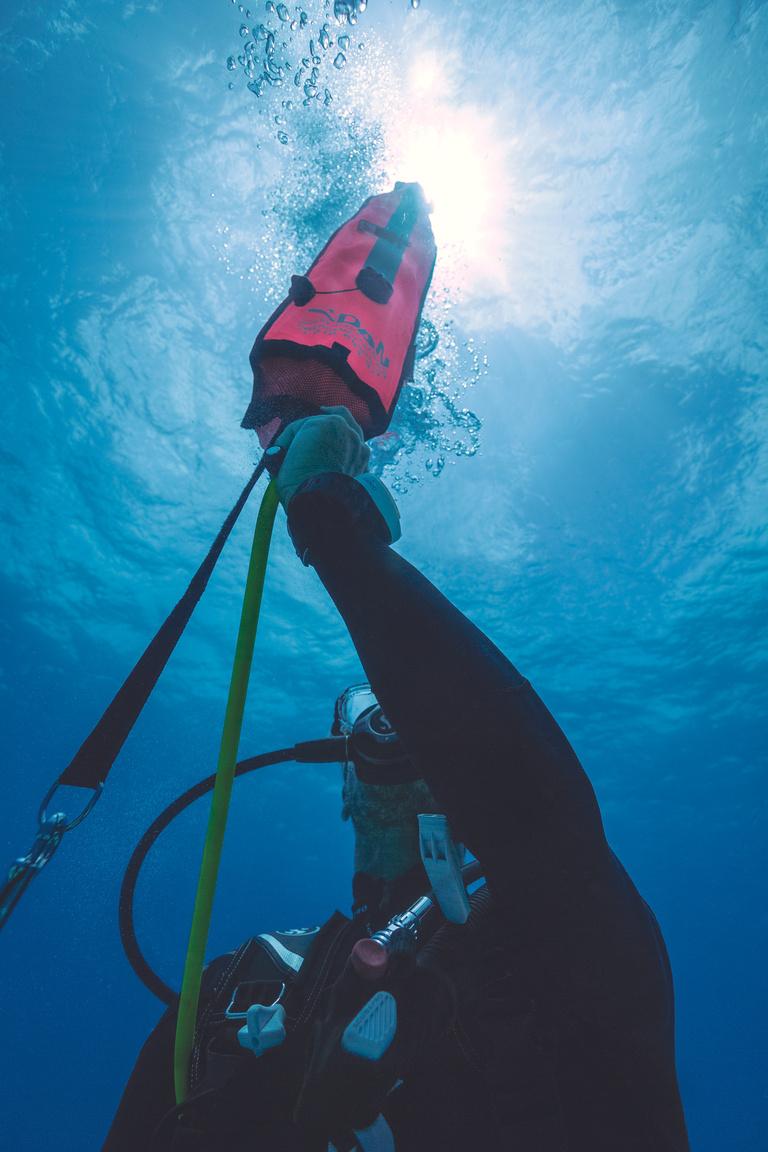
There are a few universal safety concerns to address whenever using a DSMB Divers should never clip the reel or spool to themselves during deployment because if it jams, the excess buoyancy could cause a rapid ascent. If you clip the reel or spool after the DSMB is already on the surface, a passing boat or curious topside passerby could yank the line, again causing a rapid ascent
Throughout deploying a DSMB, remember that slow is smooth, and smooth is fast. Divers should keep all lines taut and as far away from their bodies as possible Maintaining this distance will decrease the likelihood of entanglement If there is excess slack in the line, take a moment to resolve it Issues can compound quickly, and the line is unforgiving if a diver becomes entangled.
Divers should have an easily accessible cutting device available every time they deploy a DSMB If possible, a dive buddy should be nearby to intervene in the event of a failed or disrupted deployment. Safety scissors are better than knives as a general rule.
Most important, divers must practice Becoming proficient at deploying a DSMB takes time. Go to a local pool or other confined water location with your buddy and practice each step of the process, identifying areas of deficiency. Ask instructors and mentors for help Do not be afraid of failure, as that is how learning and muscle memory occurs At the end of every dive, consider deploying a DSMB Repetition creates proficiency and comfort with a skill that every diver should possess


Scuba diving is a highly gear-dependent activity. But like divers themselves, dive gear ages It can become obsolete as newer models replace gear with improved features and safety When should you consider replacing expensive items like your dive computer or that well-worn BCD? The answer is: it depends

COMPUTER LOVE | Divers don't buy new dive computers yearly, so it is not uncommon to see older computers on dive trips But just because those models were the best options 15 years ago doesn't mean they're ideal to use now. New technology has improved computer processing power, battery life, sensor sensitivity and display screens.
Older dive computers are often unable to implement newer decompression algorithms fully; modern computers are more powerful and, in many cases, can better compute a more faithful rendition of the underlying algorithm Modern sensors can detect even slight changes in pressure and register changes in water temperature in a tenth of the time it takes those in older dive computers This improvement provides more
accurate water temperature, depth and ascent rate estimates However, the dive computer's physical design can affect these measurements and measuring depth to the nearest inch of seawater may not have any practical impact on safety.
Many manufacturers will factory test dive computers for accuracy, so DAN recommends that divers contact the manufacturer of any dive computer that is ten years old or older or has made 1,000 or more dives and ask if it should be tested for accuracy Years of diving can take their toll on computers regarding wear and tear, sun and salt water exposure, being dropped and other neglect
As our dive computers steadily age, so do we Many newer dive computers have sharper screens that are brighter, have larger numbers and are more intuitive to use than older models hint, hint worthwhile reasons to add a new dive computer to our wish list
B-C-D, EASY AS 1-2-3 | A comfortable and good-fitting BCD can give us years of reliable service Do a few scuff marks or a broken clasp or two signal the end of its usefulness? Not necessarily Does a BCD have an expiration date?
We rely on our BCD to ensure we have both a comfortable and a safe dive; a BCD failure could have dire consequences when we most need to control our buoyancy, so we need to monitor the BCD's condition as well as its age. In general, we might provide a cursory inspection of our BCD before and perhaps after use, but we rarely consider getting them serviced.
Before using your BCD, especially when using it for the first time in many months, inspect the condition of the inflator hose, check the materials for degradation, fully inflate and inspect the seams for leaks and dump valves for function, and look for any significant scuffing or tearing. The inflator and dump valves must be serviced periodically, especially as the BCD ages Annual inspections are a good standard of practice, especially for BCDs in use for five years or more.
While BCDs don't have an explicit shelf life, it is essential to carefully and regularly monitor their condition, particularly their working parts Suppose the hose is sound with no signs of cracking In that case, there are no leaks, buoyancy control is good

andyouservicetheinflatoranddump valves annually after the first five years of use You should still have a reliable BCD A good service technician will alert you of any embrittlement of the plastic parts, orings,cracksinthehosesorexcessive wear and tear. Keep an eye out for leaks and cracks, especially if your BCD is more than ten years old If fashion or function doesn't prompt you to retire your old BCD, just be sure you stay alert for any warning signs that its functionality, and consequently your safety, may be compromised
Dive computers and BCDs are expensive, making it very tempting to keep using the ones we own yearly But don't be complacent Use your own good judgment, and your service technician's to determine when it's time to replace your old BCD or dive computer.
ABOUT THE AUTHOR | AlertDiverEU contributing editor Michael Menduno is an award-winning journalist & technologist who has written about diving and diving technology for decades He coined the term "technical diving" His work has appeared in magazines such as Alert Diver, DeeperBluecom, DIVER, Quest, Scientific American, Sports Diver, Undercurrent, Undersea Journal, WIRED and X-Ray He founded and served as editor-in-chief for aquaCORPS Journal (19901996) which helped usher tech diving into the mainstream of sports diving He also produced the first Tek EuroTek and AsiaTek conferences In addition Michael serves as the editor-in-chief of InDepth GlobalUnderwaterExplorers(GUE)onlinemagazine
 P A R T 3 - T R E A T I N G
P A R T 3 - T R E A T I N G
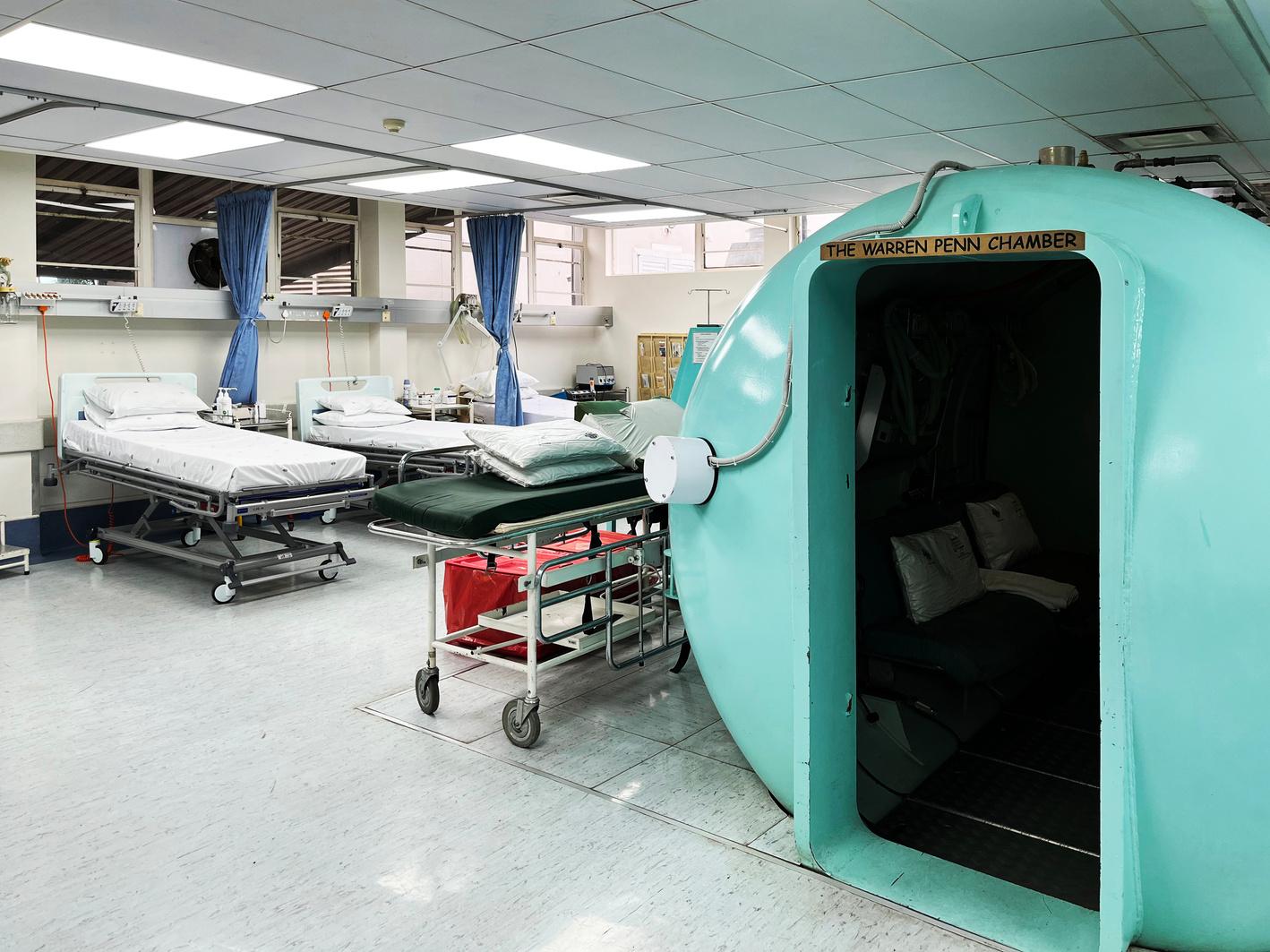 By Dennis Guichard With edits by Dr Frans Cronje
E D U C A T I O N
By Dennis Guichard With edits by Dr Frans Cronje
E D U C A T I O N
The very pinnacle of sub-sea and hyperbaric medicine rests with the hyperbaric physicians who practise it daily, treating chronic wounds and urgent maladies. There are no easy clinical tests that can confirm decompression sickness (DCS), and so it is often the incredible lifetime-gained talent and experience of the hyperbaric physicians whom we rely on to make a sound clinical judgement in prescribing an adequate course of treatment to ensure our well-being
Dr Craig Springate is the attending physician at the Netcare St Augustine’s Hospital Hyperbaric Medicine and Wound Care Unit in Durban, South Africa, assisted by Hyperbaric Manager and Medic Chad Katz, his two most charming and goodhumoured assistants, Sharon, and Debbie, as well as a host of amazing chamber attendants who freelance their time as demands require
Fortunately, DCS seems to be rare, occurring at less than perhaps 2 cases per every 10,000 dives whilst cold water diving and deep technical decompression diving risks can be substantially higher at as many as 28 cases per 10,000 dives.
However, a concern worldwide is that mild cases may often not be reported, so the real picture of DCS risk and occurrence may be well understated.
DCS is related to the individual physiological response of any diver to any specific dive profile and resultant bubble loading We are each quite bio-individual, so the risk is different and individualised for each of us A dive profile that might be 'safe' to one diver might be 'risky' to another not just because of the profile itself but also because of our physiological state and variable predisposing risk factors on any given day
Frequently we might even experience mild symptoms of DCS and brush them off, conveniently losing ourselves in denial, when the risk, however, is that mild symptoms can often progress into something more serious that can have residual impact.
Skin bends are a distinct manifestation of decompression sickness that can start with intense localised itching of the skin, followed by the development of its distinctive reddish blue mottling appearance The condition can cause hypovolemic shock requiring extensive IV fluid administration (not unlike a burn wound), resulting from capillary leak syndrome, reduced blood flow, and impaired oxygen delivery to skin tissues, triggering inflammation secondary to the development of intravascular bubbles after provocative dive profiles
Livedo Racemosa (skin bends) is almost always directly associated with the existence of a significant PFO/Patent Foramen Ovale (hole in the heart) in the patient diver, which can often be confirmed with contrast echocardiography by a qualified specialist. The condition has incorrectly long been considered a 'mild' form of decompression sickness However, it is now more widely respected for the very serious condition it is that can often even be life-threatening.
The time from surfacing to the presentation of symptoms can often be a good rule-ofthumb indicator for the likely severity of the bend - the sooner the signs, the more likely the severity of the hit There is a significant correlation between the severity of DCS and the resultant outcome for recovery often with persistent deficits after completion of treatment for neurological DCS
Primary first aid offered by dive leaders is critical in the treatment process through the administration of 100% oxygen at 15lt per minute flowrate via a non-rebreather face mask and the administration of fluids. It is also thus critical that all dive leaders are suitably trained and equipped in the recognition and treatment of DCS first aid and always call the DAN helpline (phone: +27 82 810 6010 in South Africa) to get reputable guidance on any suitable course of action
There is a hypothesis that historically suggested that Aspirin might be protective against the progression of DCS by inhibiting platelet adhesion (clotting) on vascular microbubbles but the risks for worsening serious neurological manifestations through central nervous system bleeding in the brain or spinal cord, now widely rule out its administration unless prescribed as such by a hyperbaric physician.
In milder pain-only or joint cases of DCS, the success of treatment is generally measured by the resolution of symptoms in the chamber, so the administration of any form of analgesia (Aspirin, Paracetamol, etc ) may also interfere with the ability of the hyperbaric physician to assess healing.
Steroids can sometimes be helpful in the clinical setting for reducing tissue oedema (fluid retention), ischaemia (insufficient blood supply and tissue oxygenation), and intravascular platelet aggregation but are generally not recommended to treat DCS
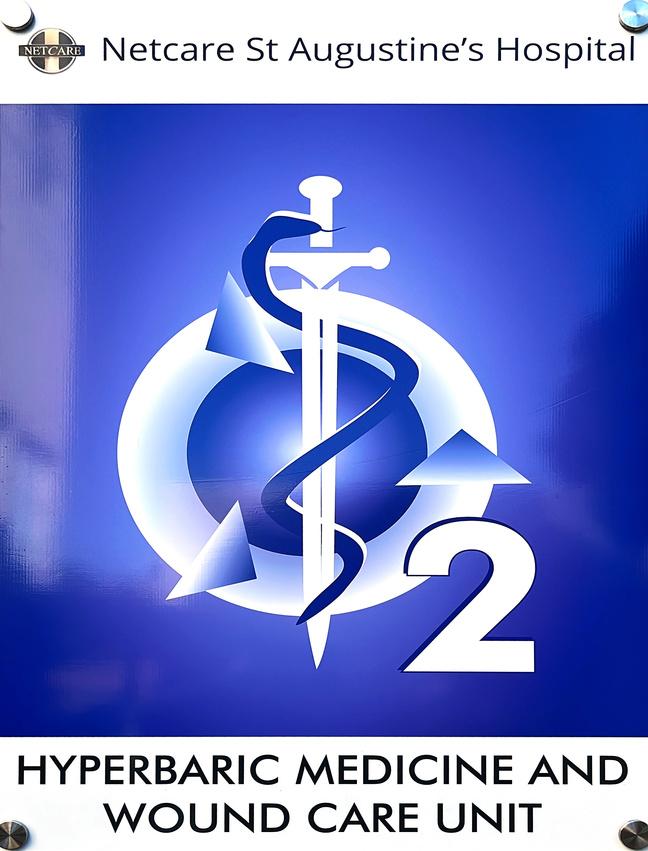
Heparin can sometimes also likewise be prescribed by the hyperbaric physician as an anticoagulant for immobile or paralysed cases of severe neurological DCS.
Lidocaine can sometimes be helpful in severe cases of neurological decompression sickness because of its anti-inflammatory effect, although there is arguably insufficient clinical evidence to encourage its use. The hyperbaric physician can sometimes prescribe tenoxicam to resolve pain because of its anti-inflammatory benefits
For 'mild' cases of pain-only joint or musculoskeletal decompression sickness, US Navy Treatment Table 5 can sometimes be specified by the hyperbaric physician in a twin-lock multi-place hyperbaric chamber. Table 5 is one of the shorter treatments lasting only 2-hours and 15-minutes; however, the risk with DCS is that what might initially present as 'mild' clinical symptoms can often progress into more serious neurological complications.
A quick Treatment Table 5 protocol may not always be sufficient to alleviate a need for ongoing repetitive chamber visits with decompression sickness that can sometimes persist in playing up with recuring sequela, so the default for hyperbaric physicians is often to opt for the more extended Treatment Table 6 instead, which lasts 4-hours and 45minutes
There is an endless suite of treatment tables available to any hyperbaric physician developed by the US Navy, British Royal Navy, COMEX, French Navy, Russian, German, and others Specific tables get used depending on the clinical presentation of symptoms as well as in response to how patients recover during those treatments
In South Africa, we have SAUHMAaccredited mono-place hyperbaric chambers available in Pretoria, Johannesburg, Cape Town, and Bloemfontein, with larger multi-place chambers in Durban and Port Elizabeth The Simon's Town Naval Hyperbaric
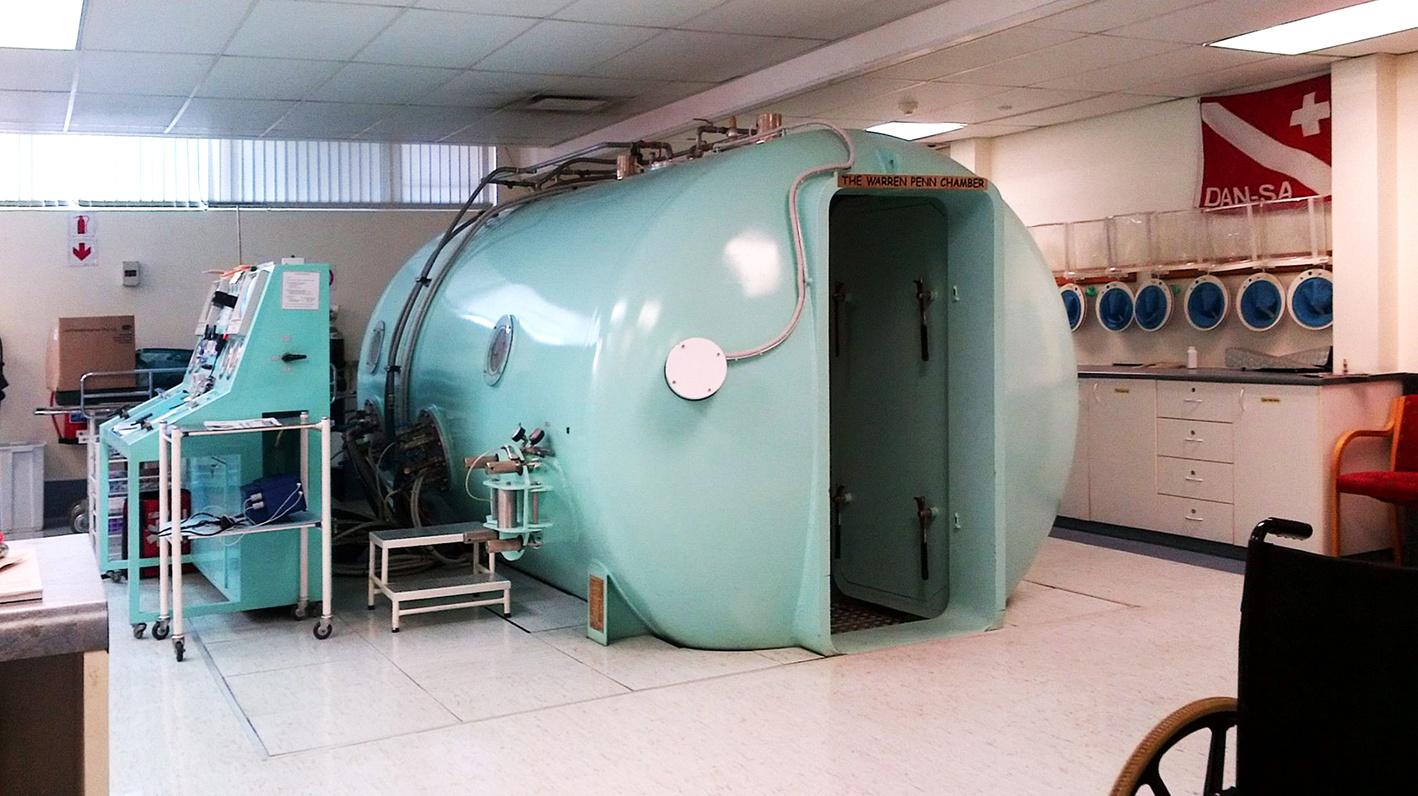
Facility, and the Institute for Aviation Medicine in Pretoria, also have multi-place chambers available, although for military patients only
There is often a risk that symptoms can wax and wane, so it can be challenging to establish a fixed endpoint of treatment, especially when a percentage of serious DCS cases can result in residual symptoms that might never completely heal The successful outcome of treatment is often related to early recognition of signs and symptoms, the initial severity score of the bend, the initiation of adequate on-site first aid by the dive leader, and swift evacuation to a hyperbaric chamber facility following the DAN Helpline guidance
The hyperbaric physician is a critical key in the swift treatment of decompression sickness, identifying what medication might best ensure the ultimate residual outcome, patient comfort during treatment, and which hyperbaric Treatment Table might best treat the disorder
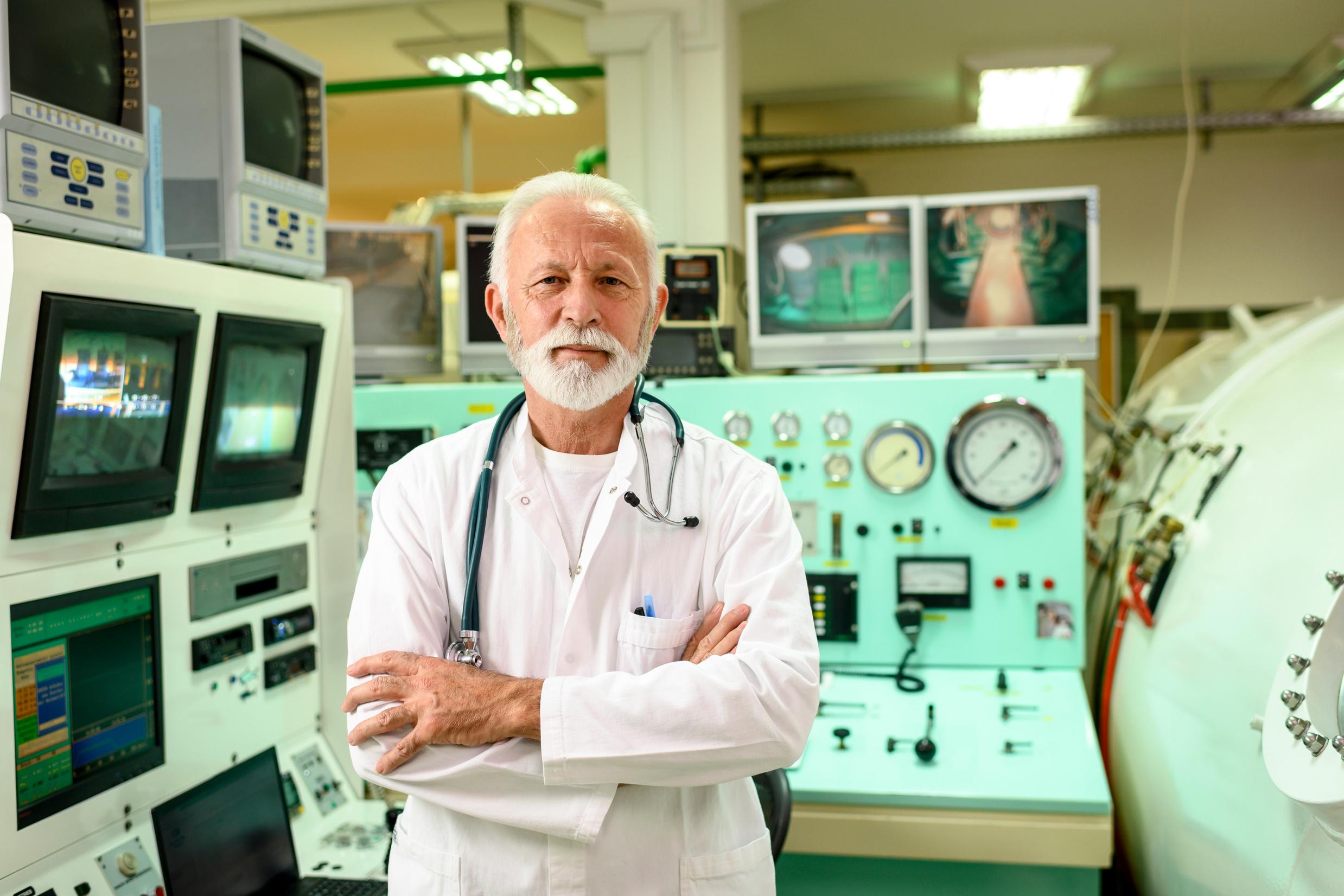

I must be honest and clarify upfront that I’m a total shallowwater diving whimp I’m not against taking risks if those are adequately calculated and prepared for but I do feel much more comfortable frolicking in the shallows than I do in the depths. I just know that if I have any equipment malfunction that I’m in relatively safe reach of the surface, and the corals & fish life are frequently so much more abundant on the shallower reefs
I do however have the utmost respect and admiration for the people doing deep water dives and there is unavoidably a part of me, as I’m sure is equally true for many, that is attracted to the deep water perhaps in just conquering all the technical challenges of getting there and back safely.
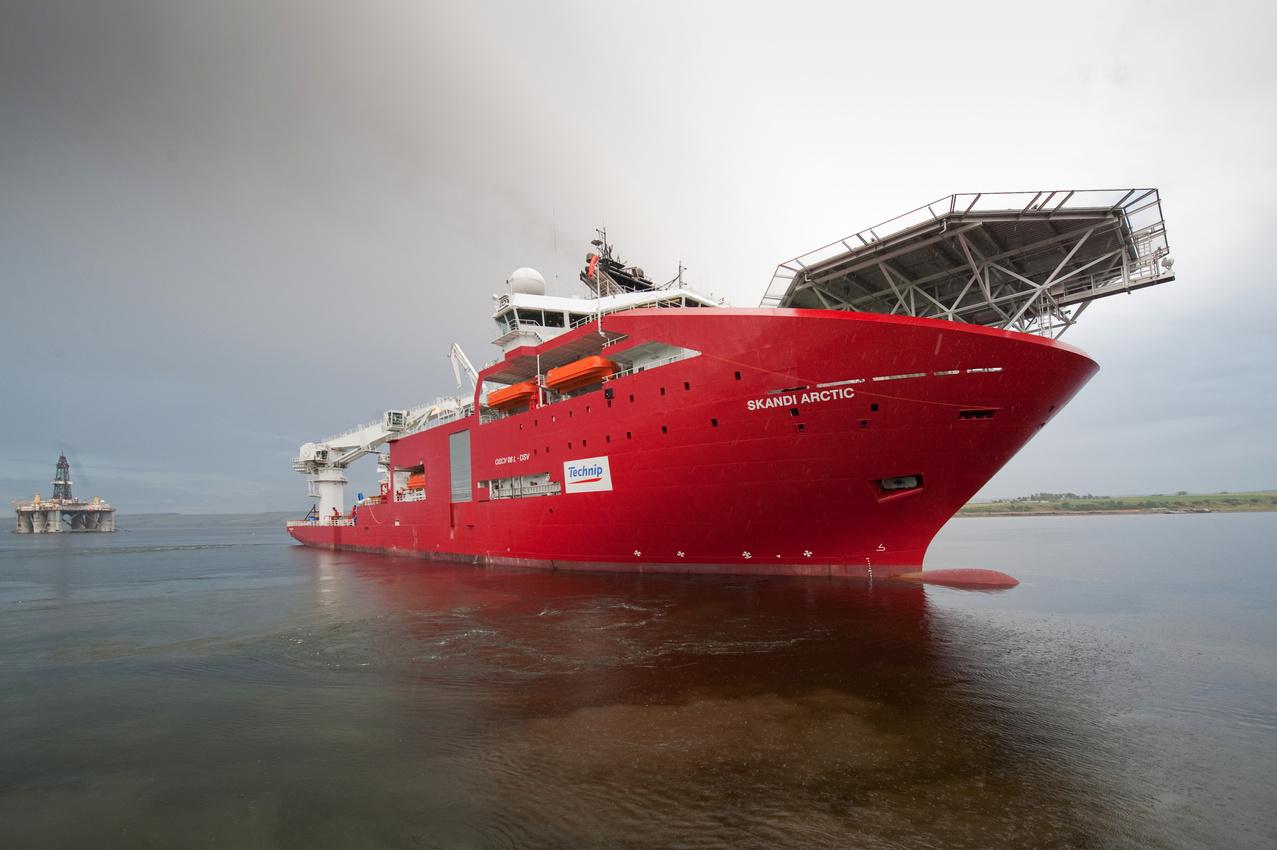
Understanding the human limits of deep-water saturation divingDennisGuichard is qualified as an Integrative Nutrition Health Coach with advanced gut health and hormone optimisation certification He is also an IMCA Assistant Saturation Life Support Technician, HSE Offshore Diver Medic, and a DAN ‘Master Dive Pro’ member He freelances as a Hyperbaric Technologist at the Netcare St Augustine’s Hyperbaric Medicine and Wound Care Unit in Durban, South Africa
When most of us think about shallow versus deep diving, our fathoming thereof is limited in conversation to water perhaps shallower than 18m depth, in comparison to the deep-water technical diving that some people are frequently doing closer to 100m depth But then there are recreational divers also pushing the utopia of that depth concept to the extreme with open-water scuba and closed-circuit rebreathers to over 300m depth. And then again there are commercial saturation divers who are pushing the very boundaries of what seems possible with human limitations currently as deep as 701m depth.
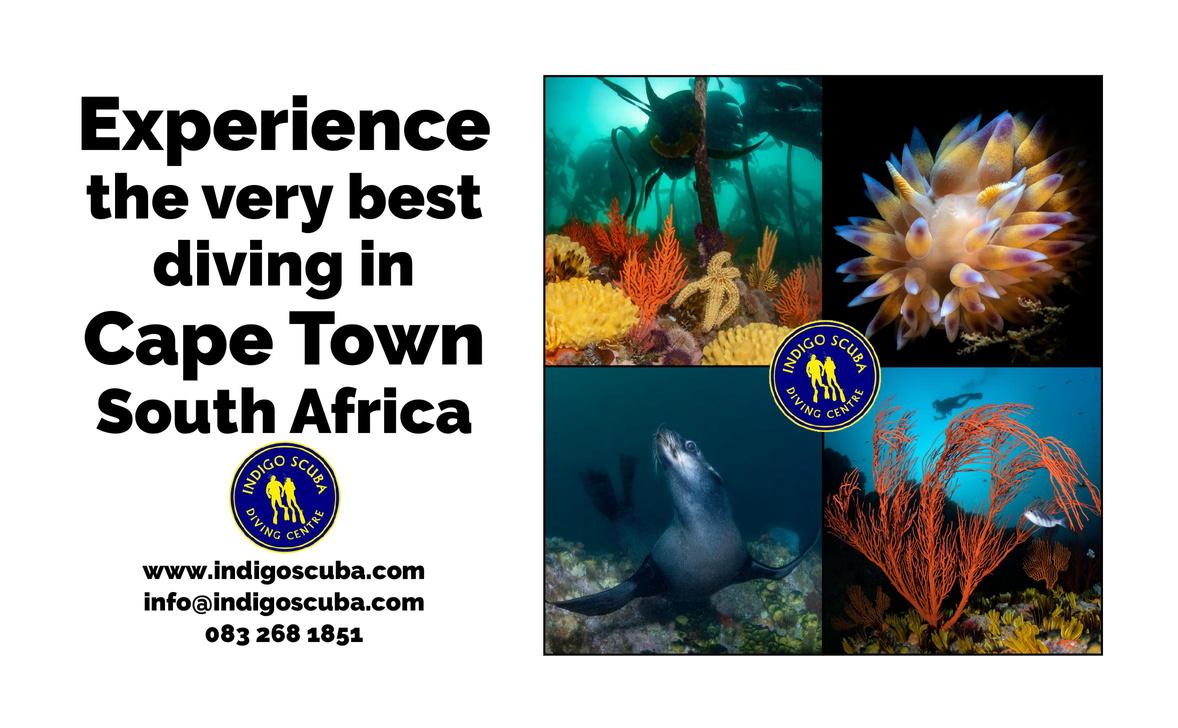
As far back as 1959, diver Hannes Keller became interested in extensive deep diving and started developing tables for mixed gas decompression. Not a diver himself, the now-famed physician Professor Albert Bühlmann became intrigued with the project and got involved helping develop the algorithms and gas mixtures to support that work
Keller successfully tested the new Bühlmann gas mixtures and decompression tables in Lake Zürich where he reached a record water depth of 120m, and then again in Lake Maggiore in Brissago, Switzerland, where he reached a water depth of 220m (1961) with diver Damian McLeish.
Professor Bühlmann was central to much of the early work that made deep water diving possible and many new depth records were established over time by numerous divers using his decompression algorithms: In December 1960 a depth of 250m was achieved in the French Navy chamber in Toulon. In December 1962 a depth of 305m was achieved by Hannes Keller in California with the US Navy In October 1966 a depth of 220m was achieved off Italy with a Capshell saturation expedition And in February 1969 a depth of 350m was achieved off the coast of England near Alverstone.
In 1975 a revolutionary new 1,000m capability hyperbaric chamber was opened at the University of Zürich funded personally by Professor Bühlmann, also with the support of Canton of Zürich, the Swiss Confederation, the French Military, and Shell International In February 1981, dive No 373 reached 575m depth pressure in the Zürich chamber. It was a revolutionary achievement for that early time.
But deep diving isn’t without its risk and challenge - divers face a host of debilitating physiological and psychological challenges when their bodies are subjected to the intense pressures at those limiting depths.

The deep dive record for open-circuit scuba currently stands at a staggering 332.35m depth, set by Ahmed Gabr in the Red Sea in September 2014 The descent to that depth took 15-minutes whilst the ascent took some 13-hours and 35-minutes with all his decompression obligations
Prior to that the depth record had been held by Nuno Gomes with a dive to 318.25m, also in the Red Sea in 2005, although Nuno still holds the record for the deepest cave dive at 282.6m depth (a 339m altitude-adjusted sea level equivalent depth), set in 1996 at Boesmansgat in South Africa The woman’s deep diving record was also recently broken in Boesmansgat on 27th October 2022 by Karen van den Oever with a dive to 246.65m depth, breaking her own previous record dive to 236.04m depth.
According to Wikipedia there are only 21 recreational/technical divers who have ever descended below a depth of 240m on either open or closed-circuit scuba The holy grail of open water diving below the 300m limit has reportedly only been achieved six times since John Bennett first broke that barrier in 2001. The deepest dive record of 316m, on a closed-circuit rebreather, was set by

Jarek Macedoński in Italy, on 10th October 2018.
Defying all the odds of nitrogen narcosis and central nervous system oxygen toxicity, Dan Manion amazingly set the current record for a deep dive on air at 155m depth Manion reported he was almost completely incapacitated by nitrogen narcosis and has no recollection of his time at that depth.
The list of names of divers who have attempted setting various deep-water records, but died in the process, is sadly an extensive one The deep is not for the feint hearted
The realms of ‘properly deep’ diving however belong to the superheroes of commercial diving - the saturation divers They who can master the deep likewise master a substantial commercial and financial advantage over their competitors and so the race to develop technologies and decompression algorithms bespoke to those challenges has been a fiercely contested one There are seemingly few organisations who have the capability to do saturation dives to even 300m, so the realms of achieving dive depths deeper than that to perhaps 500m, or up to a 1,000m, are even fewer again
Technology is perhaps the ‘simple’ part, as we already have that available to permit us access to the deepest oceans, with Victor Vescovo achieving a manned-vessel depth of 10,927m at the base of the Mariana Trench in April 2019. Putting humans into the water is however quite another challenge altogether limited it seems by the body’s capability to cope with the immense hydrostatic pressures
In regular scuba diving we are limited by progressive risk of incapacitating nitrogen narcosis at anything over perhaps 18m depth and limited beyond 30m on air because the exertion of breathing enhanced gas density beyond 5.2g/litre at that depth can trigger an exponential risk of carbon dioxide build-up in the body Carbon dioxide can also have a narcotic impact on our ability to think clearly as it has a narcotic potential 20-times more than nitrogen, causing increased blood flow to the brain and heightening our risk of severe neurological decompression sickness
In dives below 50m depth, a reduction in endothelial function of the pulmonary arteries commonly occurs Interestingly the mechanisms were shown to be different between males and females with the dysfunctionality occurring more severely in males from a change in nitric oxide bioavailability, whereas in females there was a resultant imbalance of circulating prostanoid signalling hormones which function to control vasoconstriction and are mediators of inflammatory reactions.
In dives to 60m performed by the Poland Naval Academy in 2021, elevated biomarkers of endothelial dysfunction (ICAM-1 and VCAM-1) were identified These help regulate inflammation-associated vascular adhesion and the migration of white blood cells to repair endothelial damage The endothelium is sensitive to oxidative stress and these biomarkers might be a key measure as a decompression sickness stress marker.
66m depth is of course the maximum recommended depth for dives on air because of the high risk of central nervous system oxygen toxicity convulsions, let alone the severity of nitrogen narcosis at this depth.
In deep technical and commercial diving beyond 50m depth, it is common to dilute the nitrogen component of our breathing gas with a less narcotic inert gas like helium
This permits us to dive deeper with a clearer mind but from around 150m depth helium itself becomes problematic in causing high pressure nervous syndrome (HPNS). HPNS manifests with hyperexcitability, tremors, changes in brain wave electrical activity, alterations in cognitive function, and even convulsions at more extreme depths.
Strategies to minimise HPNS include slowing the descent rate on compression, including stage stops to permit diver acclimatisation, limiting excessive oxygen partial pressure, and diluting the helium with other inert gasses like nitrogen or hydrogen, although those equally each have narcotic potency of their own. Diver selection is also key for deep water saturation operations as individual susceptibilities are common and dive teams are often carefully selected by saturation supervisors to suit the dive operation intended.
Incorporating these dive management adjustments has permitted divers to achieve depths of up to 534.4m (Comex Hydra 8 excursion in 1988) in the Mediterranean Sea, as well as a record simulated depth pressure of 701m in a hyperbaric chamber. However, despite these strategies using various gas mixtures, many exploratory dives have had to be aborted because divers have often experienced psychotic disorders like hallucinations and delirium, which seem to be as a result of the combined various narcotic potencies of the mixed gas solutions As you solve one problem you invariably create another it seems.
In a saturation dive to 273m in July 2017, the deepest performed in Australian waters, many of the dive team reported suffering hallucinations, nausea, tremors, and cognitive impairment, allegedly due to too rapid descent procedures, that seems to have left many with residual injury and which has resulted in legal proceedings against the dive operator by the Commonwealth Director of Public Prosecutions in Australia.
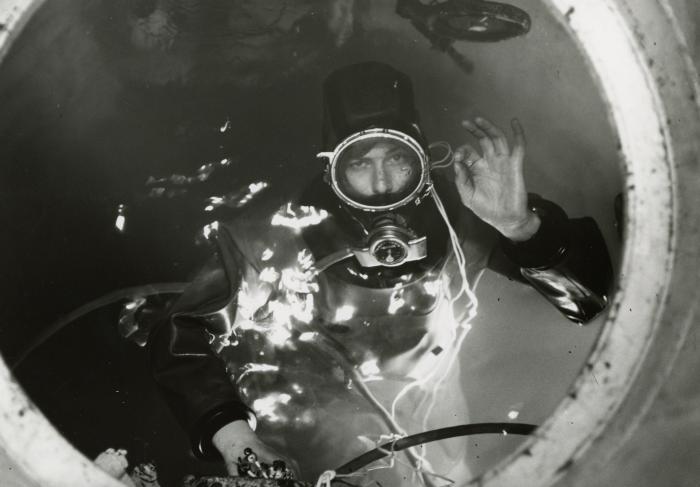 HANNES KELLER
HANNES KELLER
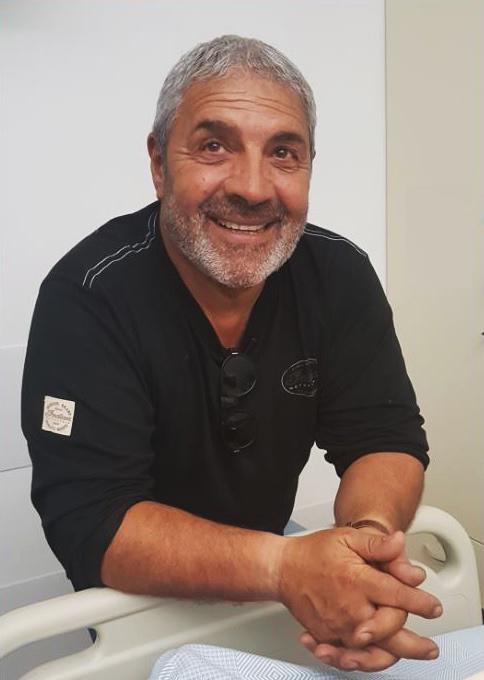
In dives beyond about 260m it has been seen that divers can also experience ‘nocturia’ where they have sustained diuresis needing to urinate endlessly and thus suffer from disturbed sleep that quickly leads to exhaustion With dives from about 450m depth, disruption in EEG brain wave activity has been seen as well as disruption of REM sleep and awake cycle periods ultimately leading to diver exhaustion.
In deep saturation dives at 500m depth, a decrease in small airway and diffusion function was shown through a Chinese study, with divers suffering decreased Forced Vital Capacity and Forced Expiratory Volume for up to 3-days post dive, thought to be induced through airway lesions.
On 20th November 1992, Greek diver Theodoros Mavrostomos achieved a chamber dive depth of 701m with the French COMEX Hydra 10 operation, breathing a mixture of Hydrogen/Helium/Oxygen (Hydreliox), after the rest of this team were held incapacitated at 675m depth. The slow controlled descent for that dive took 13-days, the team spent 3-days at 675m depth pressure with a short 2-hour excursion to 701m by Theodoros, and then took just over 23days of decompression time to get back safely to the surface. A remarkable achievement that hasn’t been matched or surpassed now for 30-years
Because of the limiting constraints of psychotic-like disorders due to inert gas narcosis at great depth, regardless of the gas mixtures used, it is estimated that the maximum operating depth limit for humans might be in the region of 1,000m depth. Even with the administration of inhalational anaesthetics it is estimated that no human dives would be possible beyond 1,200m depth even in divers showing a low sensitivity to Hydreliox narcosis
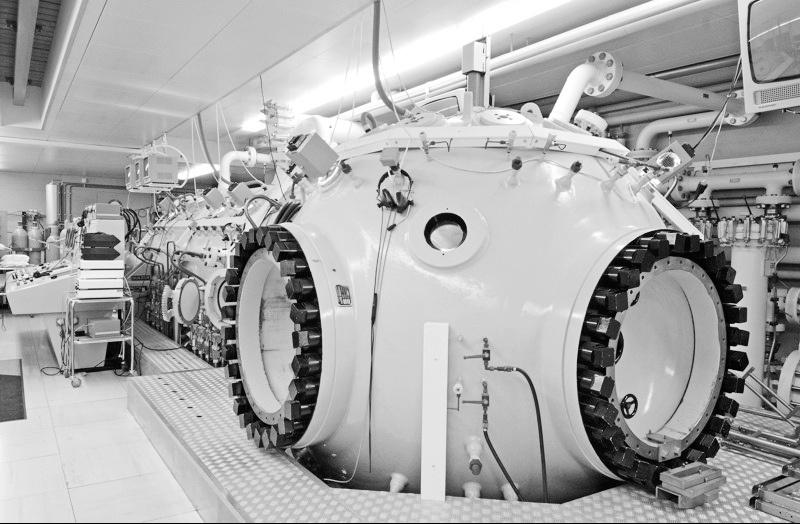 PROFESSOR BÜHLMANN’S 1,000M CHAMBER AT THE UNIVERSITY OF ZÜRICH
PROFESSOR BÜHLMANN’S 1,000M CHAMBER AT THE UNIVERSITY OF ZÜRICH
DAN’s new Safety Tips for Dive Operators guide identifies some of the risks involved with running a dive operation and what can be done to mitigate them. It outlines minimum safety standards for various aspects of dive operations and provides a foundation for refining safety protocols by offering dive safety officers and other dive pros a tested approach for assessing safety and modifying practices to prevent incidents and limit liability.


It was a beautiful, warm Saturday in the Pacific Northwest We were conducting two checkout dives for an advanced openwater course at a popular dive site in Puget Sound. I had just gotten some divers out of the water. We debriefed onshore as divers from an introductory open-water class exited the water with their instructor One of the divers, an older man, looked a bit distressed as he hiked up the slight embankment to the parking lot He started coughing as he came up the hill I noticed but initially dismissed it as a regular, minor cough and continued working with my students
A couple of minutes later, he and a couple of other students from his class sat down near our class, and I heard the cough again This time it caught my attention I could hear there was something entirely wrong
Hisinstructorwasstilldownbytheshoreassistinghis other students, so I decided to step in. As I approached him, he coughed again, and when he removed his hand from his mouth, I noticed a pink, frothy substance. I performed a quick, primary assessment and immediately called for some oxygen. Mydivemasterdeliveredthekit,andweproceededto administeroxygenusingademandvalveasthediver wasresponsiveandbreathing.
Theinstructorcameupaswestartedtheoxygen We advisedhimofthesituationandthatwehadalready called911 Weperformedasecondaryassessmentand continued monitoring the injured diver until the ambulancearrivedafewminuteslater Aspartofthe secondaryassessment,weconductedaS-A-M-P-L-E survey (signs/symptoms, allergies, medications, pertinentmedicalhistory,lastoralintake,andevents leading to the current situation) The only sign or symptom was a productive cough with pink, frothy sputum Theinjureddiverreportednoknownallergies and stated that he took high blood pressure medication His past medical history revealed some lungissues,buthisphysicianhadclearedhimtodive before taking the course His last oral intake was breakfast that morning, and the event leading up to theincidentwastheactivityduringthedive
Thedivewasatypicalopen-watercheckoutdivefor the Pacific Northwest: cold water (about 55°F) and 7 mm wetsuits with hoods and gloves for exposure protection Hewasdivingwithastandardrecreational gear configuration and breathing air The dive plan wasamaximumof30feetfor30minutes Duringthe dive,theclassworkedonvariousskills,suchasmask clears, regulator recovery, and an emergency swimming ascent The emergency swimming ascent startedfromabout20feet,anddiversperformedthe other skills near the bottom The injured diver reported no issues with the descent or equalization, and he stated that he felt pretty comfortable during thebeginningofthedive.Asthediveprogressed,he becameincreasinglyawareofthecoldandthewetsuit constricting,especiallyatdepth.
Theinstructormonitoredthestudentsthroughoutthe dive,andtheinjureddiverneverreportedanyissues totheinstructorunderwater.Thediverconductedthe emergency swimming ascent as instructed and reached the surface. He and the instructor said the ascentwassmooth,slow,andcontrolled.Thestudent wasusinganaloguegauges,sowecouldnotverifyhis profile.Hereportedthatthecoughinghadstartedon thesurface.
When emergency medical services arrived, we provided them with a summary of our assessment findings, what interventions we had done, and any changes we had noticed EMS continued the oxygen withahigh-flownonrebreathermaskandtransported himtothenearesthospital WeadvisedEMSandthe injureddivertocontactDANiftheyhadanyquestions andprovidedtheDANEmergencyHotlinenumber
Not being medical doctors, we could only surmise what had happened We suspected that various factors, including: the cold water; the stress of the dive,andthechangesinpressurefromtheemergency swimming ascent, exacerbated his preexisting lung condition and led to potential lung barotrauma or pulmonaryoedema
Wefollowedupwiththeinstructorafewdayslaterto see how his student was doing He was grateful that we had been there and were willing to assist While we never received a formal diagnosis, the instructor informed us that his student had been discharged fromthehospitalandwasrecoveringwell Becauseof the incident, the student decided to get reassessed fordivingbeforecompletinghiscertification
Thanks to the training we had through DAN’s Emergency Oxygen for Scuba Diving Injuries course, we could adequately address the situation for a favourableoutcome

DAN’s first aid courses were created with divers in mind. But they will give you the skills to respond to almost any emergency no matter where it occurs. These engaging and rewarding courses can be completed in as little time as a single afternoon and can equip you to save lives both on and off the water. Don’t wait until an emergency strikes to find out if you’re ready to respond, find a DAN Instructor near you and start a course today.
Instructors often describe rescue as the most rewarding course they teach It is often the first course in which divers begin thinking about others more than themselves, so it's little surprise that it stands out. When asked to describe their favourite course, many divers will discuss the challenges and triumphs they experienced during their rescue class
A comprehensive rescue course teaches students how to handle common and rare emergencies Most courses consist of classroom, confined-water, and open-water sessions where instructors introduce skills and students practice. Rescue skills include identifying minor problems before they escalate, self-rescue techniques, recovering an unresponsive diver, and dealing with a panicked diver Some rescue courses include instructor-instigated issues such as a broken fin strap, zero visibility entanglement, or out-of-gas situations Sometimes those scenarios are used as a rite of passage rather than teaching and learning moments. Every certified rescue diver's primary goal should be to go home at the end of the day

When was the last time you practised rescue skills? For many divers, it was only during their rescue course, whether that was six months or six years ago By the time recreational divers join the professional ranks, they have probably successfully cleared their masks hundreds, if not thousands, of times Rescue skills, however, have far fewer repetitions. Divemaster and instructor training require demonstrating rescue skills, but how often have divers practised them, let alone used them in an actual rescue? This question is not about doing routine, simple things to assist a buddy, like removing a piece of monofilament line from their tank valve, but rather an actual rescue involving an unresponsive or panicked diver
Most dive professionals haven't had to use rescue skills outside of a training environment Obviously, we can't plan for real-life rescues, and divers do not know what it is like to respond to an emergency until one happens.
To effectively utilise them in an emergency, divers should regularly practice rescue skills as should anyone who wants to teach them.
What qualifies an instructor to teach a rescue course is not raised often enough in the dive industry Is it having taken a rescue diver course once, or should the qualifications be more extensive?

Despite the lack of standardized requirements, instructors should challenge their skills by enrolling in continuing education Retaking a rescue course with a different instructor and perhaps a different agency or, even better, taking an advanced rescue course is worthwhile An advanced course will be a good refresher and offer knowledge and additional techniques that your initial course didn't cover.
A well-rounded instructor may consider enrolling in a diver survival or a lifeguarding course to build situational
awareness, authoritative communication, and emergency preparedness skills
Extracurricular classes ensure an instructor has the expertise to teach rescue students and relies on current skills rather than what they learned in their rescue course
Aside from enrolling in a course, what can dive professionals do right now to ensure they teach the best possible rescue course? There is no substitute for routine practice When preparing for a dive, look for gear issues to address for yourself, your buddy, and other nearby divers Practice fundamental dive and rescue skills regularly Grab a buddy and practice recovering an unresponsive diver, towing them to shore, and getting them out of the water Review skills such as air sharing or mask clearing on a safety stop Take time to practice panicked diver scenarios
As instructors prepare to teach a rescue course, they should assess their skills honestly and determine if they are qualified to instruct students If you can
identify areas of deficiency, plan to resolve them. You can work on physical conditioning if that would improve your ability to perform skills. If you need to increase your knowledge, find resources to study If it has been a while since you have practised your skills, get in the pool. It is okay to acknowledge your areas of weakness to your students, as you can set an example of how important it is to recognise them and improve
What does a good rescue course contain? It should start by building upon divers' fundamental skills in open-water and advanced open-water courses, such as mask removal and replacement, proper trim and buoyancy, regulator recovery, and buddy procedures
Specific skills that divers should efficiently grasp during their rescue course include identifying issues before they become emergencies, configuring gear for optimal use, approaching an

unresponsive or panicking diver, and managing their own safety while caring for other divers. The course should also cover multiple techniques for dealing with a panicked diver, preventing a diver from bolting and managing an injured diver on the surface.
Instructors owe it to their students to prepare them to the best of their ability Sufficient qualifications, practice, and experience beyond an introductory rescue course from recreational certification are invaluable to ensure that happens Remember, the rescue diver's primary goal is to go home at the end of the day. Be sure you and your students have proper training and practice to make that goal as likely as possible

Practising dive and rescue fundamentals in a controlled environment will identify anything you need to work on before diving and help you feel prepared and confident responding to an incident.

Depending on the dive training organisation or country, children can participate in introductory diving activities in a pool or suitable confined water starting from the age of eight From ten, they can join “junior” diving courses While this is not necessarily a problem, parents, doctors issuing fitto-dive evaluation certificates, and dive instructors must consider several pertinent aspects before allowing young children to dive.
An important question is: does the child want to dive, or do the parents want their child to dive?
Parental pressure is not uncommon This is a red flag It would be best if you never forced a child to undertake a diving course when they feel uncomfortable or obliged to participate This makes for a very unsafe situation for all
The child needs to be medically evaluated, and the doctor should be aware of at least the following considerations:
Pulmonary development until the age of eight, where the diameter of the airways and lung elasticity are not fully developed
Higher pulmonary closing volume (the volume in the lung at which its smallest airways, the respiratory bronchioles, collapse)
Functional immaturity of the Eustachian tube opening mechanism.
Inner ear/sinus problems, are more prevalent in small children and can pose difficulties when diving.
The presence of any cardio/respiratory or musculoskeletal system issues
Incomplete bone development.
Unfavourable body surface-to-weight ratio, which increases the risk of hypothermia
Emotional maturity and ability to assess risks objectively
Finally, dive instructors need to evaluate the maturity of the child. The following questions are essential:
Is the child capable of listening, understanding, following rules and interpreting hypothetical questions?
Is the child capable of understanding mathematical and physical laws?
Is the child capable of identifying and interpreting fear and reacting appropriately when stressed, scared or frustrated?
Is the child capable of communicating problems, asking for help and offering help?
Does the child possess the ability to self-care and care for others?
Does the size of diving equipment present any issues concerning the size and form of the child?
Is the child able to tolerate increased thermoregulation/metabolism? Understanding that a child will lose heat faster than an adult and may become hypothermic within a relatively short period is essential.
Will the child comfortably enter and exit the water when fully equipped and manage any adverse dive conditions such as currents and wave swell? Children may not be physically capable of taking care of themselves or others in many aspects of safe diving.
Will the child be able to handle the stress of the underwater environment, and are they comfortable in the water?
There is no specific psycho-technical test to assess a child’s overall ability to dive safely and comfortably Consider the reaction of many children to distraction and concentration. A child may have a greater sense of adventure but a low-risk awareness Children use concrete thinking and are less able to react adequately in situations different from those described by their instructors.
DIVING COURSES FOR & WITH CHILDREN | As a parent, you want to be confident that the instructor is

knowledgeable and experienced when taking your child into the water; as a diving instructor, you want to ensure you have what is needed to do this safely.
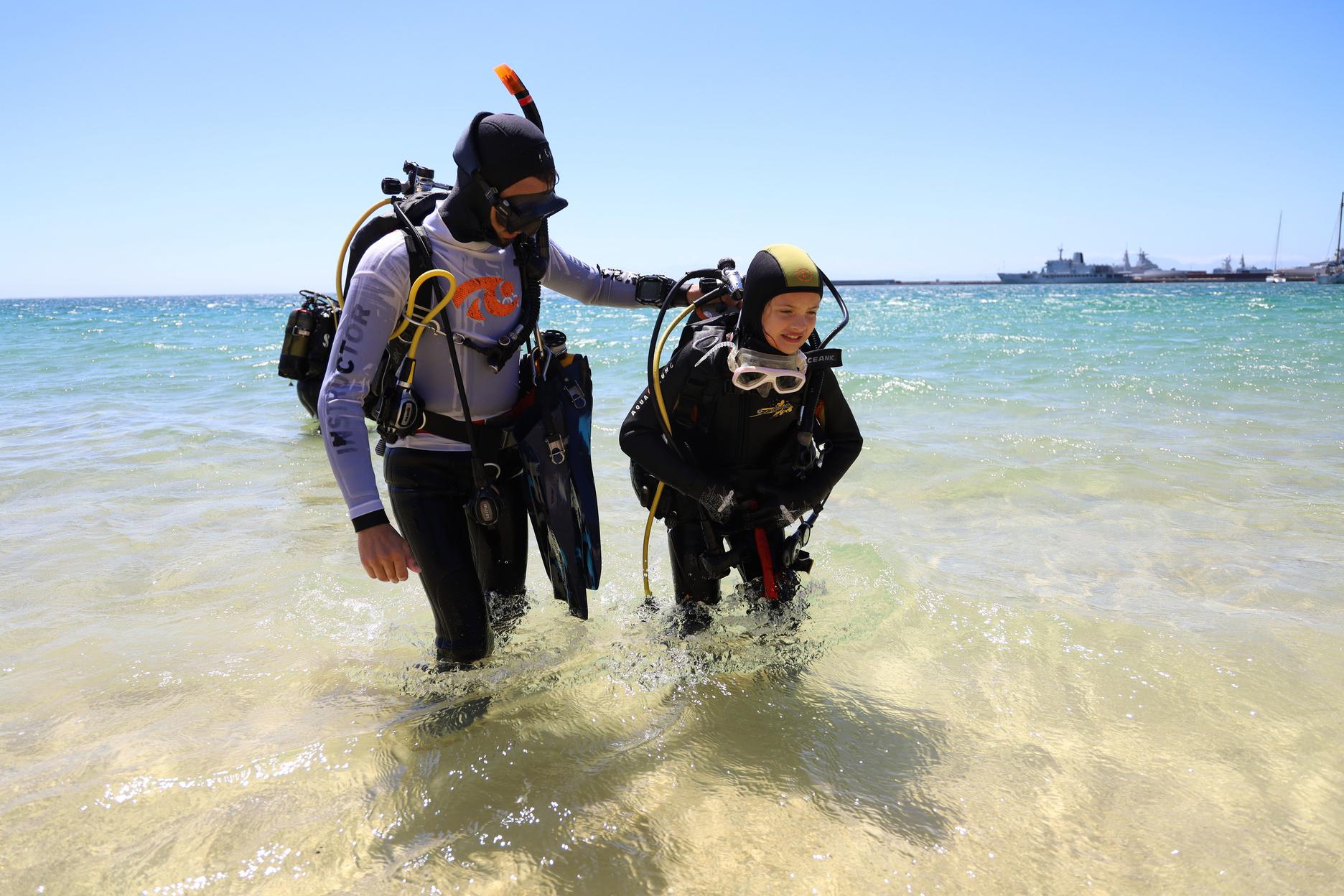
Dive organisations have specific safety standards, but these mainly apply to adult course standards, with some restrictions (depth limits) and special requirements for the diving buddy
As a result, children will be learning from training materials produced for adults. Therefore, the instructor must explain certain concepts or have the tools to help explain these to the child and their parents
Most dive organisations do not offer or require additional training from their instructors to dive with children So the instructors need to understand the many considerations that apply to teaching children to dive. It is not only a diving depth limitation Instructors should be aware of their responsibility and thoroughly inform themselves to mitigate all the risks
Diving equipment for adults might cause discomfort, difficulties, stress or even panic in a child An adult small size BCD might be too big and result in the cylinder pulling the child to one side, which, in addition to a safety problem, will also ruin the fun The instructor or dive centre needs to have child-sized equipment, which includes:
Child (low profile) masks are easier to clear when flooded Smaller snorkels: Due to the dead space and potential for CO2 build-up in snorkels, the volume for children should not exceed 150 ml, whereas, for adults, the volume can be up to 230 ml.
Fins with soft blades will give the needed propulsion but will help avoid leg cramps
A child-size diving suit: A child loses temperature faster, so the dive suit needs to have a good fit and an appropriate thickness Lightweight regulators, with shorter hoses and smaller mouthpieces.
Small/lightweight cylinder.
Weight system: Consider using an integrated weight system to avoid the weight belt slipping off children’s smaller hips
AFTER THE COURSE | Many of the same concerns as described above remain valid. The child’s dive buddy, which may be the parent, needs to understand the diving limits and plan dive trips to appropriate destinations, considering both the local diving conditions and the availability of the equipment that the child will need They also need to be confident in caring for, assisting and even rescuing a child. Clearly, a child will not be able to participate in every type of diving and the buddy needs to be qualified, experienced for the type of dive planned, and physically fit
To conclude, while we can say diving for children can be fun and safe, it is crucial to understand that everybody involved with training and diving must understand the limits and not simply consider children to be small adults

Guy Thomas is an expert Diving and First Aid Instructor Trainer and works full-time as Director of Safety Programs at DAN Europe, where he is responsible for the development and implementation of the DAN Europe Safety Initiatives He also is a member of the Special Rescue Team of the Italian Red Cross. He operates as a Helicopter Rescue Swimmer/Diver Medic onboard a SAR helicopter of the Italian State Police
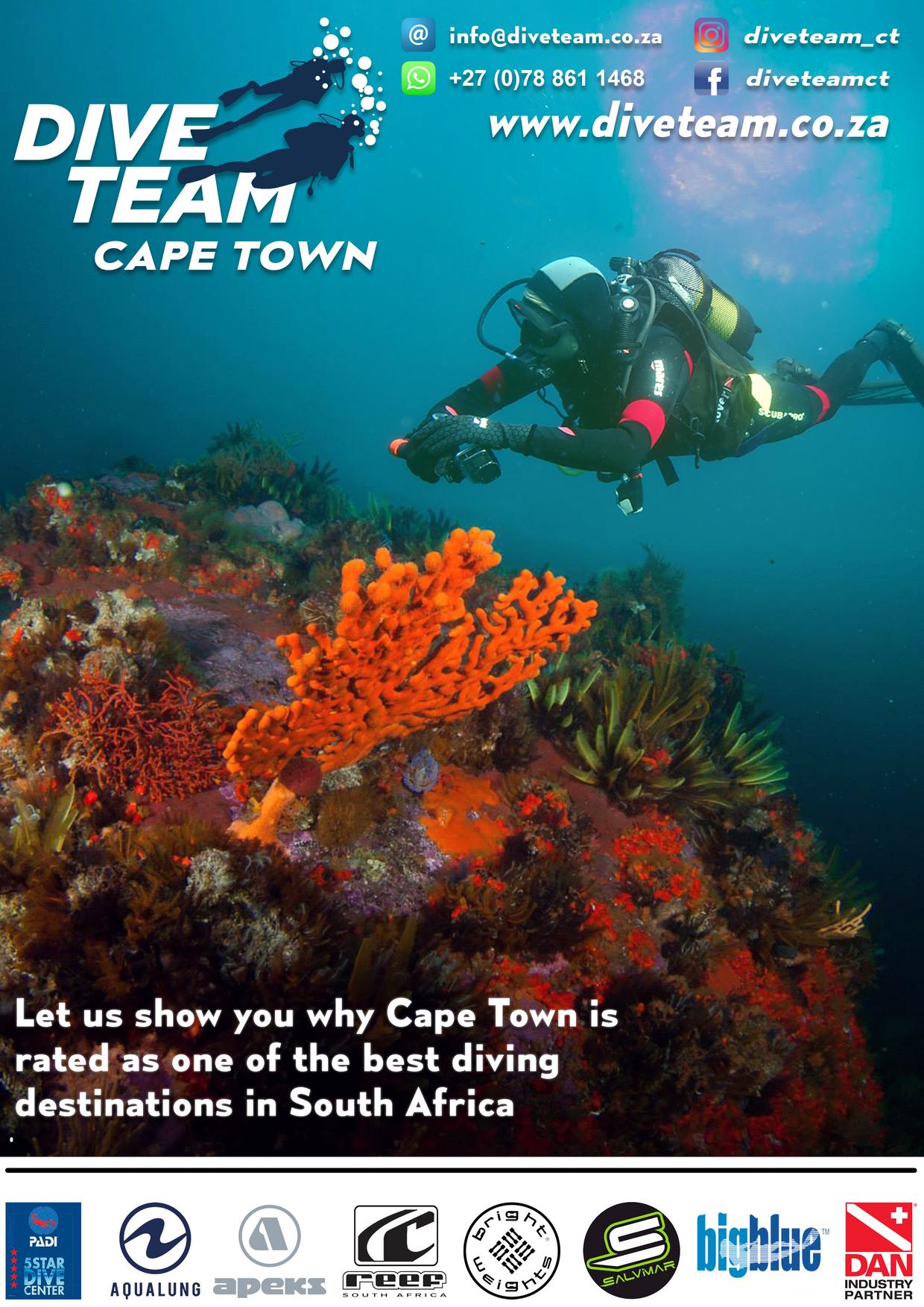
 Text by Audrey Cudel
Text by Audrey Cudel
Having good foundational diving skills is essential for divers to be comfortable, have fun in the water, and, more importantly, be safe for themselves, their dive buddies, and the underwater environment. All training agencies seek to address and instil these skills in students through their courses in various ways and to varying degrees. Yet, in practice, it's fair to say there is still a considerable margin for improving these foundational skills in the sport diving community. Now in this first article, veteran technical and cave diving instructor and underwater photographer extraordinaire Audrey Cudel introduces her new five-part series, "House of Cards," which explores these foundational skills and their importance in diving with the help of several well-respected explorers and educators from the international diving community Are you missing any of your foundational skills? Find out.
Most difficulties encountered in diving are due to poor foundational skills Often not enough attention is paid to these skills during one's initial recreational training; they require a commitment from both the instructor and student to spend the time and effort to build proper awareness and practice. Some divers reencounter these skills at a later stage when they enrol in technical diving training and struggle to unlearn the wrong way or bad habits, when learning the right way to conduct the skill from the beginning would have made their journey much more enjoyable. Students often assume that learning to dive is as fast and straightforward as jumping in the water and enjoying the feeling of floating in the blue. The proverb says: "Don't try to run before you can walk."
At first, mastering these fundamentals might seem hard work, intimidating and potentially require an additional financial investment. However, building a solid foundation from the beginning empowers divers to analyse, understand and take charge of what is happening during each immersion and build solid experience. From that point, they can better consider their future training objectives. The desired outcome is being a "good diver" being prepared, in control, and safe for themselves, their team, and the environment they intend to explore. The challenge and achievement of mastering diving is a matter of mastering each foundational skill.
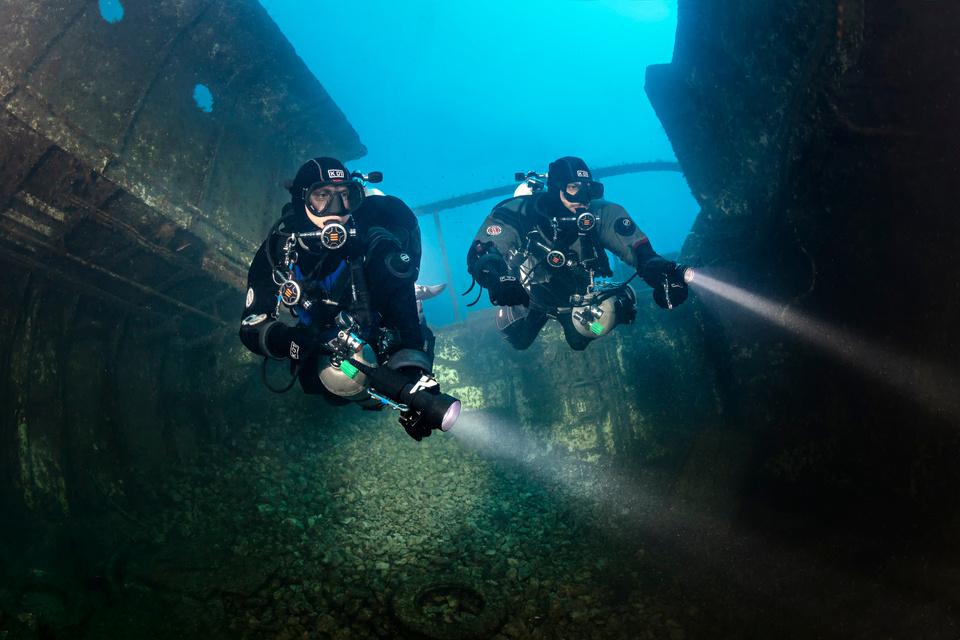
Suppose one is unable to perform one or more of these skills efficiently. In that case, your "House of Cards" will collapse, and in this case, unlike your certification cards, none of the cards is made of plastic! So how do divers create a solid foundation and structure for this House of Cards? Though all of these foundational skills work together synergistically, there is an order or importance which forms a kind of pyramid with one building on the others. These foundational skills are:
Mastering each, but most importantly, synchronising these skills is the path to safe diving and building a solid foundation that one can rely on to begin to focus on other tasks at hand
Nothing is as difficult as getting rid of bad habits, particularly if one doesn't realise they are often the source of the problem Whether through pressure or ego concerns, simply rushing to get more ertification cards when the basics are not in place only makes advancement more hazardous and difficult to achieve As mentioned above, these foundational skills are often ignored during one's initial
recreational training The subsequent discomfort experienced by divers often leads them to take speciality courses to address their deficiencies when those skills should have been addressed as a core component of their first diving course

There is a saying, "Keep It Simple and Safe rather than Stupid!" Safety is the ultimat is not reached when there is noth when there is nothing left to take consumers in a gear-intensive spo want to collect "toys," i.e. equipme make them better divers. This inc sometimes be reinforced by some wishing to sell more gear. Howeve equipment and configuration cho outcome of mastering the fundam opposite. Only then can more plan such as gas, navigation, and the as appreciated to prepare for a safe dive.
Is buoyancy a matter of control or wrapping a heavy, ill-fitting weigh diver's waist smart? To what exte diver safety? Does a diver's trim r how does it correlate to buoyancy divers discover appropriate propu like back kicks or helicopter kicks interested in technical diving, even though these techniques are applicable and most efficient for recreational diving? Is a magic pair of fins better than all the rest? What is really involved in diving as a team, and why is it that a group of divers in the water is not necessarily a team? Why does individual mastery of buoyancy, trim, and propulsion techniques make a team perform better and more safely? Finally, is situational awareness about the weather or sea conditions seriously?
In this "House of Cards" series, we aim to address and answer each of these questions with common sense, illustrations, and experience rather than treat them as an academic exercise In doing so, we will review each of them in detail, discuss what they are all about, how they interact with one another, and how they will benefit your diving
ABOUT THE AUTHOR | Audrey Cudel is a cave explorer and technical diving instructor specialising in sidemount and cave diving training in Europe and Mexico
She is also renowned in the industry for her underwater photography portraying deep technical and cave divers. Her work has appeared in various magazines such as Wetnotes, Octopus, Plongeur International, Perfect Diver, Times of Malta, and SDI/TDI and DAN (Divers Alert Network) publications.
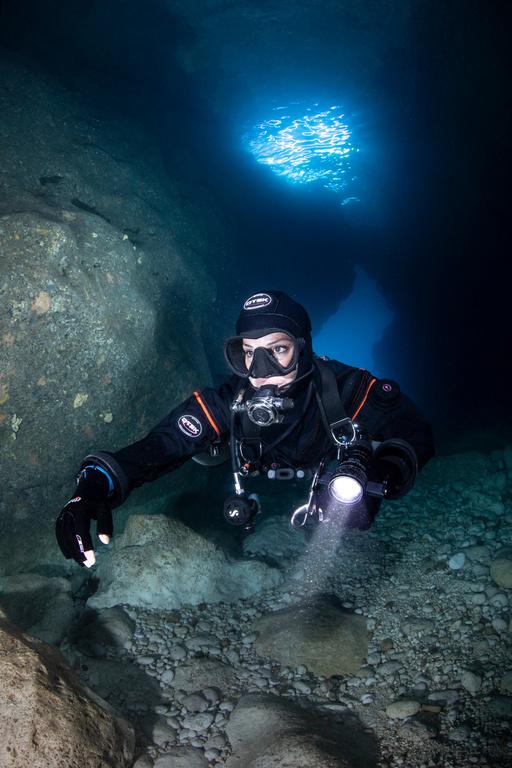
 D I V I N G E T I Q U E T T E
D I V I N G E T I Q U E T T E
"Who's this guy who wants to teach us how to behave? Do we really need this?"
The first misconception is that common sense is a kind of talking cricket, ready to suggest the best way to behave under any circumstance
Boats and sea depths are unfamiliar environments for most people, so there's always the risk of taking a faulty step
Most codes of conduct were created to prevent misunderstandings from triggering duels, wars and other unpleasant events On average, diving incidents are less dramatic, but remember that propellers and nitrogen can do as much damage as swords and katanas.
Let's face it: the way some divers behave can be annoying Luckily, there's also a lot to laugh about Blunders and mistakes are often the sparks that trigger fun and laughter.
This series on diving etiquette is the result of careful observation of divers, their social behaviour and, of course, from experience, as defined by Oscar Wilde: The Sum of Our Mistakes
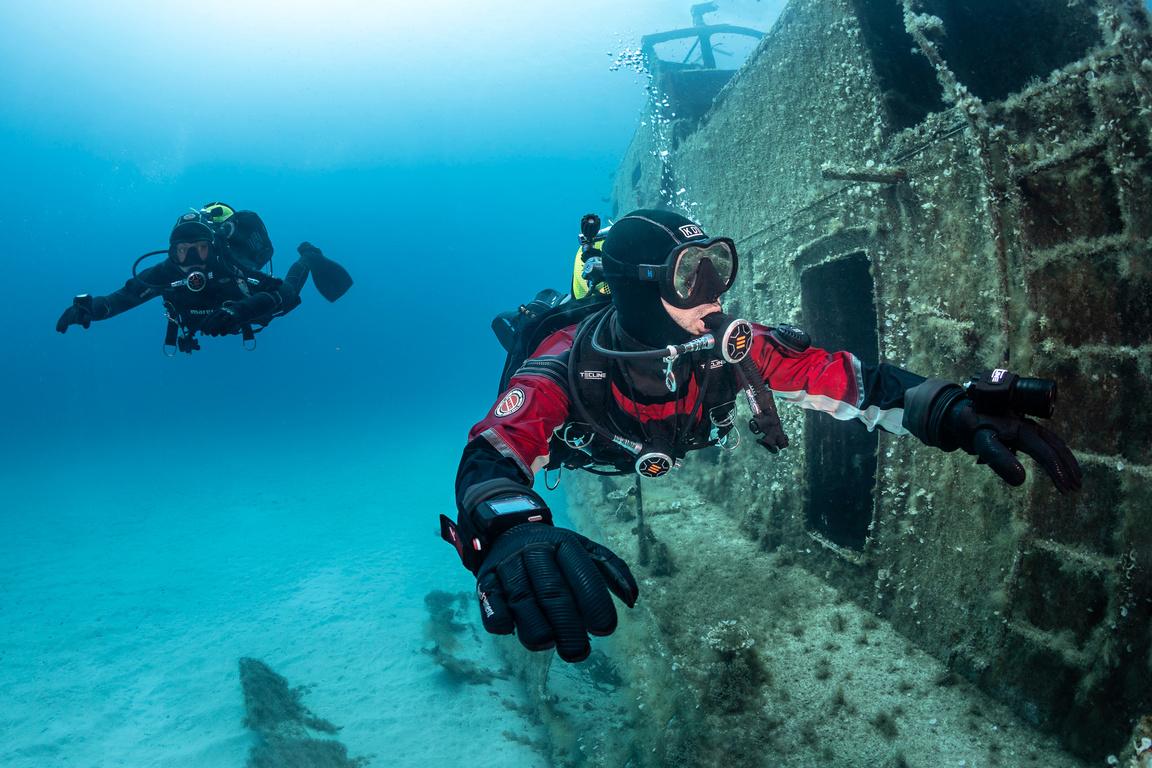

THE BUDDY | Some divers find it hard to believe, but safety and fun in diving both rest on the same foundation: the buddy system Simply put, thanks to a close companion, you can count on extra help and air supply. Four eyes are better than two for safety checks and to enlarge the scope of our observation Two people see more than one and can have more fun together.
Treating your buddy well and ensuring they are at ease is the duty of every diver If you don't, then it is very likely they'll get even, ignore you or fail to report that fantastic whale shark's passage while you adjust your BCD So, whether your buddy is the one you brought from home or found on-site, respect and duties remain the same. Little friendliness will go a long way if you don't know each other yet
Present yourself as a diver. Go beyond a friendly smile and a "Hi I'm John" Tell (briefly!) about yourself, your experience, and what you like to see underwater Breaking the ice using these conversation topics will help your buddy pay more attention to you and talk about their dives and expectations Ask them where he dived and how many dives he has in the logbook. Show yourself genuinely interested in their experiences. Knowing their limits will help prevent surprises underwater or make you more confident Ask them where they prefer to position themselves to you because you both should find each other at a glance, just by turning your head New buddies can be easily recognised by their continuously rotating on three axes. If you brought your buddy from home, you do NOT need to ask them again about their life
Adjust your pace, depth and timing to their abilities and air consumption If your buddy is less experienced than you are, be courteous by adapting to their skills and the limits of their certification, and not vice versa. Avoid making them uncomfortable or putting them in a stressful situation Sneaking to 40 meters to admire a gorgonian while leaving an Open Water buddy at 18 metres ("but it was only for a little while!") is just rude.
Agree on underwater signals Shakers, ducks and balls are (unfortunately) very common, and everyone knows how to recognise them. However, only some know you can scream in the regulator to be heard If you want to use this system, tell the buddy and do some tests while on the surface.
Grabbing someone by the fins is not the best option, but still better than a slap on the thigh The shoulder is the right place to (gently) touch people, if needed, even underwater.
Communicate Show your buddy what you find interesting But avoid prolonged contemplation of things your partner might discover as dull as a road sign Ten minutes in front of an artillery bullet is a long time if your buddy is not a military history lover If, on the other hand, you are matched with an underwater photographer, then ask the diving centre manager for a substantial discount on the dive!
DONT'S | AAvoid grabbing your buddy by the BCD hose if he has lost control and is sinking The reason for this should be apparent If not, it may be time to re-read your Open Water manual, equipment and buddy-system sections
Tricks and jokes, like closing the air or removing masks, especially with a buddy you do not know well, are inappropriate and may precipitate life-threatening situations
Use the P-valve when close to your buddy. Urinating in a wetsuit is OK – if it is your own!
FINAL CONSIDERATIONS | Whether your buddy is a stranger or a life-long dive companion, always extend the courtesy of doing a safety check, even if it is a simple dive boat like a rubber dinghy: this is one of the most neglected rules. It's a little thing that takes less than a minute but guarantees safety and comfort
Abandoning your buddy, both in the water and on the surface, is not only rude. In the event of an accident, this could have legal consequences
Divemaster tip. Unless a particular dive centre has specific guidelines (e g , pairing up people who know each other), experts should be paired with experts and newbies with newbies. A golden rule is to create harmonious pairs if you are organising the dive and assigning buddies to each other I know it can be more demanding, but the usual method of placing divers who need more attention closer to you is a wise decision After all, experienced divers who paid for the dive are not there to take care of others: that's your job!
Q | I recently underwent brain surgery. The surgery was successful, but now part of my skull has been replaced with mesh My neurosurgeon is brilliant but does not know how the surgery may affect my diving. Am I still able to dive? Should I limit myself to a certain depth, or should I only snorkel?

While your surgery was successful, returning to diving after this type of surgery may or may not be possible Clearing someone for diving following brain surgery is a delicate process, and each person needs to be assessed on a case-by-case basis. After any brain surgery, there is a minimum convalescent period that you must observe before considering diving due to an elevated risk of seizure A seizure in the underwater environment is often fatal, and any increased risk of seizure activity is an absolute contraindication to diving
As you mentioned, your surgeon may not be familiar with diving and dive medicine. We regularly provide consultations for physicians and encourage medical
providers to reach out to us individually to discuss their questions We are happy to provide information and recommendations so your doctors can make informed decisions about your fitness to dive.
Ben Strelnick, NREMT, W-EMTQ | I was born about two months premature. Retinopathy of prematurity was the main complication, and I had oxygen, cryotherapy, and scleral buckles as treatment. I want to take up diving. Is there anything I should be concerned about?
I was born about two months premature Retinopathy of prematurity was the main complication, and I had oxygen, cryotherapy, and scleral buckles as treatment I want to take up diving Is there anything I should be concerned about?
Retinopathy is the primary concern for diving If your field of vision is greatly affected, this could lead to you being unable to read gauges or properly respond to a situation requiring urgent attention A diver should be able to do the following:
Read gauges showing air pressure, depth, dive time, and decompression requirements
Read a compass
Locate and navigate entry and exit points
Locate and recognise their buddy
We recommend you share your intentions for diving with your ophthalmologist as part of getting medical clearance to div
Anne Strysniewicz, AEMT, DMTQ | I was getting back into divin years off when I was dia primary myelofibrosis. I hav doctors about it, and while th disease, I do not think they diving’s physiological eff concerns should I have about d
As you know, myelofibrosis overproduction of certain blood of others, thereby affecting the The marrow is responsible for p that help our bodies maintain a known as homeostasis. These red blood cells that carry oxyge clotting factors called platelets
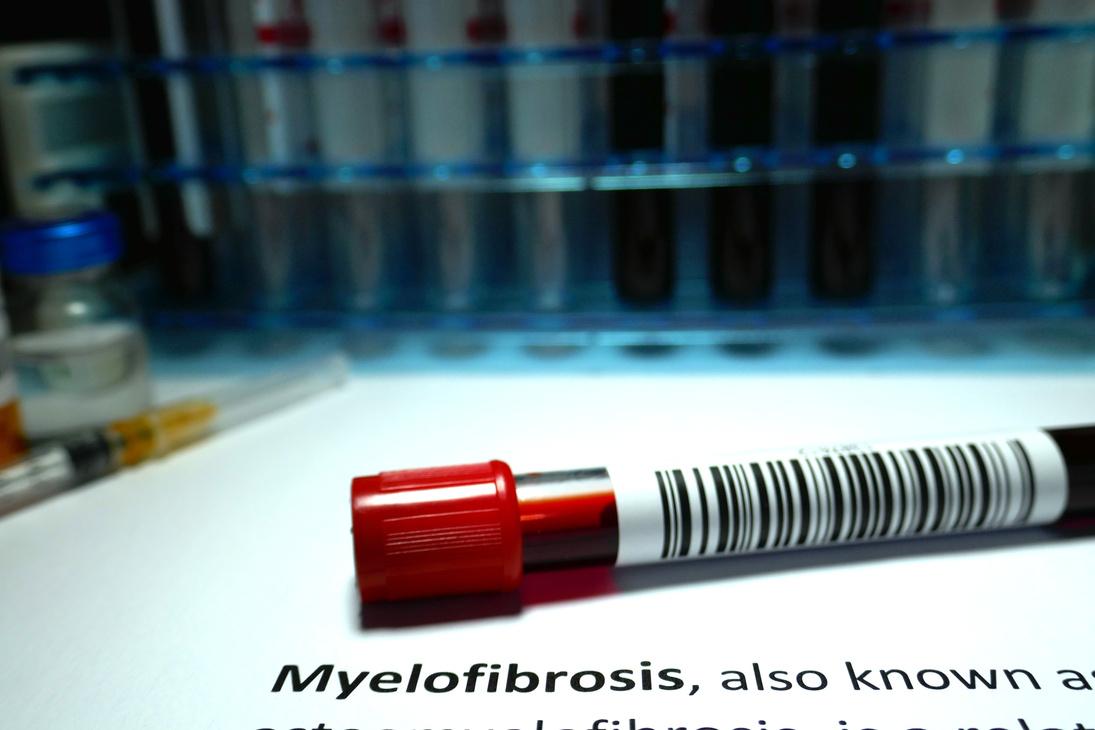
You may want to concern yourself with a few things when deciding if you are fit to dive
A disruption in red blood cell production may lead to anemia, which can manifest as physical weakness, tiredness, or shortness of breath Diving is a taxing physical activity from start to finish that includes hauling tanks and gear, donning and doffing gear on a boat, swimming against currents, and climbing a ladder while wearing gear These exertions may be hazardous to you, and you should consider the risks it can cause for others if you need a rescue Easy bleeding or bruising are also considerations due to a possible decrease in certain blood cells Minor bleeding from a fall, a ruptured or perforated eardrum, or barotrauma may be more severe and cause hemorrhaging concerns
The level and rate of your condition’s development may put you at a greater risk of opportunistic infections, neuropathy, pericardial effusion, and other factors that can lead to convulsions underwater or pulmonary barotrauma.
The effects and side effects of any medications you take are further considerations. While medications metabolize or potentiate faster in hyperbaric environments, you should consider how they make you feel Pain relief medications can have a narcotic property or create a sedative effect, which can greatly affect your cognitive thinking and how you respond to an unexpected event
If you are taking medication to treat your condition, side effects can include nausea and vomiting Some of the signs and symptoms you may experience mimic those of decompression illness and make diagnosing difficult For a dive trip, you must also be aware of access to emergency care at your location should the need arise.
We can’t determine if you should or should not dive, but we can educate you about the risks you may encounter Please review this information with your physician along with the RSTC Medical Statement to determine your fitness to dive
Robert Soncini, NR-P, DMTQ | About six weeks ago, I did the Valsalva maneuver to clear my ears after getting off a plane and noticed air coming out the inner corner of my right eye, seemingly from the tear duct. Since then I can feel a puff of air coming out of that spot whenever I blow my nose. I have no other symptoms, but is this anything to be concerned about when I go diving?
What you describe seems to be air passing through your nasolacrimal duct when blowing your nose or trying to equalise by using the Valsalva maneuver. This phenomenon is not uncommon, and some people experience it when they try to equalize forcefully. You may be executing the Valsalva maneuver a bit too forcefully Equalisation should be a gentle and easy process with minimal effort They also several other techniques, such as the Frenzel and Edmonds techniques (check out our DAN video on Ear Equalising Techniques – (https://www youtube com/watch?v=neagsAfZwa4&t=20s) It’s quite a long presentation, so just scroll to the section that deals directly with ear equalising techniques.
While it may feel odd or tickle slightly, you should not have any issues from diving There is a remote possibility of infection from forcing mucus from the nasal passage into the nasolacrimal duct
If these solutions don’t address your concerns, we recommend consulting a local ear, nose, and throat (ENT) specialist about your concerns Knowledge of dive medicine is unnecessary as this is a common problem that happens to many people, including non-divers
 Ben Strelnick, NREMT, W-EMT
Ben Strelnick, NREMT, W-EMT
I recently experienced a stress-induced heart attack, and my physician diagnosed me
Takotsubo syndrome An electrocardiogram showed my heart function returning
and my cardiologist expects a full recovery. What steps should I take, and what should I
aware
before diving again?
Takotsubo cardiomyopathy, or broken heart syndrome, is brought on by stress or strong emotions and can indeed resolve with time The period during which symptoms mimic myocardial infarction, are clearly acute and diving would be out of the question
In a conventional heart attack, a blockage forms at a site of narrowing arteries. This blockage impacts oxygen flow to the heart and can cause infarction (tissue death) With Takotsubo, there is often a lessened blood flow but not a complete blockage, resulting in reduced oxygen to the muscle
Electrocardiograms and blood tests may indicate the patient has suffered a heart attack, but the cardiologist can see no evidence of a blockage. Takotsubo often results in the heart’s left ventricle being enlarged and
Questionnot working properly.
While Takotsubo cardiomyopathy’s cause is believed to be stress-related, researchers are still investigating the exact mechanism. It may be that the stress triggers an acute inflammation of the heart tissue
Most patients will start to spontaneously recover within a few hours up to a few days, but the heart muscle takes longer to heal A 2018 study by Aberdeen University found signs of reduced inflammation five months after a Takotsubo episode This inflammation may cause long-lasting symptoms, including fatigue, chest pain, and a lack of energy
The information we have indicates a 10 to 15
percent chance of recurrence, although the trigger may differ Its recurrence while underwater could prove fatal.
Determining your fitness for a return to diving is much like any diver with a significant cardiac condition, which are all on a case-by-case basis Your overall well-being and ability to exercise without feeling weak, fatigued, or short of breath are part of it, as are any medications you take and your other medical history
We recommend close follow-up with your cardiologist during your recovery and waiting to ensure you are completely symptom-free and your exercise tolerance has returned to normal before considering a return to diving. Then you should talk with your cardiologist about your desire to dive, undergo a complete fitness for diving physical, and understand the serious implications if symptoms recur while diving.
Significantly higher in-hospital mortality, hospitalization for stress disorder, and readmission for cardiovascular issues are reported compared to those without this condition
After all is said and done, the biggest concern is cardiac dysfunction and dysrhythmias underwater leading to loss of consciousness and almost always ends in drowning If you do decide to resume diving, once there has been full recovery, we would strongly advise you to dive only in very benign conditions, and that you should dive with two buddies who have no impairments, we understand the condition, and are willing to support you if you were to get into difficulties underwater. We do not recommend diving however, but ultimately the choice is yours to make
Robert Soncini, NR-P, DMT with to normal, be of W H A T I S T H E P R O B L E M ?
W H A T I S T H E P R O B L E M ?
Over the last decade, shark-related accidents involving swimmers and surfers became widespread, receiving extensive media and movie attention With the steady increase in human recreational use of beaches at the beginning of the twentieth century, the general public became more exposed to interactions with sharks, sometimes with fatal results.

Australia started implementing a policy of "the more sharks we kill, the fewer shark-human encounters we are going to have" in 1937 South Africa followed suit in 1950, and Reunion Island in 2014. The newest to pursue this line of thinking is New Caledonia which implemented similar policies in 2020
It is difficult to believe that in our time, when we pay more attention to sustainability and nature conservation, we still have countries that are killing marine life for fear of negative encounters with sharks.
The current culling methods need a physical separation between beachgoers and sharks Sharkculling policies are carried out by fishing the local
bull sharks and tiger sharks or by deploying shark nets and drumlines Drumlines consist of heavily baited hooks deployed to fish, primarily sharks. In New South Wales, Australia, 65% of shark bites occur at netted beaches Shark nets also resulted in the large-scale, unjustified killing of other marine animals, such as whales, turtles and dolphins
The SharkSafe Barrier is a novel and ecofriendly approach to the shark-human conflict. It aims to prevent the trauma associated with shark accidents by keeping sharks and people separate from each other
It is the first eco-friendly and shark-specific technology to reduce shark-human conflict It was developed from the sharks' point of view. Produced and distributed by SharkSafe Barrier Pty Ltd, a start-up company of Stellenbosch University in South Africa The SharkSafe™ is designed to be a visual sharkdeterrent by mimicking a thick kelp forest It comprises vertical recycled plastic pipes coupled with a strong magnetic field It was tested and proven to affect the swimming behaviour of large sharks
Adding strong barium-ferrite magnets inside the outer row of tubes, it mimics the stalks of a dense kelp forest The vertical buoyant plastic pipes are anchored to the sea floor. This design was scientifically tested from 2012 to 2016 and proven to prevent motivated sharks from entering a specific area, even when baited.
This barrier provides a separation between humans and sharks, and there is no indiscriminate killing of marine life It is superior to exclusion nets (small-mesh nets, deployed daily in good weather around swimmers only) since SharkSafe Barrier is shark specific; it works 24/7 and can withstand harsh sea conditions, culminating in low maintenance cost. Its design also provides passage to boats, oceanic debris and other animals not deterred by magnetism
Thanks to various sponsors, such as Shark Project, White Shark Diving Company, Dive Team, Just Africa Scuba, the Technology Innovation Agency, Stellenbosch University Faculty of Science and Itatile, The SharkSafe Barrier™ has been undergoing rigorous testing
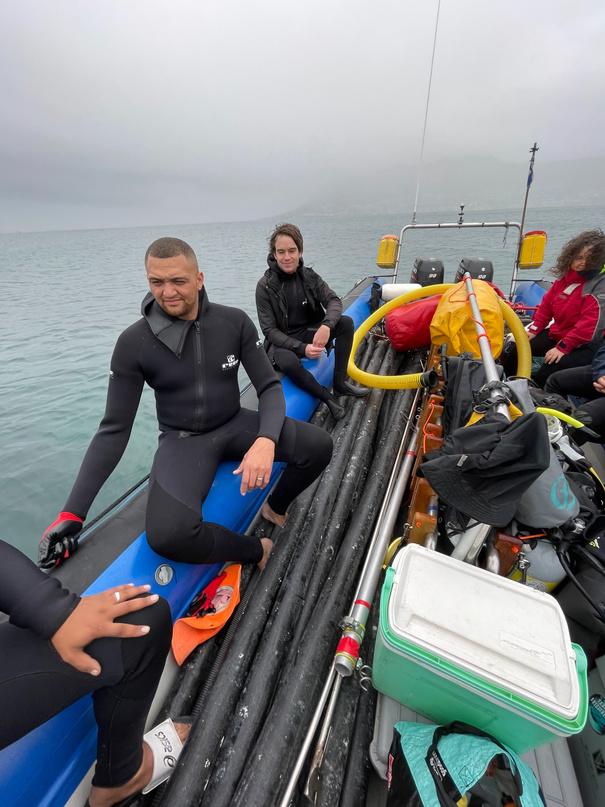
Test and trial installations were conducted with 63 white sharks in South Africa and 48 bull sharks in The Bahamas from 2012 to 2016 The results of these tests were published in various peer-reviewed scientific journals. To convince the sharks to cross the barrier, we deployed baits (fish buckets) inside the exclusion area In all instances where the barrier was built correctly, we never had a shark crossing it
A test barrier of 200 pipes was constructed in February 2019 to form a 10 meters x 10 meters square to replicate previously published experiments. The aim was to test the efficacy of the barrier in collaboration with the local Shark Security Centre to exclude local bull sharks from a food source These 200 pipes were deployed at sea for over two years and required minimal maintenance. They also created a fantastic artificial reef, showing that even hard corals could grow on the structure
This study was designed to exclude bull sharks from a baited area to support its fullscale implementation Unfortunately, no bull sharks approached the experimental site Reunion's Shark Security Centre plans to replicate the experiment in New Caledonia, where more bull sharks were recently sighted
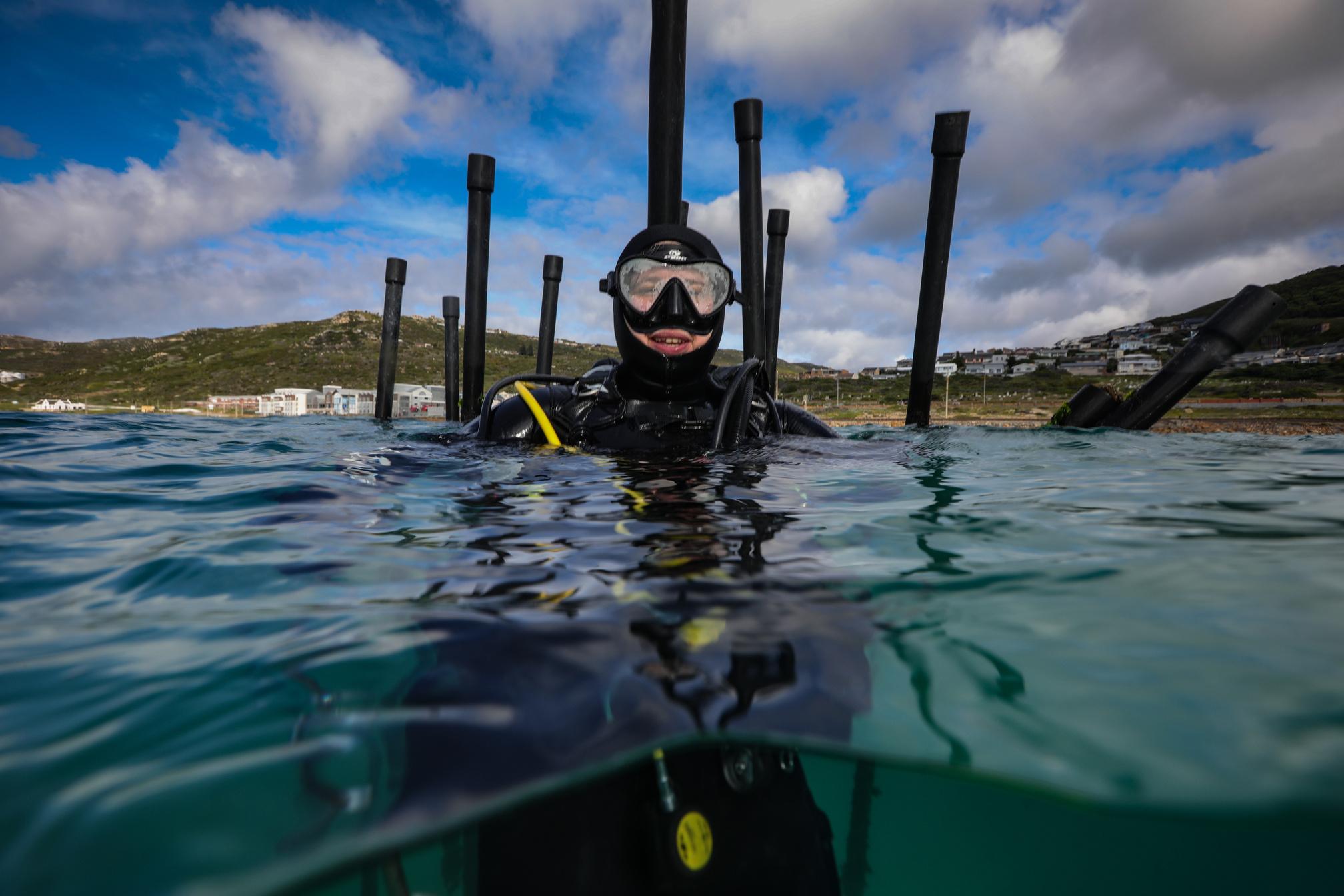


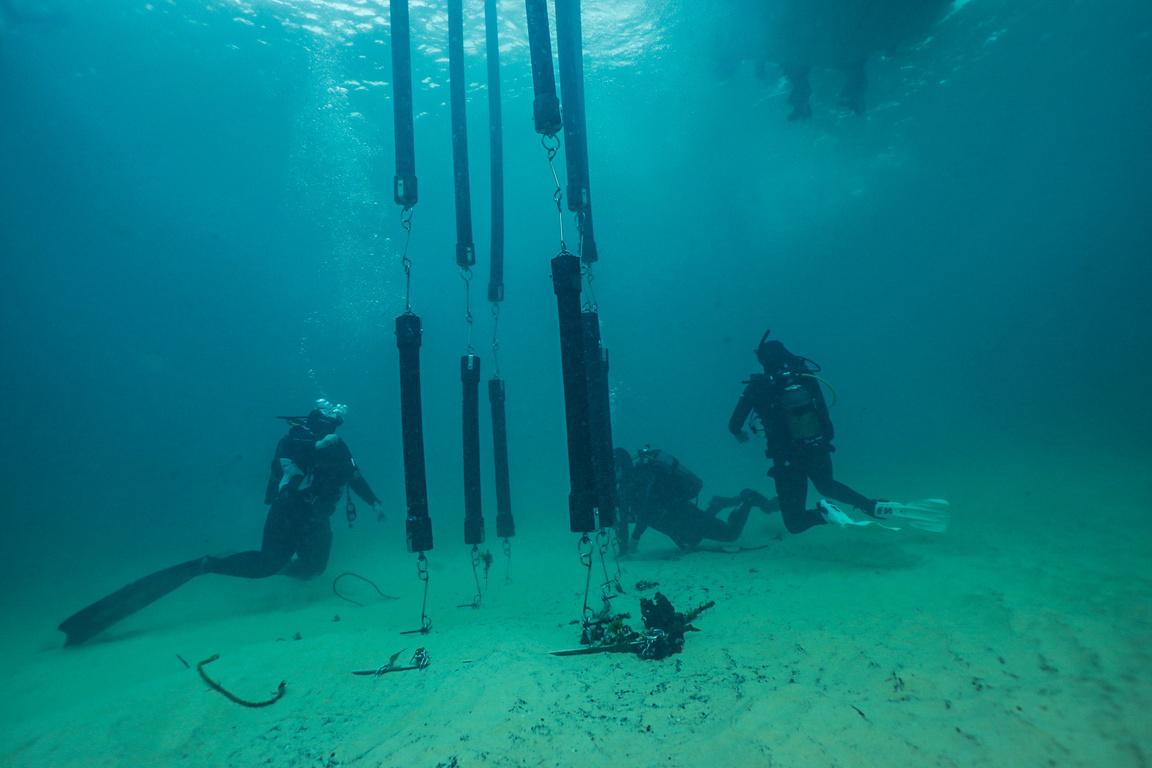
The SharkSafe Barrier™ team is working to adapt the current design to enable moreversatileinstallationsacrosstheglobe.Installationistestedatdifferentwater depthsandacrossotherseasubstrates.
Theanchoragesystemcouldbetestedwhenthesoutheaststormshitthebay One such test site is at Mackrel Beach (next to Glencairn, South Africa), where we installed a cluster of pipes in the shallow area and a few 6 meters deep water This site was selected to try out the latest design for deep sand anchorage. The pipes wereinstalledinNovember2021andrequiredminimalmaintenance.Thecondition and location provided a great testing ground to try out different options to secure our anchor grid and ultimately select the most cost-efficient and robust option (DISCLOSURE:theinstallationinMackrelBeachdoesnotformanenclosedtokeep sharksout–wearejusttestingthedesignwithafewpipes)
We are proud to announce that our team welcomed two new sea-loving investors and directors, bringing additional strength, knowledge and skills to our team We are always busy expanding our network The World Economic Forum, the Solar Impulse Foundation and the National Science and Technology Forum have endorsedus.
Despite ongoing international work, we are focusing our attention closer to home, to Plettenberg Bay, following this year's shark accidents The Bitou council approved a SharkSafe Barrier installation in August this year We are now assisting thelocalcommunityinraisingtheneededfundstoproduceandinstallthebarrier.
"We sincerely hope that our technology will assist them to peacefully coexist with thewhitesharksusingtheareainthelongterm Whensharkattackshappen,itisa tragedy on many fronts We were pleasantly surprised with our interactions with the local community of Plettenberg Bay and the Bitou Council They showed genuine love for their marine environment and are looking for an eco-friendly solutionthatwon'tdamagethelocalfauna,"saidSarah.
ShouldyouwishtogetinvolvedandassistwiththeworkinPlettenbergBay,please keep an eye on their website and social media pages to connect and support their effortstomakebeachessafer.
Bycatch, shark finning, overfishing of their food resources, climate change and pollution are among the biggest threats to shark populations worldwide Sharkculling policies are a constant source of shark mortality. We can eliminate these destructivehabitsbychangingourways."WehopethatourworkontheSharkSafe Barrier™ will soon relegate shark nets from the history books, promote peaceful coexistence with sharks and prevent fear-based conservation policies, said Dr SarahAndreotti

 Ph.D.
Ph.D.
Sherri Ferguson, MSc, is the lab manager at Simon Fraser University’s hyperbaric chamber, located at an altitude of 1,200 feet on Burnaby Mountain in the outskirts of Vancouver, Canada She is an aerospace and dive research scientist, an experienced recreational, technical, and commercial diver, and a mother.
How did you get into diving?
The story began with my first dive when I got hit hard with the dive bug, as many people do. I was lucky to live in a small community here in Deep Cove, North Vancouver, with a dive shop, and I was living on the waterfront then. It was convenient to dive in my backyard, so I had more than 100 dives in my first year of getting certified, and I realized that all my money was going to my dive habit. That is when I decided that I’d be much happier if I made my habit into my career so it would pay This led to me taking all the training I could find to advance my dive skills up to instructor ratings
I thought the best way to make money was to separate myself from the masses, so the more courses I could teach, the more diving I could do, and I enjoyed learning I grew a small business producing, building, and repairing drysuits, which took me on the road to visit dive stores and schools to get them to buy our brands or send their repairs to me. Making those connections was invaluable for my commercial and recreational dive network I quickly got picked up by dive gear manufacturers. I did everything from selling technical dive gear to teaching regulator service seminars up through the 1990s and the launch of recreational rebreathers.
You are a commercial diver as well How did you get there?
I became a commercial diver in the late 1990s I started scuba doing easy underwater work such as changing zinc anodes and inspecting dock chains. I worked a bit in the film industry doing water safety for different TV shows filming here, such as The X-Files I finally ended up
teaching at a commercial dive school and taking on commercial dive work That dive school was where I had my first encounters with hyperbaric chambers.
Having so many things going on but making my own schedule allowed me to be a single mom and make a relatively good living as a dive industry professional I later worked for Diver magazine, another great way to make more contacts and extend my network in the dive industry.
You have taken a somewhat unconventional way into dive science. How did you get into academia?
While working at Diver, the University of British Columbia (UBC) advertised for a dive safety officer (DSO). When I looked at what they required for experience, I decided to try it I applied and got my first university job I was the science program’s DSO, and having that job led to me hearing about a job at Simon Fraser University (SFU) as the chamber operator and hyperbaric facility coordinator. I was doing both jobs part-time, sharing my time between the universities for a while The first big project I was involved in at SFU was for Boeing They were interested in blood oxygen saturation levels during sleep as they built the Dreamliner and the 777 These aircraft were going to fly for 21 hours, meaning they had to have two crews so one could sleep while the other flew Sleep at the cabin pressure at 8,000 feet was causing some saturation drops similar to sleep apnea, which had potential implications for cardiovascular health and hypertension
To look at those effects, we had the pilots sleep in the chamber for several nights at different altitudes with all kinds of physiological and psychological monitoring. We discovered that there was a benefit for pilots to be sleeping at pressures equivalent to 6,000 feet instead of 8,000 feet, so to protect the crew’s long-term health while flying long distances, a higher cabin pressure made sense We also found that
altitude did not significantly affect their reaction time, concentration, or performance after sleep
How did you become the hyperbaric chamber director?
Unfortunately, during one of those experiment days, we had a massive chamber failure that required full service and cleaning of the entire system Right as we had to shut down the chamber, the engineer on site retired, and I became the engineer, and SFU made me full-time. I fixed the lab and got us through that study, but the university was planning to close the chamber due to a lack of funding. I proposed a new business model for the lab that would make the chamber a shared resource for other departments and outside investors to use for their research.
To live up to my new title, I decided to work on my academic credentials, so I started a master’s degree in biomedical physiology at SFU. The US Office of Naval Research Global (ONR-G) funded my thesis projects, but I had to find other ways to attract research to the lab. What I had seen from running the chamber interested me in the Undersea and Hyperbaric Medical Society (UHMS), and I started attending their annual scientific meeting The work presented there excited me, and I thought, “This is what I want to do ” Somehow, my passion for dive research surpassed my passion for diving I still dive as much as possible but have become more selective about destinations
What was the focus of your master’s degree?
According to descriptions of their deaths, I knew several very experienced divers who died after developing symptoms during their ascent or after surfacing that might have been caused by immersion pulmonary edema (IPE). I questioned if a drop in oxygen partial pressure (PO2) could have caused these deaths
My particular interest in the ascent phase and the connected change in PO2 made me wonder if we would see a difference if we clamped the PO2 when divers surfaced
I completed 12-lead ECGs in exercising, submerged, coldwater divers and 12-lead ECGs and blood pressures in simulated hyperbaric chamber dives to 2 4 ATA for 90 minutes with air brakes After watching how the cardiovascular system, cardiac rhythm, and heart rate variability responded to drops in PO2, I was left with more questions than answers

What projects are you currently working on?
We have several different projects going on in our chamber. One is a collaboration between myself, SFU’s Damon Poburko, Christian Kastrup from UBC, and his postdoc, Adele Khavari Initiated through discoveries from a Department of Defensefunded project focused on clotting research, we are looking at factor XII, a coagulation protein involved in the cascade for clotting whose deficiency does not promote bleeding. It is activated with an injury to blood vessel walls (endothelium). Deep-diving mammals and birds that fly at extreme altitudes lack this protein
We aim to understand if factor XII plays a role in decompression stress and decompression sickness In a hyperbaric environment, we have finished laboratory experiments with blood and plasma with and without factor XII. The next phase is a mouse model that does not express factor XII (called a factor XII knockout), which we will compare to a wild-type mouse We are analyzing their blood, endothelial, metabolic, and mitochondrial function and looking at bubble formation with ultrasounds after decompression
This is the only way to justify animal experiments looking at it from all angles before transitioning to human subjects. The goal is to see if we can control decompression stress by suppressing factor XII through pharmacology.
You have also been working with seafood harvesters as well. What is that project about?
WorkSafe BC, our Workers Compensation Board, is funding that study We are looking at scientific divers who collect samples or do surveys and seafood harvesters who collect sea urchins, geoducks, and sea cucumbers.
We provided about 60 divers with dive trackers – small black boxes attached to the diver’s gear that record dive profiles Through these anonymised trackers, who are blinded as well, we try to see if they dive according to our occupational tables or not We track their behaviours to understand their dive profiles, see if we can implement computers for this type of diving and if that would make harvesting and scientific diving safer.
A big part of your work is hypoxia and hypoxia training What are you trying to find out?
We have pilots coming to the facility to participate in hypoxia training. The only portion legally required in Canada for commercial and civilian pilots is academic Anyone can teach that, but many pilots want to experience hypoxia and see how they perform under hypoxia
We involve some of those pilots when they take the hypoxia training to find out if there is a predictor for the drop in oxygen saturation How quickly the drop happens and how severe the symptoms are is very individual We are collecting demographics, how frequently they fly, and what type of aircraft they fly (pressurised or nonpressurised).
The study is ongoing with 45 current participants, which is still limited Still, it seems that age is the only correlation with the more severe drops in oxygen saturation Since the pandemic, however, we have had more participants faint This observation is fascinating, but we do not yet have the data to show any correlation. That is likely one of the following studies.
What do you do when you are not in the lab?
I live in a small village in North Vancouver within walking distance of the ocean My dog and I take a daily walk to the beach. I have recently picked up sea kayaking and obtained my sea kayak level 1 skills certification I volunteer on several safety and dive boards, including being the chair of the Canadian standard Z275 1 on hyperbaric and compressed-air environments, the UHMS safety committee, the Canadian Undersea and Hyperbaric Medical Association, and the Canadian Association of Underwater Science. I love to travel to places I have never been before, and if I can dive there, even better
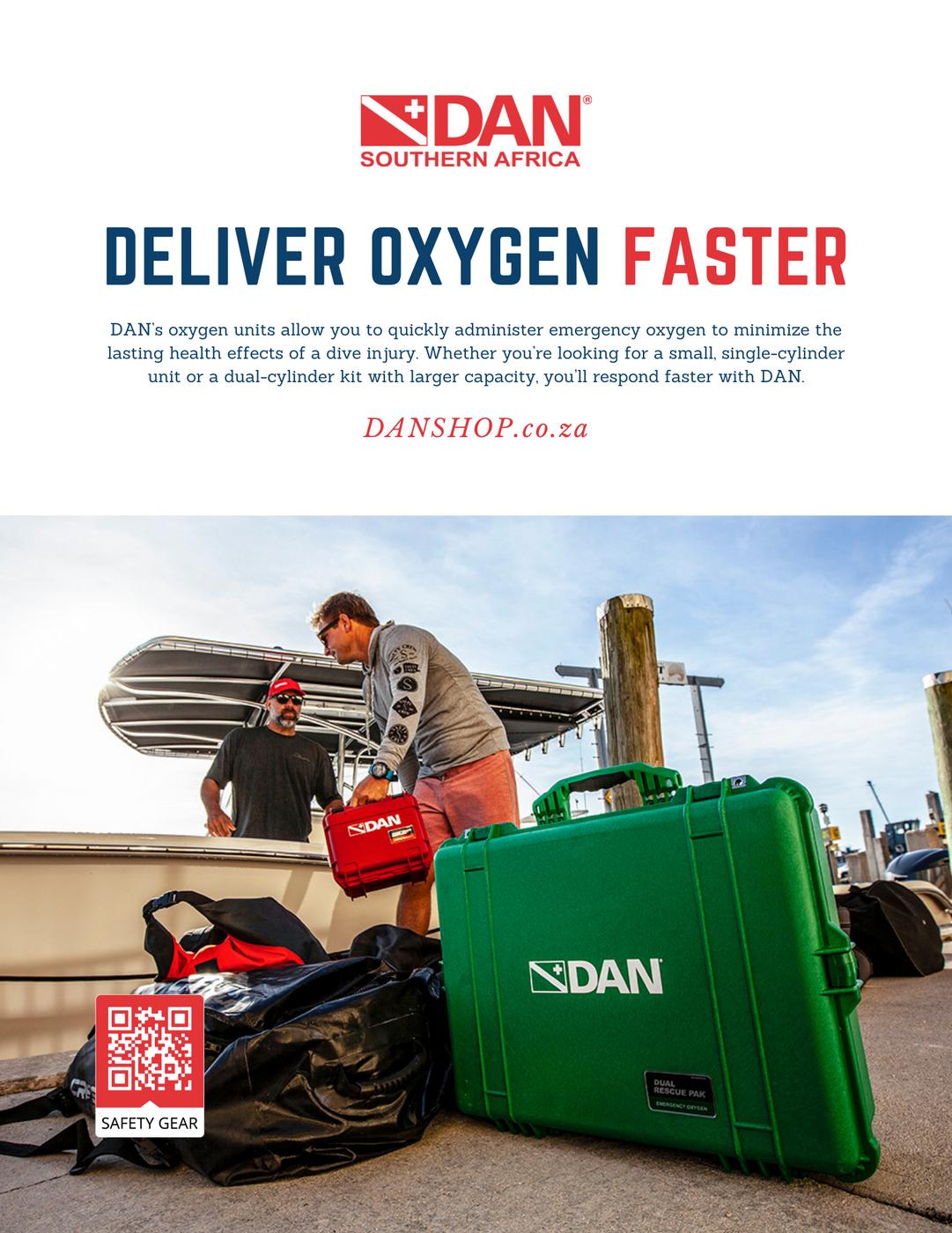
In the previous article, we settled on the recommendation that equipment used to control any breathing gas mix containing 25 percent oxygen and above at typical scuba cylinder pressures should be designed and considered suitable for oxygen use.

Possible debates aside, we’ll examine what oxygen cleaning means. How often should gear be oxygen cleaned, and what does this process entail?
While you might expect a regular interval for oxygen cleaning, this is usually not the case The criteria for cleaning highpressure equipment and components are as follows:
when put into service for the first time when replacing any components after servicing and before reassembly, including cylinders after hydrostatic testing and cylinder valves and first-stage regulators after servicing or repair when there is any form of suspected contamination when any reason to doubt cleanliness exists, such as uncontrolled disassembly of equipment, using an unauthorized component, or a lack of confidence in a component’s cleaning or a contracted cleaning service according to the equipment manufacturer’s requirements
Outside of these criteria, periodic cleaning between service intervals should not be necessary.
Oxygen cleaning of scuba equipment requires a well-planned, tested, and effective procedure consisting of seven essential steps.
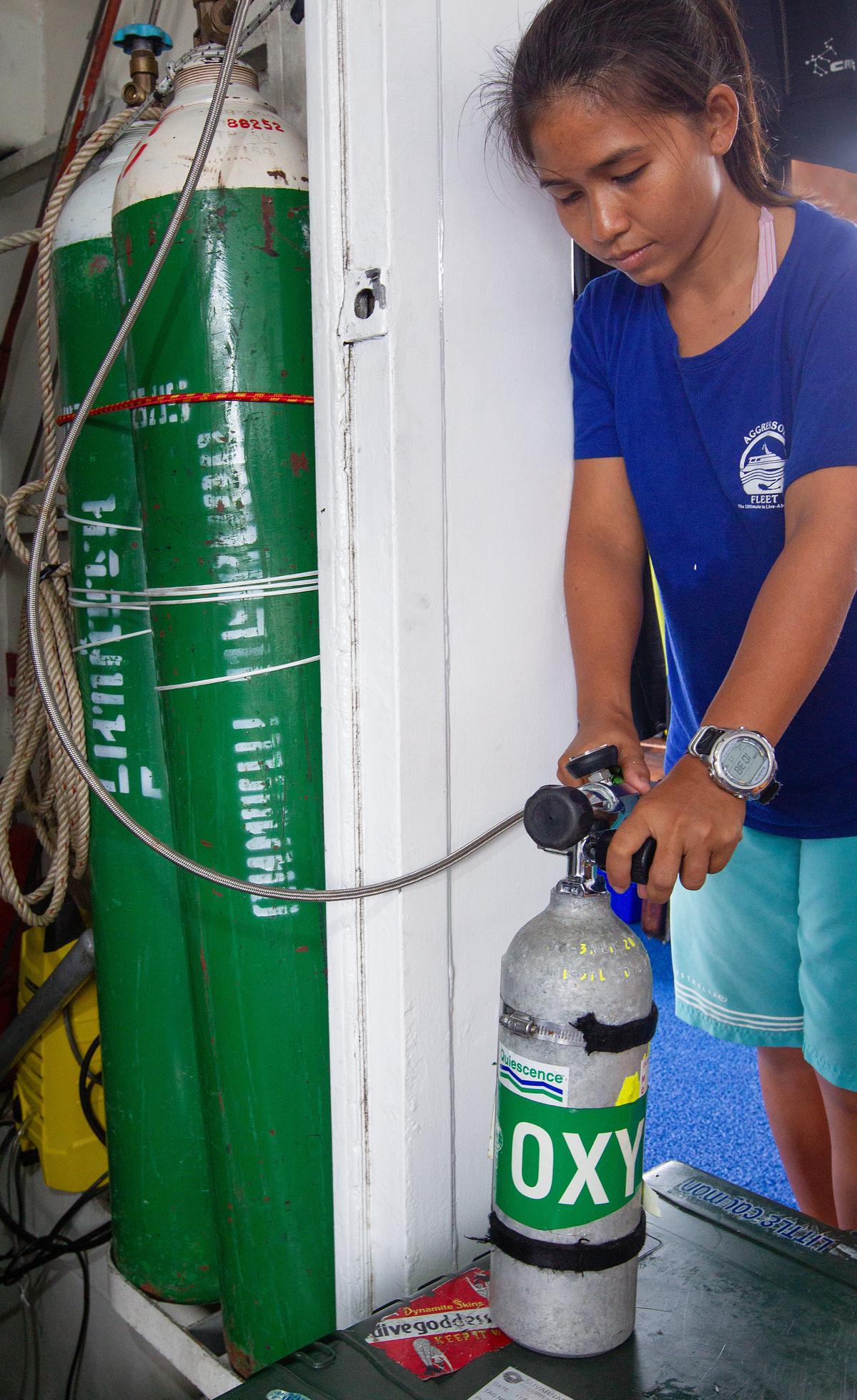
Initial inspection to determine whether it can be cleaned and how
Initial mechanical cleaning to remove any visible dirt or contamination, followed by degreasing using a cleaning agent suitable for oxygen service
Flush using clean, potable water to remove all cleaning agent residue.
Dry using oxygen-compatible air or other gas, which must be oil-free
Final inspection for any remaining surface contamination, which can include any or all of the following: Use a bright white or UV light in a darkened inspection area, use a fine water spray on the components and look for instant beading, or wipe the cleaned area with a clean, lint-free, white cloth and inspect the fabric with a white or UV light (this works well for cavities and hard-to-view surfaces)
Preserve the cleaning by immediately packaging or otherwise protecting the components from contamination
Document the process in writing and issue documentation for each item cleaned with a certificate, report, or sticker recording the technician, date, cleaning agents, and inspection methods
Only properly trained, competent technicians should perform oxygen cleaning Some industries require laboratory validation of cleanliness, but this is not usually the case in diving, as a welldesigned process will effectively remove any readily flammable contaminants
No amount of cleaning and inspection can guarantee completely safe equipment. However, as we saw in the first part of this series, fires occur infrequently and somewhat unpredictably Proper oxygen cleaning can help ensure there is no combustible fuel and increase confidence in your safety.

DAN Emergency Services received a call via satellite phone from a liveaboard anchored off a remote island in the Galápagos. A DAN member was concerned about their bunkmate exhibiting symptoms following the day’s dive activities. The diver had completed four dives that day. Although she began to show signs following the second dive, the inexperienced diver wrote off her symptoms, did not seek help, and continued diving
There were no significant events on any of the simple, recreational dives Still, there was a current on the surface, and the diver assumed her shoulder pain was from the exertion required to get back to the boat The diver denied shortness of breath, breath holds, and buoyancy or equalisation issues.
Her dive buddy was the divemaster, who told her on the fourth dive to surface without completing the decompression obligation on the diver’s computer According to information provided to DAN, the divemaster’s computer had different decompression obligations
The diver had a total of 40lifetime dives and was completing an advanced open-water certification She was using rented equipment and was not familiar with the dive computer.
When DAN medics received the call, the diver complained of pain under her left breast and in her left shoulder, numbness in her right leg, a brief loss of consciousness, nausea, and cutis marmorata (skin marbling) on her

abdomen, back, and legs. Both the diver and the crew, however, seemed unconcerned
DAN medics quickly realized that the situation might be dire. The symptoms and time frame fit the suspected decompression sickness (DCS) profile The signs and the missed 18-minute decompression obligation meant that the situation was serious and needed a quick response
DAN recommended that the crew immediately activate their emergency action plan (EAP) and get the diver to definitive care. They started surface-level oxygen, but the vessel’s remote location meant they were roughly 18 to 20 hours from the closest medical facility.
A speedboat was dispatched from the mainland to rendezvous with the vessel en route. However, the speedboat’s trip out would still take five hours, with another five hours to return to port and make the transfer to local emergency services
While rescue operations were underway, the diver’s condition continued to deteriorate Her symptoms worsened, and she was in and out of consciousness. When conscious, she was in severe pain. The diver was numb in both legs and unable to urinate Her vision became severely affected With time becoming an increasingly important factor, the Ecuadorian Navy dispatched a helicopter to expedite the trip
DAN medics were in contact with the receiving physician, and the diver arrived at the facility in bad shape She was disoriented, in hypovolemic shock, and had skin lesions and signs of spinal cord and brain injury Luckily, she gradually improved with treatment
Some divers may erroneously consider these normal recreational dives, but these profiles are aggressive. Four dives in one day are a lot for anyone, and these dives are deep. Not completing decompression contributed to this serious DCS event
Following your dive computer’s recommendation doesn’t mean that you are safe and that any DCS while diving within parameters is undeserved A dive computer is only a guide, not a wonder device that can measure inert gas loading in an individual We are all physiologically different, and many factors contribute to DCS Your dive computer can only try to quantify inert gas loading based on theoretical science. What works for some individuals does not work for others, and there is a risk every time we get in the water. In this case, the diver also ignored DCS symptoms after her second dive and did not follow the dive computer’s recommended decompression
There are many takeaways from this incident. For starters, never write off symptoms that manifest after diving If you dive with a computer, follow its recommendations and warnings. Know the difference between no decompression limit (NDL) and decompression diving, and don’t miss your decompression obligation
Inert gas loading occurs because of depth and time The longer we spend at depth, the more inert gas we accumulate While a dive computer is a useful tracking tool, it doesn’t know anything about your overall health, the dive conditions, or any other factors that affect decompression stress The closer you get to the NDL, the more inert gas builds up in your tissues, and that increased exposure also increases your DCS risk More conservative dive planning is the only way to mitigate that risk
81 feet, 54 minutes, 30 percent enriched air nitrox (EAN), safety stop completed, surface interval of 1.5 hours
87 feet, 50 minutes, 30 percent EAN, safety stop completed, surface interval of 1 5 hours
Her dive profiles for the day were the following: 1 2. 3.
89 feet, 54 minutes, 30 percent EAN, safety stop completed, surface interval of 1 5 hours
78 feet, 57 minutes, 30 percent EAN, safety stop completed, 18-minute decompression obligation not completed
If you are renting a dive computer or are unfamiliar with the one you are using, do your research Many user manuals are available online from the manufacturer. Read the manual and know how to use your computer, as you should with all your dive equipment If you have questions, ensure you get the answers before diving. Never rely on your friend’s dive computer. Each diver should follow their own computer
A comprehensive refresher course can help you better understand the importance of decompression and how the dive computer
plays an essential role in determining your critical safety stops. Knowing the basics of recognizing and treating DCS is essential, particularly before diving aggressively in a remote location with little or no medical support Whether a lack of knowledge or other factors contributed to this diver’s denial, ignoring symptoms can turn a mild injury that is easy to manage onsite into a severe episode that requires an emergency response and can result in paralysis or death That kind of situation impacts the diver, everyone on the dive boat, and everyone involved in a potentially hazardous, remote rescue
Always know what you are getting into, especially with a favourite but remote dive

DAN has been an invaluable resource to our family living and working remotely in Mozambique, and of course diving regularly. I experienced a diving-related complication during lockdown (fortunately not serious or lifethreatening) and DAN were phenomenal in offering advice and following up regularly on my condition. This service is excellent value for money and no diver should be without it.
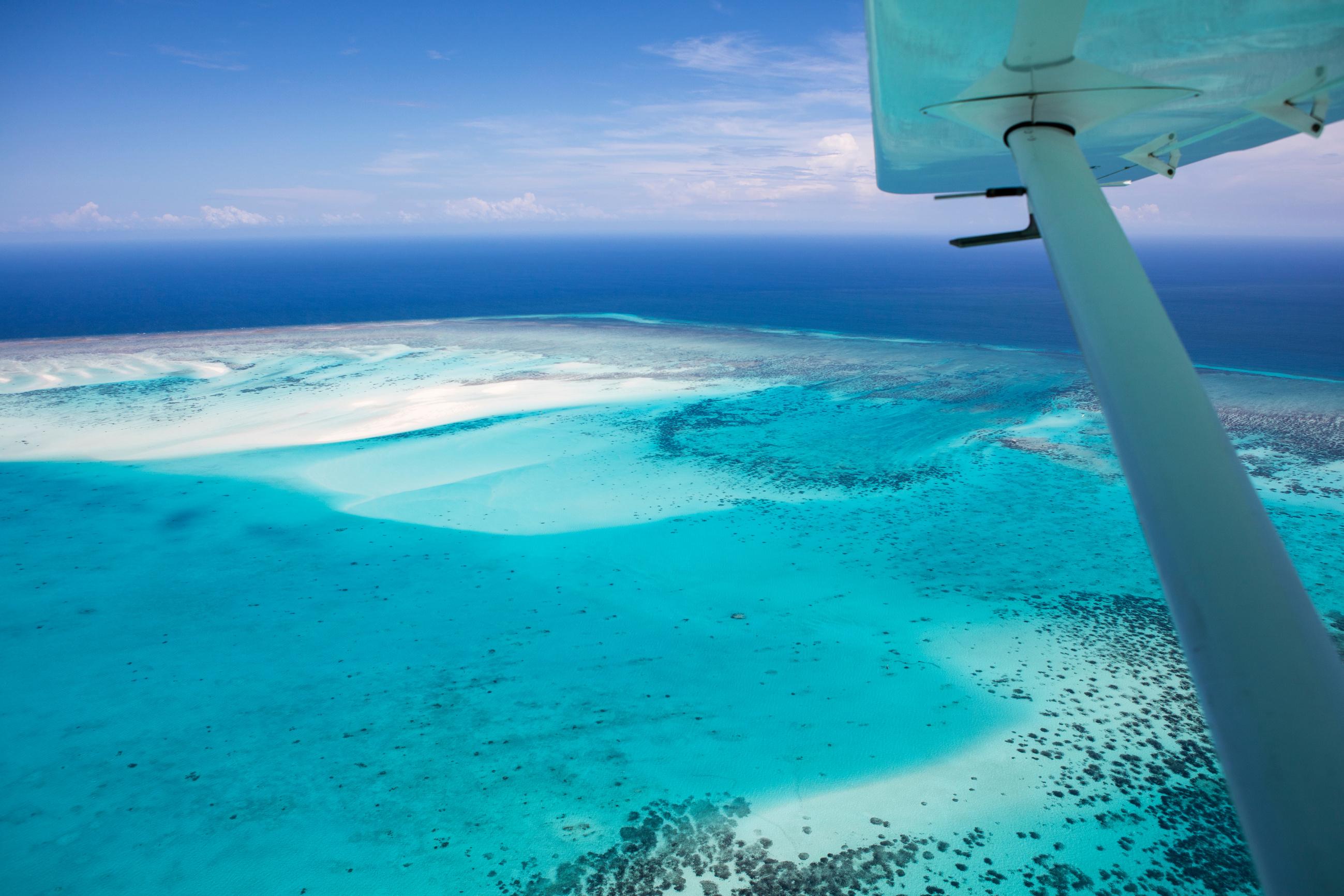













Whale shark - this whale shark was identified using spot pattern records by shark scientist Dr Simon Pierce of the marine megafauna foundation in Tofo, Mozambique With such crystal clear water, the sun's rays and swimmer following along give a stunning image and relative scale to this gentle giant. Photographed on breath-hold with Nikon D300 with 10,5mm fisheye lens in a Sea&Sea housing using natural light.
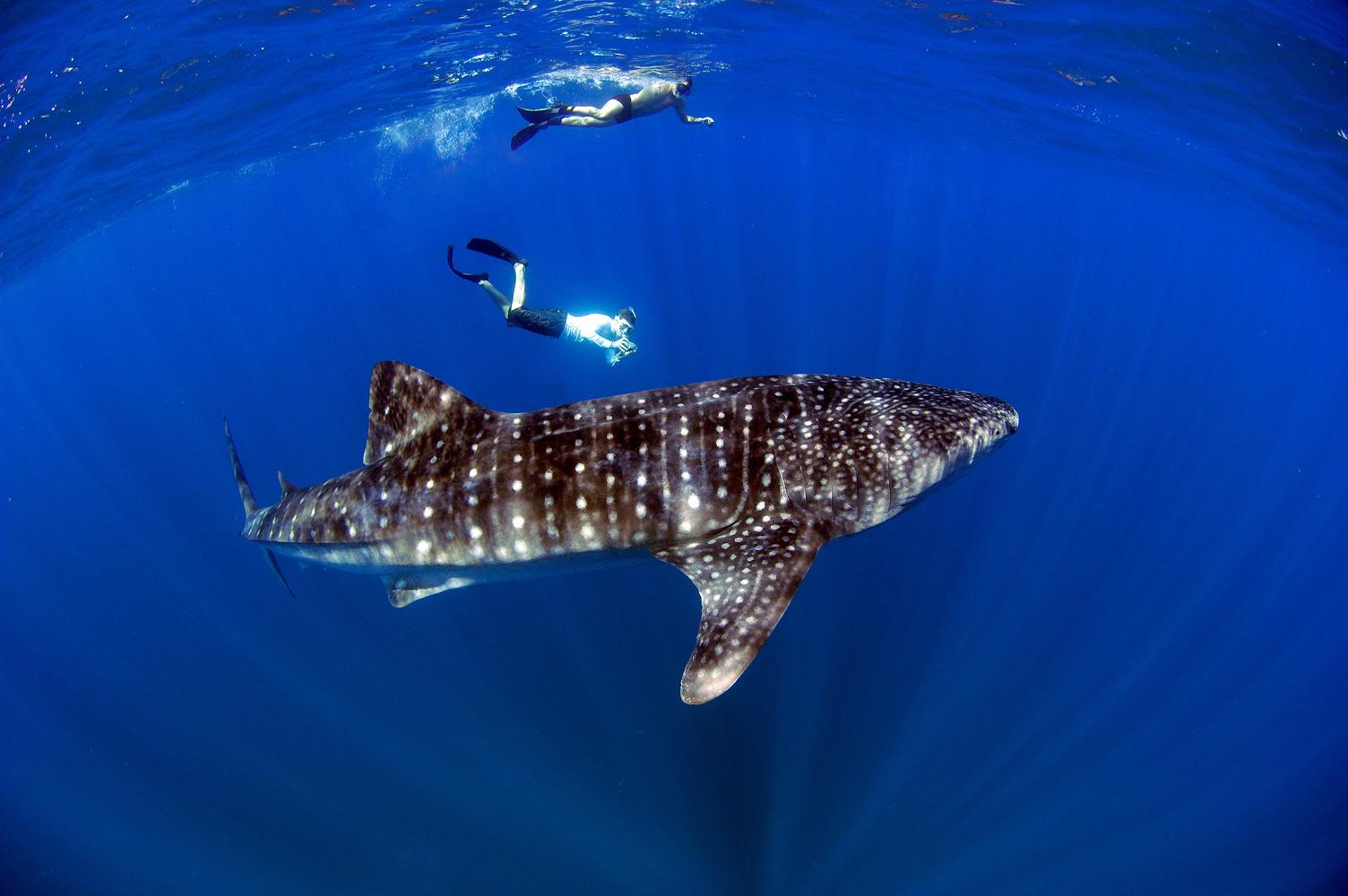

All diving emergencies
Non-diving medical emergencies
Diving medical information, such as fitness to dive, medication, and travel medical advice and enquiries
Travel notifications and advice
Diving medical examiner contact details
International medical centres or doctors who want to confirm DAN memberships
The caller and/or patient’s name and contact number
The nature of the emergency
The patient’s DAN membership number, if applicable or known
The patient’s medical aid information, if the incident occurred within South Africa
The patient’s travel insurance information, if applicable
If the caller is not at the scene, at least one local contact number should be provided in order to reach the person that is in need of assistance, or those who are in charge of their care.
DAN makes a conference call to one of the on-call diving medical officers (DMOs) when an emergency call is received and the nature of the event has been established The DMO will provide specialist diving medical advice regarding how and what should be done immediately and will also make decisions concerning the further management of each case, depending on the situation.
Aeromedical resources, such as helicopters and air ambulances, cannot be dispatched unless authorised by the DMO. It may take longer to activate an air ambulance than it would take to mobilise emergency medical services via a ground ambulance Several factors, aside from costs, will determine aeromedical evacuation
The DAN hotline provides emergency medical assistance to injured divers. We encourage you to call early, even when you are uncertain, rather than wait until the situation has become critical as the opportunity to assist becomes more restricted
Is an air ambulance or a helicopter available?
How urgently does the patient need advanced life support and should they be moved to intensive care?
What are the optimal logistical considerations for efficiently and safely moving the patient to a place where they can receive medical assessment and appropriate medical care, with appropriate medical support, during the transfer?
Are these appropriate for a helicopter or a fixed-wing air ambulance? Are these open, particularly at night? What are the customs or immigration requirements? What are the implications of getting the patient to the landing zone or airport, or the crew to the patient?

DAN members have a passion for the water, a quest for knowledge and love of community So be part of something bigger. Join nearly 500,000 divers worldwide and experience valuable benefits to make you a safer, smarter diver.




